

Paul’s Missionary Journeys: The Beginner’s Guide
by Ryan Nelson | Jul 6, 2020 | Bible topics
Paul’s missionary journeys helped spread the gospel throughout much of the ancient world. Over the course of his ministry, the Apostle Paul traveled more than 10,000 miles and established at least 14 churches.
The Book of Acts records three separate missionary journeys that took Paul through Greece, Turkey, Syria, and numerous regions you won’t find on modern-day maps. Some scholars argue that Paul also took a fourth missionary journey, since parts of the New Testament appear to reference travels that may have taken place after the events in Acts.
Paul’s travels played a crucial role in the formation and development of the early Christian church. Many of the communities he encountered on these missionary journeys were the same ones he wrote to in his pastoral epistles.
In this guide, we’re going to follow Paul’s footsteps as he travelled across the ancient world, looking at the places he went and the major events that took place along the way. At times it can be challenging to distinguish between ancient cities, provinces, and regions (and there are sometimes multiple names that refer to the same area), so as we go, we’ll make some of those distinctions more clear.
Paul’s first missionary journey (Acts 13–14)
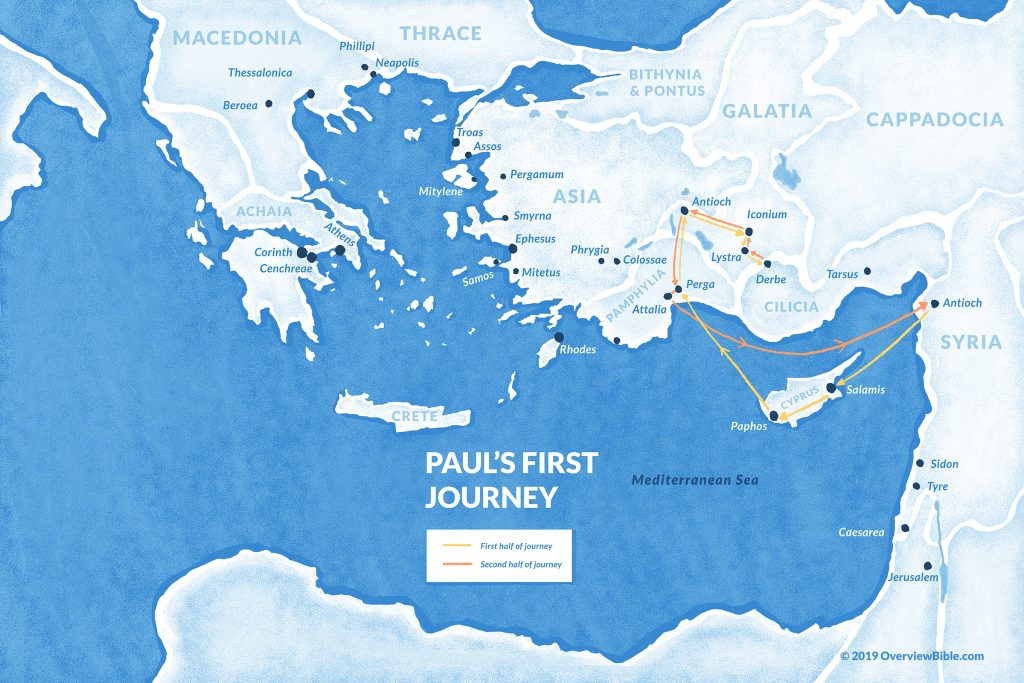
Paul’s first missionary journey began in Antioch. You may notice that maps of the ancient world often have two cities labelled Antioch. They’re both named after Antiochus, father of Seleucid I. The Antioch in Acts 13 was the third largest city in ancient Rome and capital of the province of Syria. Today, it’s part of southern Turkey. The other Antioch was part of Pisidia, an ancient region which is also now part of Turkey. Your Bible likely refers to it as Pisidian Antioch or Antioch of Pisidia.
In Antioch (the big city in Syria), the Holy Spirit singled out Paul and Barnabas from the believers worshiping there, and sent them on their first missionary journey.
Paul’s first journey took him by boat to the Roman province of Cyprus. Today, Cyprus is a country known as the Republic of Cyprus. It’s a mediterranean island south of Syria. Paul and Barnabas arrived in the port city of Salamis, where John Mark (who was possibly Barnabas’ cousin), helped them share the gospel in Jewish synagogues.
From Salamis, the group moved across the island to Paphos, where they were met by a Jewish sorcerer named Bar-Jesus (also known as Elymas the sorcerer). This sorcerer worked for the governor—Sergius Paulus—who sent for Paul and his companions because he wanted to hear the word of God. Elymas opposed them and tried to turn Sergius from the faith, and so Paul, filled with the Holy Spirit, called him a “child of the devil” and struck him blind. Sergius saw what happened, and believed.
Ironically, Elymas meant to steer Sergius away from Christ, but he became the very vehicle God used to draw Sergius toward him.
From Paphos, Paul and company set sail for the Roman province of Pamphylia, located in modern day Turkey. They arrived in the city of Perga, where John Mark left them and returned to Jerusalem (which, interestingly, was in the opposite direction from where they just came). We don’t know why John Mark decided to leave, but this would later create a rift between Paul and Barnabas.
Together, Paul and Barnabas travelled to Pisidian Antioch, where local synagogue leaders invited them to speak. Initially, the Jewish people were receptive to the gospel, but a week later, the entire city gathered to hear Paul and Barnabas, and the Jewish leaders became jealous. They resisted the message of the gospel, and so Paul and Barnabas made an important pivot: they began preaching to the Gentiles.
Many of the Gentiles believed the gospel, and Luke (the traditional author of Acts) tells us that:
“The word of the Lord spread through the whole region. But the Jewish leaders incited the God-fearing women of high standing and the leading men of the city. They stirred up persecution against Paul and Barnabas, and expelled them from their region.” —Acts 13:49–50
Driven out of Pamphylia, Paul and Barnabas travelled to Iconium, an eastern city in the region of Phrygia. Iconium still exists today as the Turkish city of Konya.
Once again, Paul and Barnabas spoke in the synagogue, where Jews and Greeks alike accepted the gospel. But the Jews who didn’t accept it stirred up trouble, even as Paul and Barnabas began performing signs and wonders (Acts 14:3). As support for Paul and Barnabas grew, so did the opposition they faced, and eventually, they became aware of a plot to abuse and stone them. So they left.
Fleeing the threat in Iconium, Paul and Barnabas left Phrygia altogether and travelled to Lystra, a city in the province of Lycaonia. Here, Paul healed a man who was lame.The locals who witnessed this miracle thought Paul and Barnabas were gods in human form, calling Barnabas Zeus and Paul Hermes. The priest from the temple of Zeus brought bulls and wreaths to offer sacrifices to them.
Paul and Barnabas attempted to redirect their praise to God, but struggled to keep the crowds from offering sacrifices to them.
Jews came from Antioch and Iconium and continued what they’d started. They riled up the crowds and convinced them to stone Paul. Believing he was dead, they dragged him outside the city. When the disciples gathered around him, Paul got up and went back inside the city.
Then Paul and Barnabas went to Derbe, another city in Lycaonia. There, they “won a large number of disciples” (Acts 14:21).
The return to Antioch
After a time in Derbes, Paul and Barnabas went back the way they came, working their way through Lystra, Iconium, Pisidian Antioch, and Perga. In each city, they encouraged the believers there and strengthened their faith, as they would continue doing on their future missionary journeys. They did, however, stop in a new Pamphylian city on the way: Attalia. Acts only mentions it in passing, but presumably, they established a community of believers there as well.
From there, they skipped a return voyage to the island of Cyprus and went straight back to Antioch (the big one), where they told the church what happened on their journey.
Paul’s second missionary journey (Acts 16:23–20:38)
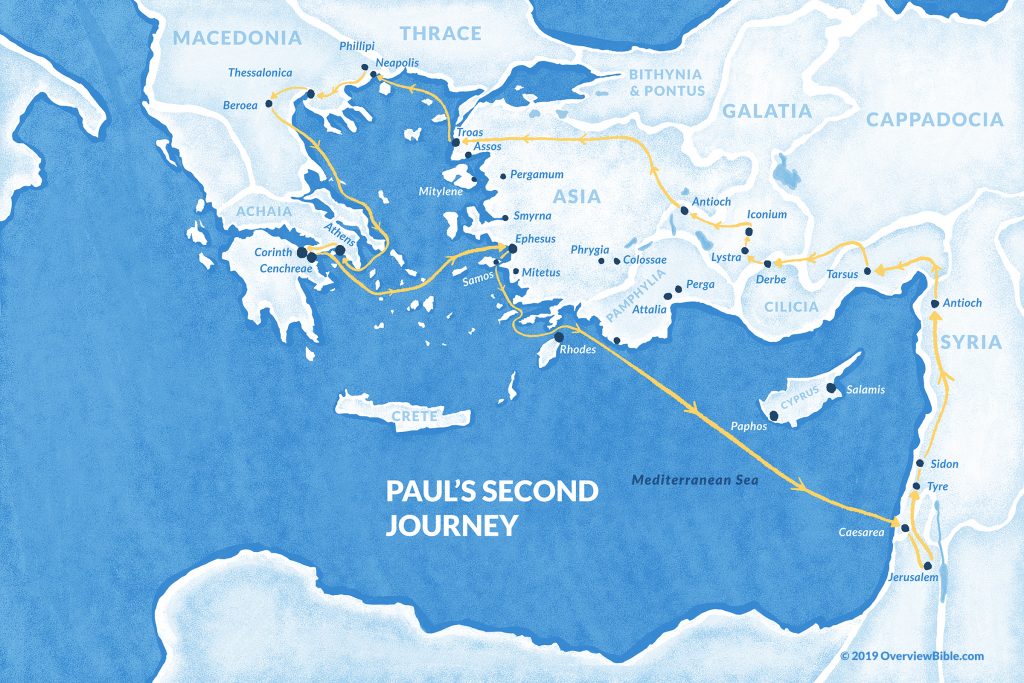
Paul’s second missionary journey established many of the churches he would later write to in his pastoral epistles. Interestingly, this may have happened in part because of a “sharp disagreement” he had with Barnabas. Paul’s original plan was to essentially have a rerun of their first trip, strengthening the communities they’d formed in each city and telling them what the Council of Jerusalem had ruled in regards to Gentile believers.
But Barnabas wanted to take John Mark—who had left them shortly into their previous journey. Paul was so opposed to the idea that they parted ways, initiating two separate missionary journeys. Barnabas took John Mark and went with the original plan, making their way back to the island of Cyprus. Paul took a man named Silas and travelled through the provinces of Syria and Cilicia.
The first cities that Acts mentions by name on Paul’s second journey are Derbe and Lystra. At this time, Paul and Silas picked up a new companion: Timothy.
The locals spoke highly of Timothy, and Paul wanted to bring him along even though he was half Greek, which meant local Jews would have a harder time accepting their message. Out of concern for these local Jews, Paul circumcised Timothy—even though, ironically, one of the things they were coming to tell Christians was that Gentiles didn’t have to be circumcised. (See Acts 16:3–4.)
Acts doesn’t specify where in Phrygia Paul and his companions stopped, but since he’d established a church in Iconium on the first trip, that community would’ve been on his mind (even though last time he was there, people had plotted to stone him). Interestingly, Acts notes that Paul and his companions journeyed here after they were “kept by the Holy Spirit from preaching the word in the province of Asia” (Acts 16:6).
Just north of Phrygia was the province of Galatia. Acts makes no mention of what happened here, but this is the province Paul wrote to in his letter to the Galatians . Interestingly, part of the purpose of Paul’s second trip was to share the news from the Council of Jerusalem regarding the Law of Moses and whether or not Gentiles (or Christians in general) should be expected to follow it. The council decided the Torah didn’t apply to Gentile believers (though they did hang on to a few rules). But by the time Paul wrote the Book of Galatians, Christians there were feeling pressure to obey the law (particularly in regards to circumcision) in order to be saved.
From Galatia, Paul’s group traveled west, until they reached the border of Mysia—a western region in the province of Asia, which is now part of Turkey. They intended to head north to the region of Bithynia, “but the spirit of Jesus would not allow them to” (Acts 16:7). So they passed by Mysia and headed to the city of Troas. Here, Paul had a vision of a man in Macedonia, begging him to “Come over to Macedonia and help us.” Paul took this vision as a sign that God was calling them to Macedonia, which was across the Aegean Sea.
From Troas, Paul and his companions sailed across the Aegean Sea, making a pitstop on the island of Samothrace before landing in Neapolis and then traveling to Philippi. In Philippi, they spoke with women outside the city gate. One of them was a wealthy cloth dealer named Lydia. After her household was baptised, she persuaded Paul’s group to stay with her for a while.
Later, Paul, Silas, and the others were confronted by a spirit-possessed slave woman who could predict the future. She followed them for many days, shouting, “These men are servants of the Most High God, who are telling you the way to be saved” (Acts 16:17). Paul became so annoyed that he cast out the spirit. Her owners were furious, because they had been profiting off of her fortune telling. So they turned the local magistrates against them, claiming Paul and Silas were stirring up trouble and trying to get Roman citizens to believe and do illegal things.
The authorities had Paul and Silas severely flogged and thrown in prison. Late at night, while they were worshiping, an earthquake shook the foundations of the prison, opened the doors, and freed the prisoners from their chains. When the jailer awoke and saw the doors open, he prepared to kill himself. But Paul stopped him and assured him everyone was still in the prison.
After listening to Paul and Silas share the gospel, the jailer believed in Jesus and had his whole household baptized.
The next morning, the magistrates ordered Paul and Silas released. Paul revealed that they were Roman citizens, who had just been beaten and imprisoned without trial, and the authorities became afraid. Paul and Silas returned to Lydia’s house, and then left the city of Troas.
After passing through the Macedonian cities of Amphipolis and Apollonia, they arrived in Thessalonica. Since Thessalonica had a synagogue, Paul turned to his usual method—preaching the gospel on the Sabbath. Over the course of three weeks, he achieved the usual result—many Jews and Greeks alike embraced the gospel . . . and those who didn’t were outraged by it.
At night, the Thessalonian believers sent Paul and his companions away to the nearby city of Berea.
The Bereans listened eagerly to the gospel and carefully examined the Scriptures to see if they supported Paul’s claims. Many Jews and Greeks became believers, but some agitators from Thessalonica heard Paul was in Berea, and they stirred up the crowds. Silas and Timothy stayed in Berea, while Paul was escorted out of Macedonia to Athens.
In the first century, Athens was in the region of Achaia, just south of Macedonia. Today, it’s the capital of Greece, and the largest city in the country.
Paul was essentially waiting around for Silas, Timothy, and the others to rejoin him. But while he waited, he noticed that Athens was full of idols. He debated with philosophers in both the synagogue and marketplace. Some Athenians were open to his ideas, and they were eager to discuss them. One idol in particular caught his eye—it had an inscription that read: “to an unknown god.” He seized on this as an opportunity to tell them about the “unknown God” who died and rose so that all might have eternal life.
Paul’s message in Athens incorporated observations about what he saw around him as well as quotes from famous Greek philosophers to point back to the gospel. After establishing a group of believers in Athens, Paul headed west to the city of Corinth.
In Corinth, Paul stayed and worked with a couple of Jewish tentmakers named Priscilla and Aquila. Every Sabbath, he preached to Jews and Greeks in the synagogue. Silas and Timothy rejoined Paul here, and Paul began focusing his energy on testifying about Jesus to the Jews.
When the Jews opposed his message, Paul devoted himself to reaching Gentiles, and he left the synagogue. As more Greeks embraced the gospel, the Corinthian Jews brought Paul before the governor, who basically told them to take a hike and refused to help.
Paul stayed in Corinth for a year and a half, and he left with Priscilla and Aquila.
The return journey
Before setting off for Syria, Paul stopped for a vow-fulfilling haircut in the port city of Cenchreae, which was just a hop, skip, and a jump from Corinth. With his companions, he sailed across the Aegean Sea to Ephesus, where he dropped of Priscilla and Aquila, and promised to come back if he could. After a short stay in Ephesus, Paul set sail for Caesarea, which was across the Mediterranean and far to the southeast. From there, he made the trek south to Jerusalem.
Paul’s second missionary journey ended in Jerusalem.
Paul’s third missionary journey (Acts 18:23–20:38)
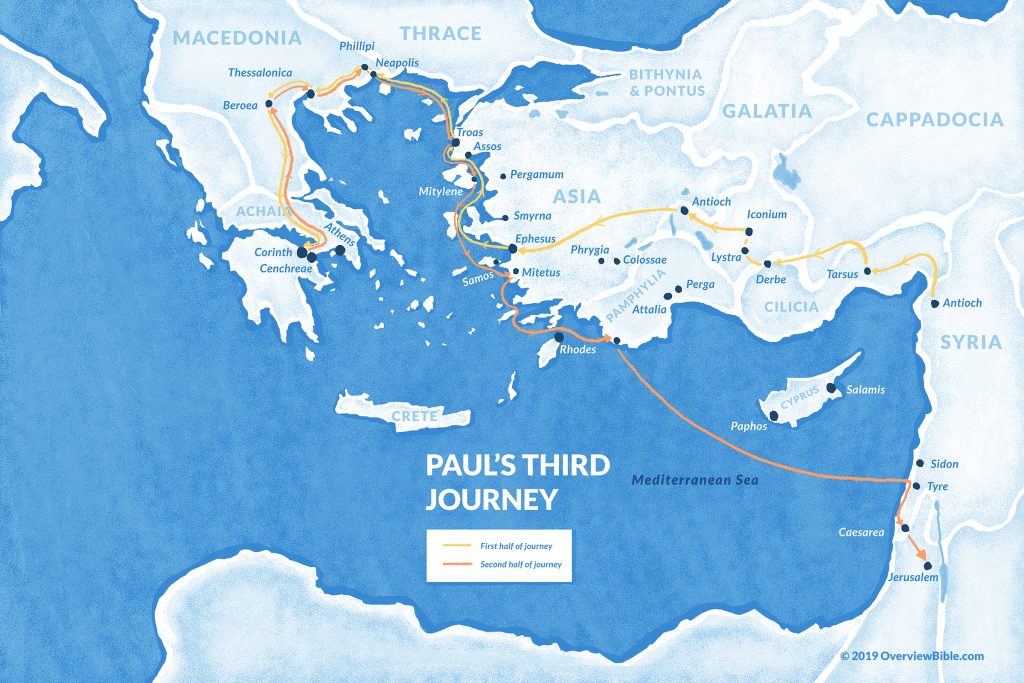
When you read Acts, there’s no transition from Paul’s second missionary journey to his third. His arrival in Jerusalem almost immediately began his next trip. But while his second journey ends in Jerusalem, the beginning of his third journey is actually in Antioch, which is about 300 miles north.
Phrygia and Galatia
From Antioch, Paul once again worked his way west, passing “from place to place throughout the region of Galatia and Phrygia, strengthening all the disciples” (Acts 18:23). This included Derbe, Lystra, and Iconium.
Paul traveled west to Ephesus, the capital of the province of Asia, where he’d left Priscilla and Aquila on his previous journey. Since he’d last visited, a man named Apollos had been preaching part of the gospel, but he didn’t know about the Holy Spirit. So when Paul arrived, he taught the Ephesians about the difference between water baptism and the baptism of the Spirit.
For three months, Paul preached in the synagogues. When people started criticizing Christianity, he left and began holding discussions in a lecture hall.
This went on for two years, and all the while, God used Paul to perform miracles. Even things Paul had touched—handkerchiefs and aprons—healed the sick and drove out evil spirits.
Some Jews thought invoking Paul’s name would let them drive out demons. Seven sons of a chief priest named Sceva said to an evil spirit, “In the name of the Jesus whom Paul preaches, I command you to come out” (Acts 19:13). The spirit replied that it knew Jesus and Paul, but not them, and then it pulverized all seven of them.
As word spread about what happened, people began to revere the name of Jesus. Local sorcerors came to repent, and they burnt scrolls that would have been worth more than 130 years’ worth of wages (Acts 19:19).
Around this time, a local silversmith named Demetrius realized that the future of his business (making idols) was jeopardized by the gospel. The demand for idols was going down all across the province of Asia, but especially in Ephesus, where he lived. So Demetrius gathered all the craftsmen and workers whose businesses were impacted, and stirred the entire city into an uproar. They seized two of Paul’s companions and brought them into a theater.
Paul wanted to address the crowd, but the disciples didn’t let him. Instead, a city clerk told everyone that unless they were going to bring formal charges against the men in a legal assembly, they were in danger of being charged with rioting.
Macedonia and Greece
After things settled down in Ephesus, Paul headed across the Aegean Sea to Macedonia. He traveled throughout the region, encouraging believers, and eventually arrived in Greece, where he stayed for three months. He intended to sail back to Syria (where his journey started), but some people plotted against him, so he took another lap through Macedonia instead.
Along the way, disciples joined Paul from many of the communities he’d ministered to. He had companions from Berea, Thessalonica, Derbe, and the province of Asia. These followers went ahead of Paul to Troas, in Asia. Paul stayed briefly in Philippi, then joined them.
Paul stayed in Troas for seven days. The night before he left, he stayed up late talking in a room upstairs. A young man sat in a window, drifted off to sleep, and fell to his death. Paul threw his arms around the man and declared that he was alive, and he was. Then Paul went back upstairs and continued talking until daylight.
Paul walked from Troas to Assos, which was just to the south, and then sailed for the nearby city of Mitylene. Eager to reach Jerusalem before Pentecost, Paul sailed past Ephesus and stopped in Miletus. There, he met with the leaders of the Ephesian church and essentially told them that he had taught them everything they needed to know, that he would not see them again, and that they needed to be on guard against false teachers. This is when Paul also famously quoted Jesus, sharing words that aren’t recorded in any of the gospels: “It is more blessed to give than to receive” (Acts 20:35).
And then he set sail.
Paul and his companions stopped briefly in Kos, Rhodes, and Patara before heading across the Mediterranean Sea to Phoenicia (the coastal region south of ancient Syria, which is now part of Syria). They arrived in Tyre, where “through the Spirit” (Acts 21:4), the local disciples urged Paul not to go to Jerusalem. He ignored them.
From Tyre, the voyage continued to the port city of Ptolemais, and then Caesarea, where the group stayed with Philip the evangelist (not to be confused with Philip the apostle ). Here, a prophet warned Paul that he would be bound by the Jews in Jerusalem and handed over to the Gentiles.
Still, he pressed on to Jerusalem, and by the end of Acts, the Jewish leaders had handed him over to Roman rulers.
Paul’s fourth missionary journey
Acts explicitly records three distinct missionary journeys. But some scholars and even ancient Christian writers have claimed that there was also a fourth missionary journey which was only hinted at in the Bible.
The argument for a fourth journey is primarily based on clues from Paul’s letters. He occasionally refers to events and visits that may not be accounted for in Acts or the epistles.
For example, Paul suggested he would travel to Spain (Romans 15:24), but he provides no record of this journey in his letters. However, early church fathers claimed Paul did, in fact, travel to Spain.
In his letter to the Corinthians, first-century church father Clement of Rome said Paul “had gone to the extremity of the west,” which at the time presumably meant Spain. Fourth-century church father John of Chrysostom said, “For after he had been in Rome, he returned to Spain, but whether he came thence again into these parts, we know not.” And Cyril of Jerusalem (also from the fourth century) wrote that Paul “carried the earnestness of his preaching as far as Spain.”
In 2 Timothy 4, Paul makes an ambiguous reference to “my first defense” and claims he was “delivered from the lion’s mouth” (2 Timothy 4:16-17). Some have interpreted this as a reference to his first defense before Emperor Nero, which he was heading for at the end of Acts.
Paul’s letters make other references to events not recorded in Acts, but since there is so much overlap in the locations mentioned, and Paul spent multiple years in some of these places on his three recorded journeys, it’s difficult to say whether or not this fourth journey ever actually happened.
Take a closer look at Paul’s footsteps
Paul’s missionary journeys are a key part of the New Testament. Paul’s epistles were originally written to the communities he formed on these journeys, and they show us exactly how Christianity spread to the Gentiles so rapidly.
Here at OverviewBible, we’ve charted each of Paul’s missionary journeys into beautiful, full-color posters you can display in your classroom or church office. Each comes in multiple sizes on fine art paper with a matte finish.

Get an overview of the entire Bible
The Bible is huge. Together, its 66 books are three times longer than Moby Dick . It’s so big that even if you’ve been reading it your whole life, you can still miss the point. Jeffrey Kranz, founder of OverviewBible, wrote The Beginner’s Guide to the Bible to help Christians and non-Christians alike get a better grasp of this important text.
This non-preachy, jargon-free guide will walk you through the Bible’s major themes and characters and help you see how each book fits into the larger story of Scripture.
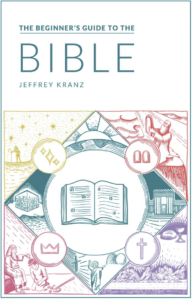
Explore the Bible with us!
We create research-based articles and handy infographics to help people understand the Bible.
Join our email list, and we’ll send you some of our best free resources—plus we’ll tell you whenever we make something new.
You have Successfully Subscribed!

- Bible Books
- Bible characters
- Bible facts
- Bible materials
- Bible topics
Recent Posts
- Interesting Facts about the Bible
- Logos Bible Software 10 review: Do you REALLY need it?
- Who Was Herod? Wait… There Were How Many Herods?!
- 16 Facts About King David
- Moses: The Old Testament’s Greatest Prophet

Privacy Overview

Paul’s Four Missionary Journeys: The Complete Guide
God did many amazing things through the life and ministry of the apostle Paul. The gospel was spread to many people across the known world thanks to Paul’s efforts, despite the severe opposition and persecution Paul faced.
What were Paul’s missionary journeys? Paul took four missionary journeys. Paul’s first three missionary journeys are recorded in the book of Acts. The fourth is alluded to in Paul’s letters. On the first missionary journey Paul went through Cyrus, Pamphylia, and Galatia. On his second missionary journey he went through Galatia, Macedonia, and Achaia. Paul’s third journey took him through Galatia, Asia, Macedonia, Achaia, and ended in Jerusalem. After his third missionary journey Paul was imprisoned in Caesarea for two years and later transported to Rome where he was then placed under house arrest for another two years. His fourth missionary journey is not clear, but it may have included Spain, Crete, Asia, Achaia, and Macedonia.
By looking at Paul’s missionary journeys we can look and reflect on the beginning of the fulfillment of God’s command to “Go therefore and make disciples of all nations” (Matthew 28:19).
Timeline of Paul’s Missionary Journeys
- A.D. 37: Converted on the road to Damascus
- A.D. 37-40: Spends three years in Arabia
- A.D. 40: Brief visit to Jerusalem to meet with the apostle Peter
- A.D. 40-44: Preaches and ministers in Tarsus and surrounding regions
- A.D. 44 or 45: Relocates to Antioch in Syria
- A.D. 45 or 46: Travels with Barnabas to visit Jerusalem, brings a famine relief offering
- A.D. 46 or 47: First missionary journey with Barnabas, likely lasts 1-2 years
- A.D. 50: Attends the Jerusalem Council
- A.D. 51: Leaves on second missionary journey, trip lasts 2.5 to 3 years, including 18 months in Corinth
- A.D. 54: Leaves on third missionary journey, trip lasts more than 4 years, including 3 years in Ephesus
- A.D. 58: Arrested in Jerusalem, put on trial before the Roman governor Felix
- A.D. 58-60: Held in Caesarea for two years
- A.D. 60: Put back on trial by Festus the new Roman governor; eventually transported to Rome
- A.D. 61: Arrives in Rome
- A.D. 61-63: Placed under house arrest for two years
- A.D. 63: Released from house arrest, likely launches his fourth missionary journey
- A.D. 66 or 67: Imprisoned in Rome again
- A.D. 67 or 68: Martyred under Nero’s persecution
*Dates are approximate.
Paul’s Background
Before he was known as the apostle Paul, he was first known as Saul of Tarsus. He was a brilliant, pious, zealous, and well-educated Pharisee, from a wealthy and well-connected family. Saul was obviously intimately acquainted with the Hebrew Scriptures, but was also thoroughly acquainted with Greco-Roman history, language, and culture.
Saul became famous in Palestine because of his persecution of Christians. But things changed, dramatically. By God’s providence, Saul became a Christian after a supernatural encounter with Jesus on the road to Damascus (Acts 9).
After Saul’s conversion, he traveled to a few different places, over several years, including three years in Arabia (Gal. 1:17–18), a brief visit to Jerusalem (Gal. 1:18), and then several years of preaching in the regions of Syria and Cilicia (Gal. 1:21).
Partnership with Barnabas
After some heavy persecution of the Christians in Jerusalem, some believers ended up living in the city of Antioch. They preached the gospel there and a “great number” believed in Jesus (Acts 11:21). When the apostles in Jerusalem heard about this, they sent a man named Barnabas to Antioch to serve in the church there (Acts 11:22).
Barnabas was a prophet (Acts 13:1) and an apostle (Acts 14:14). Through his ministry a “great number of people were brought to the Lord” (Acts 11:24).
After being in Antioch a while, Barnabas traveled to Tarsus to find Saul. Barnabas recruited Saul to come teach and lead and serve in the church in Antioch in Syria (Acts 11:25-26). Saul relocated to Antioch sometime between 44 and 46 A.D. and served as one of the leaders of the church there.
Barnabas and Saul would become ministry traveling partners for the next few years, including at least one earlier trip to Jerusalem (Acts 11:27-30) in order to bring a famine relief offering to the Christians in Jerusalem (likely sometime between 45 and 46 A.D.).
First Missionary Journey
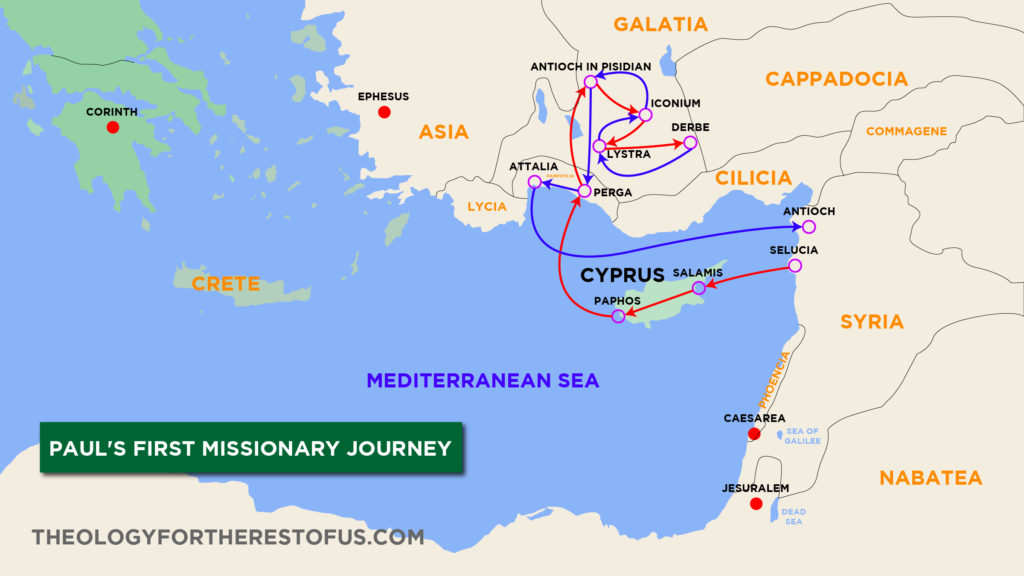
Barnabas and Saul sensed the call of the Holy Spirit to go out on their first missionary journey (Acts 13-14). Sometime around 46 A.D. (or 47 A.D.), Barnabas and Saul were set apart by the Holy Spirit and sent out on their first missionary journey by the church at Antioch.
Before Barnabas and Saul officially left on their first missionary journey, they recruited a young man named John Mark to go with them. John Mark was the son of a woman named Mary (mentioned in Acts 12:12). She owned the house where the Christians had been meeting and praying when Peter was miraculously delivered from jail by the angel.
It is likely that, as a young boy, John Mark had witnessed Jesus’ ministry first-hand. Sadly, however, during the missionary journey, John Mark would eventually abandon Barnabas and Saul. This would later lead to a significant dispute between Barnabas and Saul a few years in the future.
Barnabas and Saul sailed from Seleucia to the island of Cyprus, apx. 100 miles off the coast of Syria. They began by preaching to Jewish people in the synagogues of Salamis. The crew did ministry in several parts of the island until they got to Paphos (Acts 13:4-6).
During their ministry they faced significant opposition. One of their earliest opponents was a magician who was a Jewish false prophet. Saul performed a supernatural act that blinded this false prophet. These events led to the conversion of the Roman proconsul Sergius Paulus (Acts 13:6-12).
Saul Becomes Paul
After the events in Cyprus, the author of the book of Acts, Luke, begins to refer to Saul as Paul. Some Christians have asserted that Saul changed his name. However, it’s more likely that Saul and Paul were two different names for the same person all along; he was known by both names for many years.
After launching a Gentile-focused ministry, Paul would have been interacting with many Gentiles, and they would have likely preferred to refer to him by the Gentile name. It appears Luke sought to make this a point of emphasis. Scholar Greg Lanier says :
“When Saul Paul launches his Gentile-focused ministry among primarily Greek-speakers (beginning with Acts 13:9), it’s natural for Luke, the author of Acts, to begin referring exclusively to him by his Greek name. Nor is it surprising that he’s later referred to as ‘Paul’ in Jerusalem, since there were Greek speakers there too. Indeed, Luke could be making a thematic point by shifting from Saul to Paul around chapter 13, given the broader theme of Acts (e.g., 1:8). After all, the church’s nucleus is shifting from predominantly Jewish-centered Jerusalem to the Greek-centered ‘ends of the earth,’ such as Rome.”
Pamphylia and Galatia
Barnabas, Paul, and John Mark then traveled across the Mediterranean Sea to Perga in Pamphylia. This is where John Mark deserts Paul and Barnabas and heads back to Jerusalem (Acts 13:13).
From Perga, Paul and Barnabas then continued northward into the province of Galatia, coming to the city of Antioch in Pisidia (not to be confused with their home base city of Antioch in Syria).
Archaeologists have discovered an inscription containing the name ‘Sergius Paulus’ in the city of Antioch in Pisidia (he was the Roman proconsul that became a Christian back on the island of Cyprus). This is strong evidence that Sergius Paulus had family roots in Antioch in Pisidia. Some scholars have argued that he was the person that probably encouraged Barnabas and Paul to travel up to Antioch in Pisidia.
Once they arrived in Antioch in Pisidia, Paul went to the synagogue and preached about the good news of Jesus. Paul effectively preached in the synagogue for multiple weeks. This resulted in many people coming to faith in Jesus (Acts 13:14-44).
Unfortunately, Barnabas and Paul faced significant opposition there too. Part of the problem they faced was the jealousy of certain Jews. There were many Gentiles showing up to hear the gospel preached. Some Jews became jealous and started to contradict what Paul had to say. Since the Gentiles were more willing to hear what Paul had to say, he turned and preached to the Gentiles.
And when the Gentiles heard this, they began rejoicing and glorifying the word of the Lord, and as many as were appointed to eternal life believed. —Acts 13:48
The Gentiles’ response to the gospel was positive. The gospel continued to spread amongst Gentiles, but yet again the jealousy of the Jews became a significant issue. The Jews eventually drove Barnabas and Paul out of Antioch.
After leaving Antioch in Pisidia, they traveled eastward, further into the Galatian region, arriving at the city of Iconium. There they preached and did miracles in the name of Jesus.
Very similar to what had happened in Antioch, Paul went into the synagogue in Iconium to teach and the result was that many Jews and Greeks believed in Jesus, but the unbelieving Jews there stirred up trouble against Paul, dividing the city (Acts 14:1-4). Barnabas and Paul left the city when they heard about attempts to stone them (Acts 14:5).
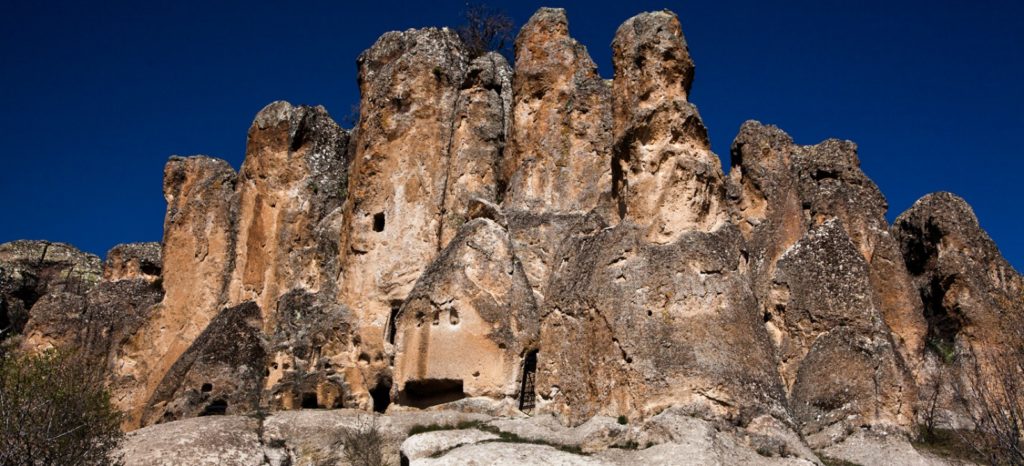
Lystra and Derbe
They then came to Lystra. There Paul performed a miracle causing a crippled man to walk again. When this occurred the people of the area assumed Barnabas and Paul were gods. The priest of Zeus brought animals to offer as sacrifices to Barnabas and Paul. When Barnabas and Paul realized what was happening, they tore their clothes in lament and told the people of the one true God (Acts 14:8-18).
The Jewish unbelievers from Antioch and Iconium had come to Lystra too, stirring up trouble. They convinced the people of Lystra to stone Paul and left him for dead outside the city. But Paul wasn’t dead. He got up walked back into the city (Acts 14:19-20).
The book of Acts doesn’t give us details about the events of that day when Paul walked back into the city, but I imagine the city’s residents were shocked. It was quite rare for anyone to survive stoning.
Barnabas and Paul then continued onto Derbe the next day. They preached and “won a large number of disciples” (Acts 14:21). Archeologists have discovered several inscriptions that show the Christian faith was a major presence in the city of Derbe after Barnabas and Paul’s visit.
Facing Tribulations for the Sake of Discipleship
Barnabas and Paul began their trek back home, but they decided that they’d first travel back through Galatia. When you look at a map, you see that it would have been much faster (and likely easier) to travel from Derbe directly to Antioch in Syria.
Derbe is less than 260 miles away from Antioch in Syria and less than 140 miles away from Paul’s original hometown of Tarsus. Barnabas and Paul could have traveled eastward through the region of Cilicia. Paul was very familiar with Cilicia and likely had friends throughout the region that could give them safe refuge along the way.
But Barnabas and Paul intentionally traveled more than 280 miles in the opposite direction of Antioch in Syria. Even though they had suffered great persecution in Galatia, they wanted to go back through the Galatian cities, before heading home, because they wanted to strengthen the disciples in those cities.
They returned to Lystra and to Iconium and to Antioch, strengthening the souls of the disciples, encouraging them to continue in the faith, and saying that through many tribulations we must enter the kingdom of God. —Acts 14:21-22
The journey through these cities for a second time gave them the opportunity to teach doctrine, establish elders in the churches, and pray with the believers.
After this, Barnabas and Paul then continued back down to Perga in Pamphylia. They preached in that region for a time. They eventually made their way over to the nearby port city of Attalia and sailed from there to Antioch in Syria (Acts 14:24-28).
Return to Antioch
Barnabas and Paul returned back home to Antioch in Syria stay there after the trip for “a long time” (Acts 14:28).
They had traveled more than 800 miles. Their first missionary journey had probably lasted between one and two years. When Barnabas and Paul arrived back in Antioch in Syria, they shared with everyone about the many people who had come to faith in Jesus and the churches that were established.
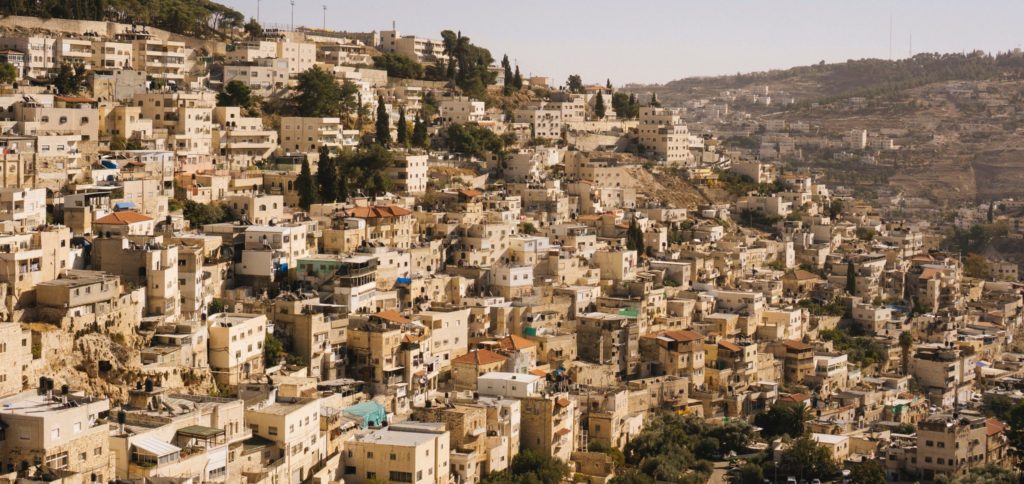
Jerusalem Council
After returning, Barnabas and Paul learned about a particular faction from Judea that had been confusing many Christians in the region by preaching a false gospel. This group had been preaching that, in order to become a Christian, the Gentiles must follow the Old Testament law, including circumcision (Acts 15:1).
Barnabas and Paul seem to have spent significant time disputing this false message and debated the Judean faction.
Eventually, this debate, about this false gospel, was appealed to the apostles in Jerusalem (Acts 15:2). This led to the Jerusalem Council (Acts 15:3-35), which likely took place sometime in 50 A.D. (some scholars date this event as early as 48 A.D. and some date it as late as 51 A.D.).
While traveling to Jerusalem for the council, Barnabas and Paul made stops along the way throughout Phoenicia and Samaria, encouraging believers wherever they went.
At the council, all the apostles concluded that the Gentiles do not need to follow the Jewish laws in order to become Christians. Barnabas and Paul (as well as several other men who had been at the council) headed back to Antioch to declare the good news. After the council they stayed in Antioch “some days” (Acts 15:36).
Paul and Barnabas Separate
Not long after the Jerusalem Council, Barnabas and Paul began planning their second missionary journey. They believed it was essential that they go to the Gentile world to proclaim the statements that came from the council.
Originally, Barnabas and Paul had intended to go out together again, however, they had a “sharp disagreement” (Acts 15:39). The source of this dispute was John Mark. Barnabas wanted John Mark to come along again, but Paul was against this idea since John Mark had deserted them on their previous missionary trip when they were in Pamphylia. Paul saw John Mark as a liability.
Due to this sharp disagreement, Barnabas and Paul would go on separate missionary journeys. Barnabas took John Mark and sailed to Cyprus. Paul took a young man named Silas and traveled by land (Acts 15:39-41).
Paul’s Second Missionary Journey
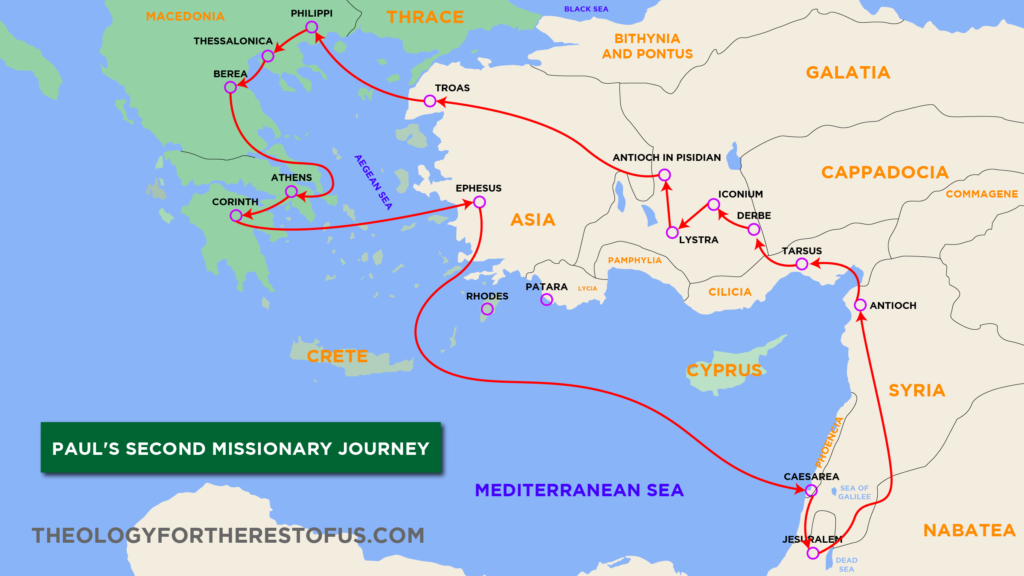
Paul likely started his second missionary journey (Acts 15-18) sometime late in 50 A.D. or early in 51 A.D. (but some scholars date both the council of Jerusalem and the launch of this missionary journey as early as 48 A.D.).
Paul and Silas started by traveling northwestward by land through the region of Cilicia. The Roman road that they would have used went directly through Paul’s hometown of Tarsus. I imagine this would have given Paul the sweet opportunity to reconnect with many old friends.
Paul and Silas made stops in the churches all throughout the region, along their way, “strengthening” believers (Acts 15:41).
Return through Galatia
Paul and Silas continued their travels westward into Galatia. They spent significant time in several Galatian cities including Derbe, Lystra, and Iconium, connecting with the churches that Paul had planted with Barnabas on this first missionary journey.
Paul and Silas taught the believers throughout Galatia what had been decided at the council in Jerusalem and the “churches were strengthened in the faith, and they increased in numbers daily” (Acts 16:5).
Paul Circumcises Timothy
Along the way, Paul and Silas meet a young man named Timothy from that region. He had a good reputation. Paul decided to let Timothy accompany them. However, Paul first circumcised Timothy (Acts 16:3).
It seems that Paul knew that having an uncircumcised man like Timothy with him could somehow impede the advance of the gospel wherever they preached.
Paul intended to continue to preach that circumcision was not necessary for salvation. But Paul knew that Timothy’s presence could potentially cause their opponents to claim that the only real reason that Paul was making these claims is because he had an uncircumcised friend (Timothy).
Paul’s Ministry Restricted
Paul and his crew traveled throughout the “region of Phrygia and Galatia” (Acts 16:6) looking for opportunities to preach the gospel in Asia (modern-day southwest Turkey), but they were restricted from doing so multiple times. They then traveled to the region of Mysia (modern-day northwest Turkey), attempting to eventually make their way northward toward Bithynia, but multiple times they were restricted or diverted by the Spirit (Acts 16:7).
It seemed that God’s providence was leading them somewhere other than what Paul had originally intended. They passed through Mysia again and eventually ended up in the city of Troas near the cost of the Aegean Sea.
Luke Joins the Team
In Troas, Luke joins their missionary crew. The book of Acts does not explicitly state this, but it’s implied. Throughout most of the book of Acts, Luke speaks in the third person. However, starting in Acts 16:10, Luke begins to speak in first person, as if he had joined the team by that point.
Luke would become one of Paul’s ministry protégés. He was a Greek physician, but he also functioned as an investigative journalist. He eventually writes both the Gospel of Luke and the book of Acts. Some scholars have also suggested that Luke wrote the book of Hebrews.
Macedonian Call and Travel to Philippi
While at Troas, Paul received a vision. This vision was of a Macedonian man asking for Paul to come and help them (Acts 16:9-10). After receiving this vision they sailed across the Aegean Sea to the island of Samothrace, and then onto Neapolis (modern-day northeastern Greece).
The missionary crew then traveled to Philippi where they stayed for “some days” (Acts 16:12). While there, they preached the gospel. One specific woman they met was Lydia. She became a believer along with the rest of her household and invited Paul and his companions to stay (Acts 16:13-15).
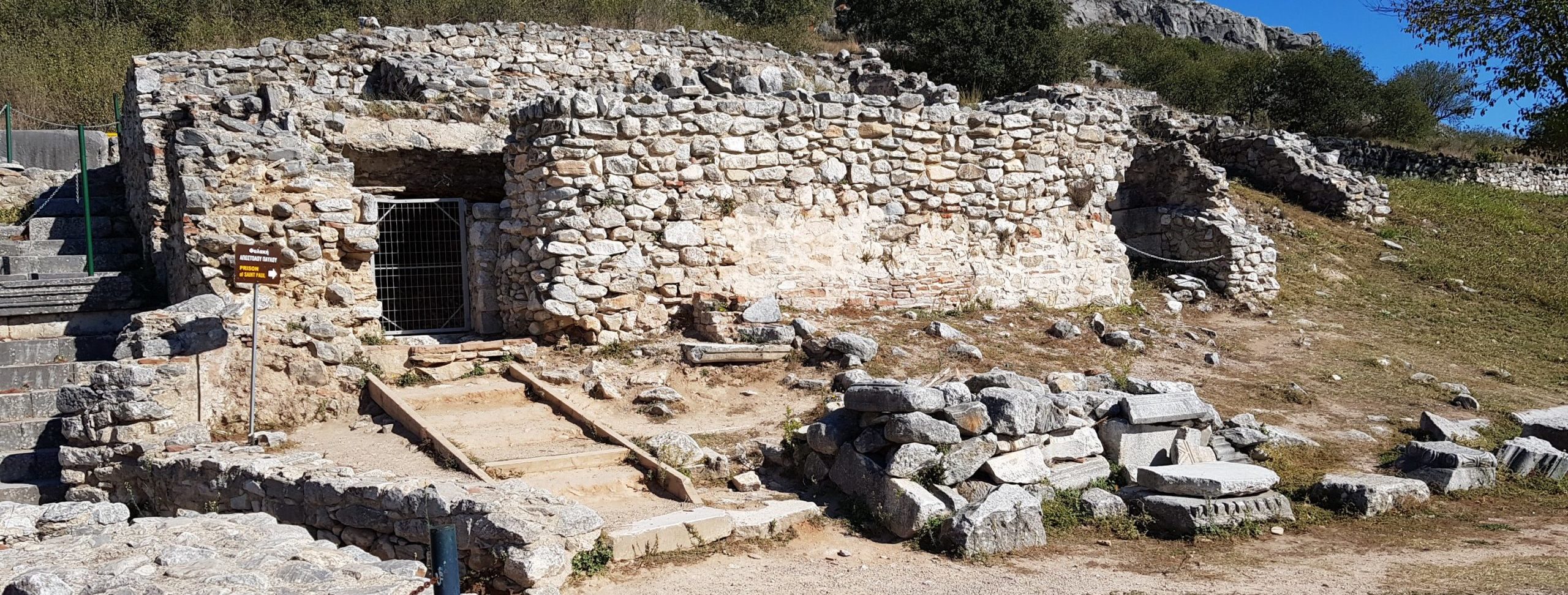
Paul and Silas Jailed in Philippi
While in Philippi, Paul and Silas met a slave girl who was demon possessed. Her owners made money off of her because the demon gave her the ability to function as a fortune-teller. For several days she followed Paul and Silas around, declaring that Paul and Silas were preachers of the one true God (Acts 16:16-18).
Paul cast the demon out of her. The girl’s owners realized that they wouldn’t make any more money from her, because she could no longer function as a fortune-teller. They were angry so they took Paul and Silas to the magistrates. Paul and Silas were beaten with rods and thrown into jail. Paul had previously been beaten and persecuted, but this marked the first time he was officially imprisoned (Acts 16:18-24).
While in prison, Paul and Silas prayed and sung hymns to the Lord. As they sang and prayed many of the other prisoners listened. Late in the night an earthquake occurred, this earthquake not only opened all the doors but broke their chains.
The jailer believed that all the prisoners had escaped and was about to kill himself (the Romans would’ve blamed the guard and likely would’ve executed him). But Paul and Silas stopped him and told him that no one had escaped. Then the jailer responded asking how to be saved.
And they said, “Believe in the Lord Jesus, and you will be saved, you and your household.” —Acts 16:31
God turned the persecution into an opportunity for gospel proclamation. Paul and Silas were not only able to witness to the jailer but all the prisoners listening to their hymns and prayers throughout the night. Paul went to the jailers home to preach and several people came to faith (Acts 16:25-34).
When the town magistrates learned that Paul and Silas were Roman citizens, the magistrates apologized for having unlawfully imprisoned them. This was a public vindication (of sorts) for Paul and Silas. Before leaving, Paul and Silas spent more time with Lydia and the other new converts in the region, encouraging them in the faith (Acts 16:35-40).
Thessalonica
Next, Paul and his crew passed through Amphipolis and Apponia and came to Thessalonica (Acts 17:1). As was his habit, Paul first went to the synagogue to preach to the Jews. He preached there on three consecutive Sabbath days. Many people believed, including many Gentiles.
Yet again, as Paul had seen before, many Jews became angry and jealous, and they caused an uproar. One of the brothers that had welcomed Paul was a man named Jason. The Jews dragged Jason before the city’s leaders. Jason was eventually released.
Paul and Silas left the city. It does seem that the church in Thessalonica continued to face persecution and trouble from their countrymen, but they flourished anyway. We read these words in Paul’s letter to the church:
For you, brothers, became imitators of the churches of God in Christ Jesus that are in Judea. For you suffered the same things from your own countrymen as they did from the Jews. —1 Thess. 2:14
Paul and his crew went to Berea. There, Paul yet again started in the Jewish synagogue, but this time he got a different response. Instead of jealousy and mobs, the Jews there examined the Scriptures to see if what Paul was saying was true. Many believed in Jesus.
Paul praised their willingness to study and pursue truth. Luke says the Jews of Berea were “more noble” than the Jews of Thessalonica (Acts 17:11).
Things seem to be going well. Many people became Christians. But the Jews from Thessalonica heard that Paul was teaching in Berea and they came to stir up the crowds and trouble. Paul was sent away by the brothers there, but Silas and Timothy stayed behind (Acts 17:13-14).
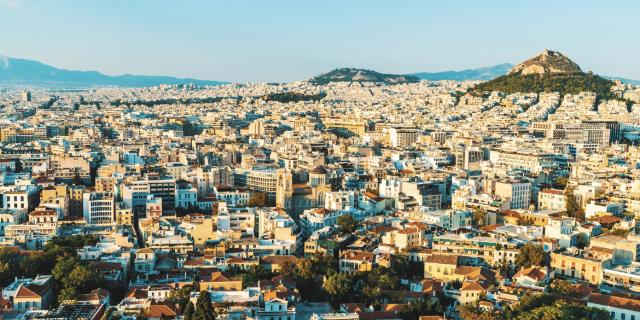
Traveling in Achaia
The apostle Paul was then escorted by some brothers more than 300 miles south, into the region of Achaia, reaching the city of Athens. When they arrived in Athens, the brothers headed back. Paul stayed in Athens, but told the brothers to tell Silas and Timothy that he wanted them to join him as soon as possible (Acts 17:15).
While Paul waited for Silas and Timothy, Paul’s “spirit was provoked within him” (Acts 17:16) because he saw an abundance of idols in the region.
Paul decided to make the best use of his time and talked with the Jews at the synagogue and preached to many Gentiles in the marketplace (Acts 17:17). Paul also talked with Epicurean and Stoic philosophers (Acts 17:18). They eventually brought Paul to the Areopagus, the court where men discussed philosophy, civics, and religion.
In the court of the Areopagus, Paul preached one of his most famous sermon (Acts 17:22-31). Paul’s sermons included quotes from famous Greek philosophers that they would have been familiar with. This gives us insights into Paul’s knowledge of their culture and insights into Paul’s missiology.
After hearing Paul’s sermon, there were some there who laughed at him, but there were also some who believed the gospel and joined Paul (Acts 17:32-34).
First Visit to Corinth
After leaving Athens, Paul traveled 53 miles southwest to Corinth. By this point in his second missionary journey, Paul had traveled more than 1,500 miles.
The apostle Paul probably arrived in Corinth apx. 8-12 months after the start of the second missionary journey, therefore, it’s likely that he got there sometime late in the year of 51 A.D. (or maybe sometime early in 52 A.D., depending on how we date his departure from Antioch in Syria). Paul stayed in Corinth for a year and a half (Acts 18:11), so Paul was likely in Corinth until the summer or fall of 53 A.D.
Silas and Timothy also rejoined Paul in Corinth.
While in Corinth, Paul met two Jews from Rome, Aquila and Priscilla. Like the apostle Paul, Aquila and Priscilla were also tentmakers. Paul stayed with them and worked while also going to the synagogues on the Sabbath to preach, seeking to convert both Jews and Greeks (Acts 18:1-4).
Paul faced some opposition from Jews in Corinth (Acts 18:5-9), but many people in the city believed anyway. Paul may have been considering leaving the city, but he stayed in Corinth after having received a vision from God that told him that “no one will attack or harm you” (Acts 18:10).
While in Corinth the apostle Paul wrote his letters to the Thessalonians, encouraging the new believers there to stand firm under the pressure and pain of persecution. He gives them instructions on how to live a godly lifestyle and gives doctrinal teaching about the future second coming of Christ.
Paul continued to preach the word of God faithfully for those 18 months. Many were saved and the church was established. But many Jews were upset.
The Jews of Corinth eventually tried to bring the apostle Paul before the Roman proconsul Gallio, who happened to be the older brother of the renowned dramatist and philosopher Seneca (the tutor of Emperor Nero). Gallio refused to even hear their case against Paul and sent them away (Acts 18:12-17).
Paul stayed in Corinth for “many days longer” (Acts 18:18) after being brought before Gallio. He then started his journey back home to Antioch in Syria, but planned to first make a stop in Ephesus. Priscilla and Aquila came with him.
Leaving from Cenchreae
Paul’s crew traveled to the nearby port city of Cenchreae, just eight miles from Corinth. We don’t know how long they stayed in Cenchreae, but they were there long enough for Paul to have his head shaved as part of a vow (Acts 18:18). It’s possible that this stop was very brief, but it’s also possible that they spent some time preaching and ministering there in the city.
There does seem to be some evidence that Paul spent some significant time in Cenchreae. But we cannot be certain. Also, we’re not sure if he spent time there during this second missionary journey or if that happened at a later time during his third missionary journey.
Brief Visit to Ephesus
When Paul arrived in Ephesus, he went into the synagogue to talk with the Jews about Jesus. His visit to Ephesus was brief. They requested that he stay in the city longer. He declined but said, “I will return to you if God wills” (Acts 18:21). Paul made plans to leave, but Priscilla and Aquila stayed in the city.
Paul traveled from Ephesus to Caesarea. Once he was there he visited with the believers in the region and preached the gospel in various towns and places. He briefly visited Jerusalem and then traveled back home to Antioch in Syria.
Paul’s second missionary journey lasted between two and a half years and three years, and likely ended back in Antioch sometime in the fall of 53 A.D. (or maybe early 54 A.D.).
Paul’s Third Missionary Journey
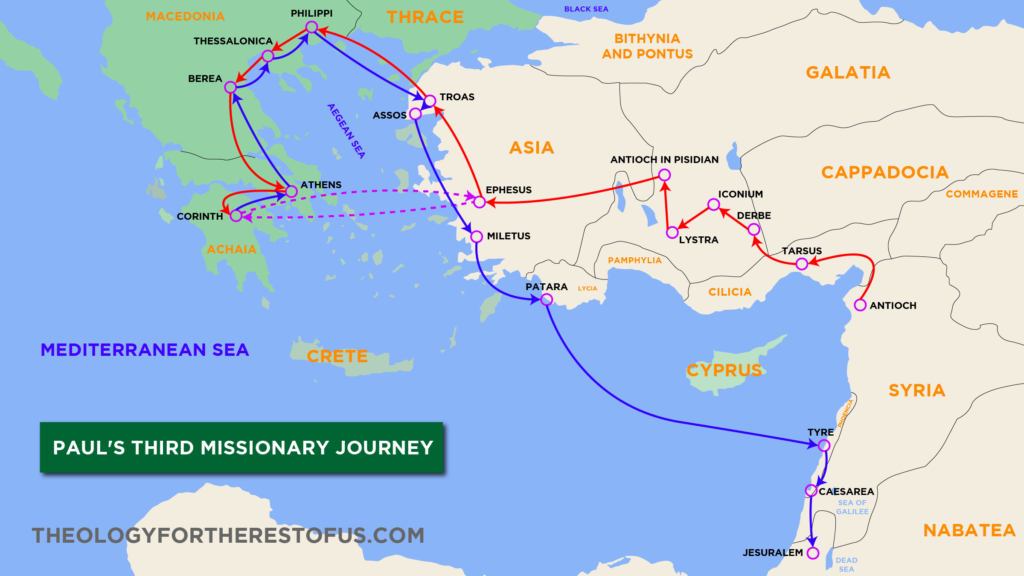
After getting back from his second missionary journey, the apostle Paul stayed Antioch for “some time” (Acts 18:23). Maybe just a few weeks or few months. He then launched his third missionary journey (Acts 18-21).
Paul likely left for his third missionary journey in the spring of 54 A.D. This third missionary journey was probably more than four years long and ended with Paul in Jerusalem in 58 A.D.
Galatia and Phrygia
Paul began his third missionary trip by visiting many of the same locations that he had visited on his first and second missionary journeys. We don’t know his exact route, but it’s likely he began by traveling through the region of Cilicia and through the city of Tarsus, on the way toward Galatia.
He spent several months traveling to the churches throughout the regions of Galatia and Phrygia, “strengthening all the disciples” (18:23). Paul passed through the “inland” route through Asia and traveled west to Ephesus (Acts 19:1).
Three Years in Ephesus
Paul spent three labor-intensive years in Ephesus (Acts 20:31). Paul was likely in Ephesus from the fall of 54 A.D. to the fall of 57 A.D.
Paul’s time in Ephesus was hard. He later says that he experienced many “afflictions” and he wasn’t confident that he would live through this season (2 Cor. 1:6-10). But God did many great things through Paul while he was in Ephesus.
For the first few months of Paul’s ministry in Ephesus, he spent time preaching in the synagogue. That was his focus. However there were many Jews stuck in unbelief, and they said evil things about Paul and the gospel message. So Paul decided to spend the last two and half years of his time in Ephesus preaching in the hall of Tyrannus, instead of the synagogue. He preached in the hall of Tyrannus daily and “all residents of Asia heard the word of the Lord” (Acts 19:10).
During Paul’s ministry, he performed many miracles in the name of Jesus, leading many to believe.
“God was doing extraordinary miracles by the hands of Paul… even handkerchiefs or aprons that had touched [Paul’s] skin were carried away to the sick, and their diseases left them and the evil spirits came out of them.” —Acts 19:11-12
God-Fearers Received the Holy Spirit
One of the most famous events from Paul’s time in Ephesus was when he corresponded with a group of disciples that had known about John’s baptism (referring to John the Baptist), but they did not know about Jesus (Acts 19:1-3). These types of believers were sometimes referred to as God-fearers.
These God-fearers had previously been taught by a great preacher named Apollos. He had taught them to revere the one true God, the God of Israel. But Apollos himself had not known about Jesus until after he had preached to this particular group of disciples. Apollos was later instructed by Paul’s friends, Priscilla and Aquila (Acts 18:24-28).
Paul taught this particular group about Jesus. They believed and received the Holy Spirit (Acts 19:4-7).
The Sons of Sceva
Another event that the book of Acts highlights, from Paul’s time in Ephesus, is about seven traveling Jewish exorcists, the sons of Sceva. These exorcists came across a demon-possessed man. They attempted to cast-out the demons (Acts 19:11-14). But one of the demons responded to them, “Jesus I know, and Paul I recognize, but who are you?” (Acts 19:15).
The demon-possessed man (under the control of the evil spirits) attacked the seven men and badly beat them (Acts 19:16). This caused many people in the region to respect Paul and his ministry. Many of the magicians in the area repented and burned their magic books (Acts 19:17-19) and “the word of the Lord continued to increase in the region” (Acts 19:20).
Demetrius, Riots, and Leaving Ephesus
Paul was planning to leave Ephesus. However, before he left Ephesus, a silversmith named Demetrius caused trouble. Demetrius made and sold idols. Paul preached against idolatry, so many people stopped buying Demetrius’ idols. This cost him money. Demetrius clearly was not happy.
There were other business owners that were also hurt financially because of Paul’s preaching. Many people had stopped buying their idols as they responded to the gospel. When these merchants got together, they started a massive riot in the city.
Paul wanted to go into the crowd to calm them down, but the disciples would not let him because they knew that Paul could get killed. Some of the Christians went into crowd and calmed the riot. Shortly after these riots, Paul set sail for Macedonia (Acts 19:21-20:1).

The “Painful” Visit
Paul had made plans to travel through Macedonia and then southward into Achaia (1 Cor. 16), which would likely include a visit to the church in Corinth.
At some point, Paul received some correspondence telling him that there were massive problems in the church of Corinth. How did Paul respond when he received this news? There are two main views from scholars.
View #1: Paul immediately changed plans and left from Ephesus to Corinth.
Some scholars argue that as soon as Paul received word that there were big problems in Corinth, Paul changed his plans and decided to visit the Corinthians immediately, skipping his original plans to travel through Macedonia.
Paul probably thought that once he was there in Corinth, that he’d be able to resolve the conflicts. But it seems that the exact opposite happened. Paul would later describe this visit as “painful” (2 Cor. 2:1). During this “painful” visit Paul was deeply hurt by someone in the church (2 Cor. 2:5).
The scholars that embrace View #1 say that Paul then left Corinth after this “painful visit” and headed back to Ephesus for a brief period of time.
It then appears that Paul was contemplating returning to Corinth, yet again, before heading over to Macedonia, but Paul ultimately decided against this additional visit, in order to “spare” the Corinthians (2 Cor. 1:23). Paul defends this decision in 2 Corinthians (vv. 1:12-2:2).
Paul then left from Ephesus to Macedonia (Acts 20:1). However, Paul would eventually make a third visit back to Corinth a few months later toward the end of this journey.
These scholars typically piece it all together like this:
- Paul (while in Ephesus) receives news of trouble in the church of Corinth and changes his plans
- Travels from Ephesus to Corinth for a second visit (known as the “painful” visit)
- Travels from Corinth back to Ephesus
- Contemplates another visit to Corinth, but decides against it
- Experiences the Demetrius-led riots in Ephesus
- Travels onto to Macedonia
- Goes from Macedonia down into Greece
- Eventually makes it back to Corinth (third overall visit)
Scholars that hold to View #1 assert that Paul ultimately made three total visits to Corinth; his first visit (the 18 months he spent there during his second missionary journey), the “painful” visit from Ephesus, and then a third visit toward the end of this third missionary journey.
View #2: Paul did not change his plans, but visited Corinth later.
Scholars that hold to View #2 say that Paul likely received some communication from Corinth (that there were indeed big problems in the church), but these scholars conclude that receiving this communication did not cause Paul to visit Corinth immediately.
The scholars that embrace View #2 argue that Paul did consider changing his plans, which would have consisted of a visit to Corinth before going through Macedonia, but these scholars argue that ultimately Paul decided against going to Corinth immediately, so he stuck to his plans to travel through Macedonia. They interpret Paul’s words in 2 Corinthians (vv. 1:12-2:2) as Paul giving a defense as to why he did not visit them.
These scholars say that eventually Paul did visit Corinth, a few months later, toward the end of his third missionary journey. Scholars that embrace View #2 often say that the word “painful” (2 Cor. 2:1) was not a description of an actual visit that ever happened, but that it was a description of the type of visit that would have ensued if Paul had indeed visited them. He knew that if he did visit, it would have been painful, so he sought to “spare” them (2 Cor. 1:23).
- Paul (while in Ephesus) receives news of trouble in the church of Corinth
- Contemplates an immediate visit to Corinth, but ultimately decides against it
- Goes from Ephesus to Macedonia
- Eventually travels to Corinth for his second visit
Scholars that hold to View #2 assert that Paul ultimately made two total visits to Corinth; his first visit (the 18 months he spent there during his second missionary journey) and then his visit to Corinth toward the end of this third missionary journey.
Leaving For Macedonia and the Sorrowful Letter
Paul leaves Ephesus and heads toward Macedonia. In the book of Acts, Luke gives us no details. He only says that Paul “departed for Macedonia” (Acts 20:1). However, by examining Paul’s letters, we get more insight into these travels.
It appears that, at some point during this journey, Paul had sent Titus to Corinth with a letter (this is sometimes referred to as the “sorrowful letter”). Paul later describes this “sorrowful” letter as having been written with “much affliction and anguish of heart and with many tears” (2 Cor. 2:4).
Some scholars contend that this “sorrowful letter” is the epistle that appears in the New Testament, that we know today as 1 Corinthians. Other scholars argue that the “sorrowful letter” is a separate correspondence that has been lost to history.
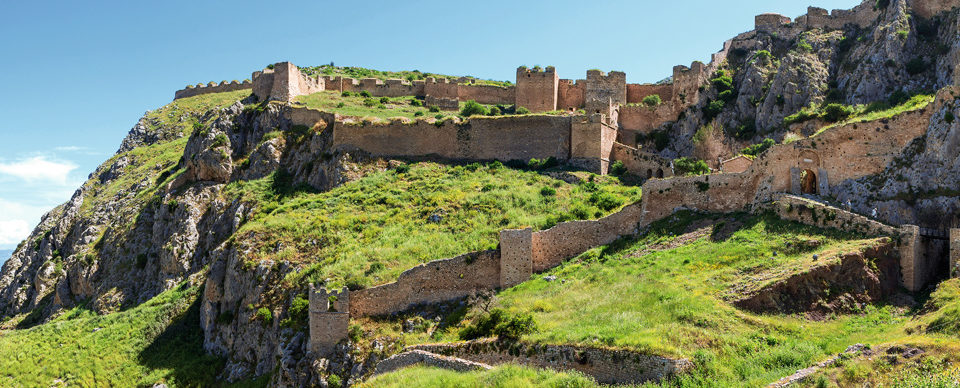
Ministry in Troas and Macedonia
On the way to Macedonia, Paul stopped in Troas to preach there and to await Titus’ return from Corinth. While waiting in Troas, Paul had great ministry opportunity. He called it an “open door” (2 Cor. 2:12).
However, when Titus’ return from Corinth appeared to be delayed, Paul was concerned for Titus’ safety. Paul decided to leave Troas and traveled to Macedonia to find Titus (2 Cor. 2:13).
Paul traveled throughout Macedonia, visiting the churches and friends in the region, and encouraging the believers in those churches (Acts 20:2).
Finally, while in Macedonia, Paul was reunited with Titus. Titus reported that many people in the church of Corinth had repented after hearing Paul’s letter (2 Cor. 2:5-11; 7:5-16). Paul was filled with joy.
However, Titus also reported that Paul’s opponents still wielded some influence over a small rebellious faction within the church questioning Paul’s authority and credibility. Paul responded to this faction by writing another letter (most likely from Philippi). This letter is in our New Testament, known today as 2 Corinthians.
Three Months in Greece
After these travels through Macedonia, the apostle Paul eventually traveled southward and finally arrived in Greece (i.e., Achaia). He stayed in the region for three months (Acts 20:2-3), including a lengthy stay in Corinth. This stay likely took place in late 57 A.D. or early 58 A.D.
While in Corinth, Paul wrote his theological masterpiece, the letter to the Romans.
As previously discussed in this article, some scholars believe that this was Paul’s second visit while others argue that this was his third visit.
Cenchreae and Phoebe
It’s also possible that during these three months in Achaia, Paul spent time in the nearby city of Cenchreae. In the book of Romans, Paul mentions Phoebe, a deaconess in the church of Cenchreae (Rom. 16:1).
Phoebe was the person that delivered Paul’s letter to the Romans, and Paul asked them to welcome her, praising her for being a “patron of many” (Rom. 16:2). It’s highly unlikely that Paul would have asked her to make this important delivery for him unless he knew her well and trusted her, pointing to the likelihood that Paul had spent time in Cenchreae before writing that letter.
As previously mentioned in this article, it’s also possible that Paul had spent some time in Cenchrea during his second missionary journey as well as this third missionary journey.
One More Lap Through Macedonia
After his time in Achaia, Paul had originally intended to sail directly to Jerusalem. Those plans were changed, however, when it was discovered that some of Paul’s opponents had been plotted against him. Paul decided to take another lap through Macedonia instead (Acts 20:3).
Paul had many companions with him, from various churches, which gave him protection while he traveled through Macedonia (Acts 20:4-5).
Throughout the spring of 58 A.D., Paul traveled through the Macedonian region, visiting towns such as Berea and Thessalonica, and eventually ending up in Philippi (again) during the “days of unleavened bread” (Acts 20:6).
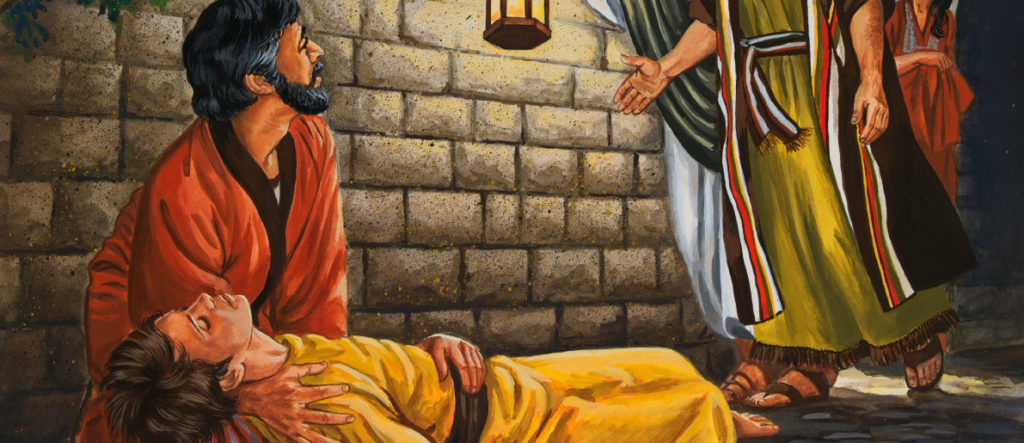
Eutychus Raises from the Dead at Troas
Paul and his companions then traveled to Troas (Acts 20:5). He ministered there again for a week. It was in Troas that a young man, Eutychus, was listening to one of Paul’s sermons and fell three stories out a window. When they found him he was dead on the ground, but Paul supernaturally restored life to this man (Acts 20:6-12).
After Troas, Paul’s companions went by ship to Assos, but Paul went by foot. Luke doesn’t tell us precisely why Paul did this. But what we do know is that distance from Troas to Assos was more than 30 miles through dangerous and mountainous terrain.
After meeting with his companions in Assos, they began their trek to Jerusalem. They made briefs stops in Chios and Samos, before arriving in Miletus (Acts 20:15).
Goodbye to the Ephesian Elders
It would make sense that Paul would have wanted to stop in Ephesus before heading to Jerusalem. considering the dear friends he had there, but he intentionally passed Ephesus because he wanted to be in Jerusalem by Pentecost, and he knew that traveling through Ephesus, and staying in Asia, would take much more time than he desired. In addition, he knew visiting Ephesus again could cause an uproar (Acts 20:13-16).
However, Paul did want to see his Ephesian friends and ministry partners, so when he arrived in Miletus, Paul called the elders from Ephesus to meet him there (Acts 20:17). In Miletus he encouraged the elders and commended them, letting them know that he would not be seeing them again since he knew that imprisonment and maybe death waited for him in Jerusalem. This was, no doubt, an emotional moment for Paul and his friends.
Paul had spent several years laboring with these men in ministry, and now he was saying goodbye for, what appeared to be, the last time. They wept and prayed together (Acts 20:17-38).
Sailing for Syria
From there, the apostle Paul and his companions then sailed towards Syria. They made brief stops in Cos, Rhodes, and Patara, before finally coming to Syria, landing at Tyre (Acts 21:1-3). Paul and his companions spent seven days with the disciples in Tyre. Through “the Spirit” they told Paul not to go onto Jerusalem, but Paul sensed that Jerusalem was the right place to go (Acts 21:4).
Then Paul and his companions went to Ptolemais (Acts 21:7), spending one day with the believers there, before heading onto Caesarea. There they were greeted by the believers there and they stayed with Philip the evangelist (Acts 21:8). While they were there, a prophet named Agabus came down from Judea and told Paul of the coming affliction he would face in Jerusalem (Acts 21:10-12).
Despite many people again urging Paul not to go to Jerusalem, Paul told them he knew what was instore and that he was ready to die.
Then Paul answered, ‘What are you doing, weeping and breaking my heart? For I am ready not only to be imprisoned but even to die in Jerusalem for the name of the Lord Jesus.’ —Acts 21:13
Paul and his companions then traveled to Jerusalem and was greeted by his brothers in Christ who lived there. He told the church there all God had been doing among the Gentiles (Acts 21:14-16). Once there, Paul visited with James and all the elders (Acts 21:17-18). He told them about all that God had done throughout the Gentiles.
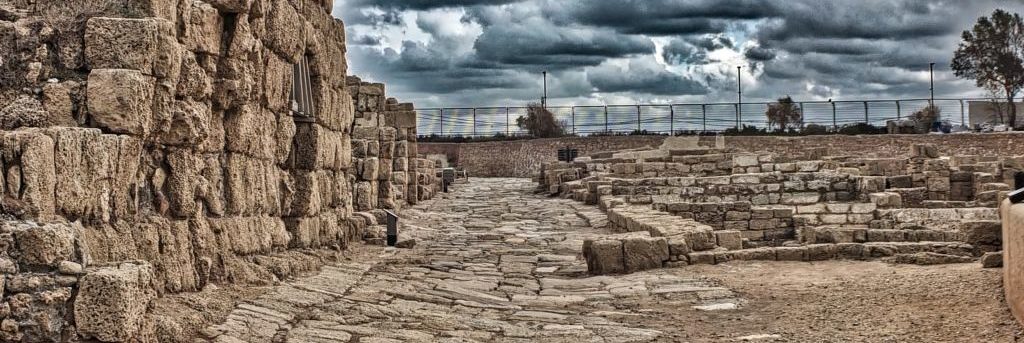
Arrested in Caesarea
While in Jerusalem, Paul went to the temple to worship and pray. While he was there, some Jews from Asia Minor stirred up trouble for Paul. They accused him of abandoning the one true God of Israel, of maligning the law of Moses, and of encouraging people to disobey the Jewish laws. Paul (obviously) denied this charge. This confrontation caused a riot in the temple. Paul was dragged out of the temple by a mob. The Romans then intervened and took Paul into custody (Acts 21:27-36).
Paul then addressed the crowd. He made it clear that he loved the law of God and that he had previously been a persecutor of Christians. But that he had become a preacher of the gospel after meeting Jesus on the road to Damascus. This caused another riot to erupt. The Romans then took Paul in their barracks. The Romans were going to flog him but Paul appeals to his own Roman citizenship (Acts 21:37-22:29).
On Trial Before Felix
Paul is taken to the Roman barracks in Caesarea. During this time the Roman governor over the region, Felix, brought Paul to trial. Ananias, the high priest, came from Jerusalem to bring charges against Paul. Felix gave Paul the opportunity to speak before the crowd. Paul shares his story and preaches truth. Felix was afraid of Paul’s message, so he doesn’t seemingly know what to do with Paul (Acts 23:23-35; 24:1-27).
Paul was imprisoned in Caesarea by the Romans for two years, but was given “some freedom” and his friends are allowed to visit him “to take care of his needs” (Acts 24:23).
On Trial Before Festus and Agrippa
When Festus became the governor of the region in 60 A.D. (or maybe earlier in 59 A.D.), he brought Paul back to trial. Some Jews came from Jerusalem again to bring charges against Paul, but they could not prove any of those charges (Acts 25:1-12).
King Herod Agrippa II visited with Festus. Festus asked him to hear Paul’s case. When Paul is called to defend himself, he gives one of his most famous defenses of the gospel and even encourages Agrippa to believe in Jesus (Acts 26:1-29). Agrippa famously responds, “Do you think that in such a short time you can persuade me to be a Christian?” (Acts 26:28). Paul says that he wants everyone to believe.
Festus calls Paul crazy (Acts 26:24), but both he and Agrippa agree that Paul had not done anything that might “deserve death or imprisonment” (Acts 26:31). Paul could have simply “been set free if he had not appealed to Caesar” (Acts 26:32). Paul had appealed to Caesar under his rights as a Roman citizen. This set into the motion the plans for Paul to be transported from Palestine to Rome to face trial in Caesar’s court.
Journey to Rome
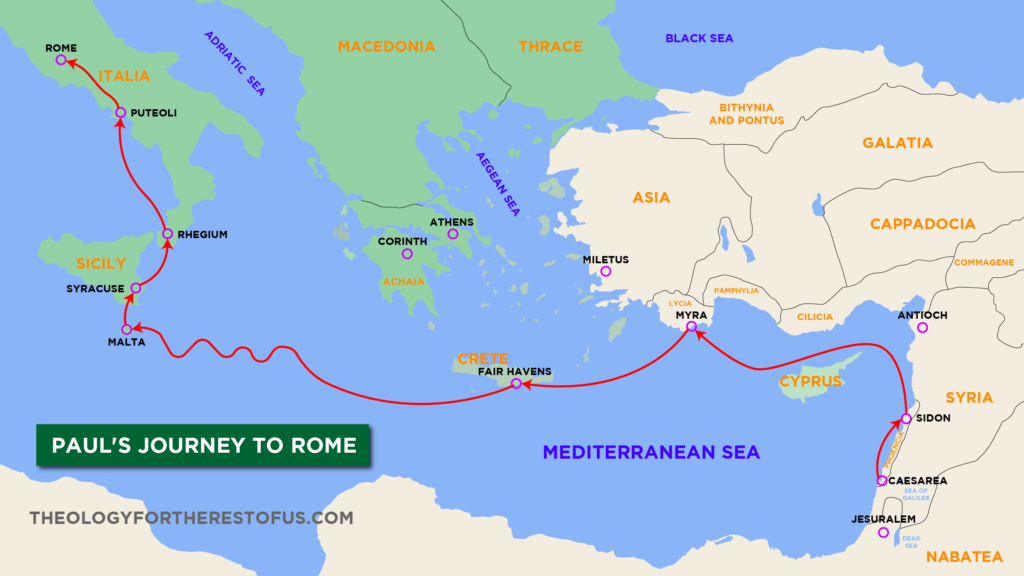
After his appeal to Rome, the apostle Paul is transported from Caesarea to Rome by ship under Roman guard (Acts 27:1-28:10). Some Bible scholars allude to this journey as Paul’s fourth missionary journey, but I don’t believe that’s the best or most accurate description for this trip.
Paul’s trip to Rome was tumultuous, filled with difficulties, including a shipwreck that caused him to be deserted on the island of Malta for three months. He also consistently faced belligerent resistance from people that opposed the gospel.
Paul and his companions eventually made it to Rome, sometime around 61 A.D. (or maybe somewhat earlier). When Paul arrived in Rome, he was placed under house arrest for two years.
Paul lived in a rented house where he served his house arrest. There he is able to visit with friends and preach the gospel to those who visit. During this time he also writes several letters that are now in the New Testament, including Philippians, Ephesians, Colossians, and Philemon.
The book of Acts ends there, with Paul under house arrest in Rome (Acts 28:11-31).
Paul’s Fourth Missionary Journey
The fourth missionary journey is not outlined in the narratives of Scripture. And there are some scholars that question whether such a journey ever really happened (we’ll cover that a bit more later in this article).
We don’t have a clear picture of what happened next in Paul’s life, after he was released from house arrest. But by carefully examining Paul’s epistles, I’m confident we can piece-it-together.
The early church father and historian Eusebius (writing in the 4th century) recorded that the most prominent church tradition had been that Paul was released from Roman house arrest and then re-arrested several years. According to this tradition, Paul’s second arrest eventually led to his martyrdom under the direction of Emperor Nero (see H.E. 2.22.6 ).
Also, Paul’s later letters (1 & 2 Timothy and Titus), commonly referred to as the Pastoral Epistles, are clearly written after the events of the book of Acts. In those letters Paul makes comments about his travels and plans. Paul is likely released from house arrest sometime around 63 A.D.
During his house arrest in Rome, Paul was clearly making plans to travel eastward. He asks Philemon to prepare a guest room for him (Philemon 22) and tells the Philippians that he intends to visit them (Phil. 2:24). Paul doesn’t strike me as the type of guy that would make plans in vain. Paul anticipated his release from house arrest.
These plans to go east make perfect sense. Paul’s habit was to go back and encourage the churches that he had previously established. That’s what he’d done on previous journeys.
Then, in 2 Timothy, written much later in life, during Paul’s second imprisonment, Paul mentions and alludes to people and moments that are connected to his post-Roman arrest ministry travels through Asia. He’s sort of looking back on past events and correspondences. Paul mentions:
- Having a significant dispute with some believers in Asia, including Phygelus and Hermogenes (2 Tim. 1:15)
- Receiving help from Onesiphorus (2 Tim. 1:18)
- Having been with Carpus at Troas (2 Tim 4:13-14)
- Being confronted by Alexander the coppersmith (2 Tim. 4:14)
- Needing to leave Trophimus in Miletus because he was ill (2 Tim 4:20)
All of these events happened after Paul’s release from Roman house arrest.
Paul says in 2 Timothy 4:20 that “Erastus remained at Corinth.” This is a clear statement that Paul had been in Corinth; he knew Erastus was there because he had first-hand knowledge, having recently visited the city.
In Titus 3:12, Paul invites Titus to join Paul in Nicopolis. Paul tells Titus that he plans on spending the winter in Nicopolis, a city in Achaia. Clearly, when Paul writes the letter to Titus he is already in Achaia or somewhere very close, hoping for Titus to meet him there.
In Paul’s letter to Titus, he alludes to having been in Crete and having left Titus in charge to help those churches flourish.
A few scholars have argued that Paul did ministry in Crete when he was shipwrecked there. Paul had been briefly shipwrecked in Crete while traveling from Caesarea to Rome, before his Roman house arrest (Acts 27).
However, Paul and the men from the shipwreck were in Crete just a short while. As we examine the events of the shipwreck, as they are described in the book of Acts, we see that Paul would not likely have had the opportunity to establish churches in the region during such a short period. Also, they didn’t travel throughout the island at all.
What seems much more likely is that Paul eventually made it back to the island of Crete, spend time preaching, establishing churches throughout the region, and that upon his departure Paul left Titus there to “complete [their] work there and appoint elders in each town” (Titus 1:5).
At the beginning of 1 Timothy Paul says “when I was going to Macedonia” (1 Timothy 1:3). When we examine this letter, we get the sense that he’s referring to events in the not-too-distant past. Seems likely Paul is referring to the moment when he had traveling to Macedonia after being released from Roman house arrest. After his time spent in Macedonia, he may have headed back to the church in Ephesus, which he asserted was his plan (1 Timothy).
Doubts about the Fourth Journey
There are clearly some comments in Paul’s letters that do not easily square with the events of the book of Acts, which means that those comments in his letters point to some missionary work that happened after Paul’s Roman house arrest.
However, a few scholars have argued that there’s significant (enough) overlap in the locations, types of events, and even the people mentioned during Paul’s first three journeys, therefore it’s hard to say for sure—they claim it’s possible that much of those things that do not seem to square with the events of the book of Acts can still potentially be things that happened on one of his first three missionary journeys.
Also, some scholars have sought to remind us that the apostle Paul spent long periods of time in some locations (like 18 months in Corinth and 3 years in Ephesus), and they’ve asserted it’s possible that many unrecorded things may have happened during those long stays, implying that those longer stays in those locations could account for some of the comments in Paul’s epistles.
These scholars claim there’s so much that we do not know about those time periods, that it’s entirely possible all of the events alluded to by Paul, in his own letters, took place during his first three journeys.
I happen to be confident that Paul did indeed take a fourth missionary journey, after his release from his Roman house arrest. I think that’s the best interpretation of the data we have. However, I also realize that there are some good New Testament scholars that don’t find the evidence as compelling as I do.

Potential Travel to Spain
Did Paul ever make it to Spain? We know from Scripture that the apostle Paul had a desire to preach in Spain (Rom. 15:22-29). After being released from Roman house arrest, he could have easily sailed westward.
Clement of Rome (writing in 95 A.D.) says that Paul had traveled and preached in “the farthest limits of the West” (1 Clement 5:5-7). This sort of language could have described a location west of Italy, such as Gaul or Britannia, but most scholars seem to think this describes Spain. However, it is also possible that Clement was speaking more broadly (or generically), referring to Paul traveling far westward from his home region, going from Palestine through much of the heart of the Roman Empire and eventually all the way to Rome. This latter interpretation seems odd to me.
The Muratorian fragment (written in apx. 170 A.D.), seems to affirm Paul’s missionary journey to Spain too, but some scholars question this; just because someone in the mid-to-late second century believed it doesn’t necessarily equate to strong evidence. However, this shows that church tradition was handing this down through the generations.
Paul’s missionary trip to Spain is also mentioned by Cyril of Jerusalem (313-386) and John Chrysostom (347-407).
There may not seem to be many significant (quality) pieces of evidence that corroborate the idea that Paul made it all the way to Spain, and there are not any comments in Paul’s later letters that point to him ever making it to Spain either. However, these extrabiblical evidences seem compelling. It’s possible that a trip to Spain may have been the first leg of Paul’s fourth missionary journey.
Paul Beheaded by Nero
In his second letter to Timothy, Paul mentions his “first defense” and says he was “delivered from the lion’s mouth” (2 Tim. 4:16-17). Most biblical scholars believe this is a reference to the first time he was in Caesar’s court, defending himself, eventually leading to his Roman house arrest (Acts 28).
Paul was released from his first Roman arrest, but there wouldn’t be a second release. Paul eventually ended up back in Rome. The second time, it wasn’t house arrest. It was a real Roman jail. This was most likely part of Nero’s persecution of Christians in the mid 60s. This was one of the most brutal times of persecution in Christian history.
When much of the city of Rome burndown in 64 A.D., Emperor Nero blamed the Christians. The emperor later requested that the apostle Paul be arrested and chained. It appears that Paul was arrested somewhat abruptly and unexpectedly, evidenced by the fact that he was not able to secure his cloak and his Old Testament parchments; Paul later requested that these be brought to him (2 Tim. 4).
Paul likely penned 2 Timothy during this second Roman imprisonment. Paul was beheaded shortly after he wrote 2 Timothy. Some scholars have concluded that Paul was killed as early as 64 A.D., but it is more likely that he was executed sometime between 67 A.D. and 68 A.D.
The legacy of the apostle Paul is second to none in Christian history. He is the greatest missionary evangelist the world has ever seen. Paul was a man on mission, focused on spreading the gospel and planting churches.
Paul was a man so impacted by Jesus, so compelled by God’s love, so humbled that the Messiah would choose him to be an ambassador, that he was willing to endure much pain and hardship to see others come to faith in Jesus Christ.
Featured illustration of Paul in prison courtesy of britannica.com. Images of the jails in Philippi and Caesarea courtesy of missionbibleclass.org. Illustration of Eutychus’ death courtesy of gfbtkingdomkids.com.
Recommended Resources:
“Handbook on Acts and Paul’s Letters” (by Thomas R. Schreiner)
“Paul: A Biography” (by N.T. Wright)
“Acts: An Expositional Commentary” (by R.C. Sproul)
“Dictionary of Paul and His Letters” (100+ contributors, edited by G. Hawthorne, R. Martin, and D. Reid)

Kenneth E. Ortiz (Th.M.) is Lead Pastor of Horizon City Church . He has 15+ years of vocational ministry experience. Kenneth previously served as a professor at Bethlehem College and adjunct faculty at Spurgeon College . Kenneth lives in Minneola, FL with his wife Malaina, they have two kids.
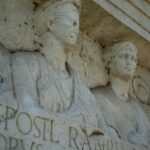
Paul the Evangelist traveled 10,000 miles to preach Christianity
By Ray Konig | azbible.com
About 2000 years ago, a man named Saul traveled to Damascus with the plan of rounding up Christians and taking them as prisoners to Jerusalem, so they could be persecuted for their beliefs.
He detested Christians. As he got closer to Damascus, which is a journey of about 150 miles from Jerusalem, he was engulfed in blinding light and encountered the resurrected Jesus.
The light blinded Saul and remained unable to see for three days. He converted to Christianity and became its best-known evangelist. His name was changed to Paul and he since has been known and referred to as Paul the Apostle and Paul the Evangelist.
Paul's encounter with the resurrected Jesus transformed his life. He went from trying to bring an end to Christianity to traveling roughly 10,000 miles throughout western Asia and parts of Europe to preach about Jesus and Christianity.
And he did so at risk to himself, as Christianity was not a legal religion within the Roman Empire at that time.
Below are descriptions and maps of each of the four evangelical journeys that Paul undertook during his life, after becoming a Christian. These journeys, and other details of Paul's life, are described in the Book of Acts, which is in the New Testament of the Christian Bible.
Paul's first journey
- Paul's second journey
- Paul's third journey
- Paul's journey to Rome
From about 46 AD to 48 AD (more than 1900 years ago), Paul the evangelist undertook his first mission journey. He traveled from Syrian Antioch to Derbe, and back again. This journey is described in the Bible's book of Acts, chapters 13 and 14. Click on any of the map markers and more information about that place will pop up.
The places that Paul visited during his first missionary journey are listed below in chronological order.
Saul (Paul) begins his first mission journey. He and Barnabas eventually travel hundreds of miles from Antioch to Derbe, and then back again. The first part of their journey takes them to Seleucia. Acts 13:1-4. (View on map)
From Antioch, Paul and Barnabas go to Seleucia, where they sail to Salamis in Cyprus. Seleucia, also known as Seleucia Pieria, now falls within the modern boundaries of Turkey, near Syria. Acts 13:4-5. (View on map)
In Salamis, Paul and Barnabas preach the word of God in Jewish synagogues. (There were many Jewish communities scattered throughout the Roman Empire). They then travel across the island to Paphos. Acts 13:4-7. (View on map)
In Paphos, Paul and Barnabas are sought out by a community leader named Sergius Paulus. A false prophet unsuccessfully tries to prevent Paul and Barnabas from evangelizing. The false prophet becomes blind during his confrontation. Acts 13:6-12. (View on map)
From Paphos, Paul and Barnabas sail to Perga on their way to Pisidian Antioch. Acts 13:13. (View on map)
Pisidian Antioch
In Pisidian Antioch, Paul tells people in a synagogue that Jesus Christ is the Messiah who was promised in the Old Testament . Many people turn against Paul and Barnabas. They leave for Iconium. Acts 13:14-52. (View on map)
In Iconium, Paul and Barnabas are met with great resistance to the Gospel. They learn that there is a plot to have them killed. They flee to the nearby towns of Lystra and Derbe. Acts 14:1-7. (View on map)
In Lystra, a man who had never been able to walk is miraculously healed through Paul. The town's people proclaim that Paul and Barnabas are gods. Paul and Barnabas correct them. Paul is later stoned, dragged out of the city, and left for dead. He recovers and travels to Derbe. Acts 14:8-20. (View on map)
Through the preaching of Paul and Barnabas, many people in Derbe learn about Jesus and become disciples. Paul and Barnabas later return to Lystra. Acts 14:20-21. (View on map)
After returning to Lystra, Paul and Barnabas meet with the new disciples, encouraging them to remain true to the faith. Acts 14:21-22. (View on map)
Paul and Barnabas return to Iconium to strengthen the new disciples there. Acts 14:21-22. (View on map)
Paul and Barnabas return to Pisidian Antioch to encourage and strengthen the new disciples there. Acts 14:21-22. (View on map)
Paul and Barnabas preach the Gospel in Perga before heading to Attalia. Acts 14:24-25. (View on map)
In Attalia, Paul and Barnabas sail back to the Syrian Antioch, the city from which they had begun this mission journey. Acts 14:26. (View on map)
In Antioch, Paul and Barnabas meet with fellow Christians and give a report about their mission journey. Paul and Barnabas stay in Antioch for a while, spending time with disciples. Acts 14:27-28. (View on map)
Map of Paul's second mission journey
Paul's second missionary journey took place between 49 AD and 52 AD, more than 1900 years ago. He traveled through part of Asia and Europe. This journey is described in the Bible's book of Acts, chapters 15, 16, 17 and 18. Click on any of the map markers and more information about that place will pop up.
The places that Paul visited during his second missionary journey are listed below in chronological order.
Paul begins his second mission journey. Paul, Barnabas, Silas, and other evangelists, first travel from Jerusalem to Antioch. Acts 15:22. (View on map)
Paul and Barnabas have a disagreement. They part ways. Barnabas goes to Cyprus. Paul and Silas travel through Syria and Cilicia. Acts 15:36-41. (View on map)
Paul travels through Cilicia, which includes the city of Tarsus. Acts 15:36-41. (View on map)
Paul travels to the towns of Derbe and Lystra, both of which he had visited during his first mission journey. Acts 16:1-5. (View on map)
In Lystra, Paul meets Timothy, who becomes an evangelist. Acts 16:1-5. (View on map)
It is possible that Paul travels through Iconium, on his way to Troas, given the information in Acts 16:1-6. (View on map)
It is possible that Paul travels through Pisidian Antioch, on his way to Troas, given the information in Acts 16:1-6. (View on map)
After arriving in Troas, Paul has a vision telling him to go to Macedonia and evangelize there. Acts 16:6-10. (View on map)
Paul and Silas sail from Troas to Neapolis, en route to Philippi, a city in Macedonia. Acts 16:11-12. (View on map)
Paul evangelizes to Lydia, a successful businesswoman. "The Lord opened her heart to respond to Paul's message." - Acts 16:14. Lydia becomes the first known Christian in Europe. Her family converts, too. Paul and Silas are wrongly imprisoned. An earthquake destroys the prison. Paul and Silas comfort the jailer. The jailer and his family become Christians. Acts 16:16-40. (View on map)
After being released from prison, Paul and Silas pass through Amphipolis and Apollonia on their way to Thesalonica, which has a Jewish community. Acts 17:1. (View on map)
Thessalonica
In Thessalonica, Paul preaches in a Synagogue. Some Jews and Greeks are brought to faith. Later, a mob tries, unsuccessfully, to capture Paul and Silas. Acts 17:2-9. (View on map)
In Berea, Paul again preaches in a Synagogue. Many Jews and Greeks convert to Christianity. Others, angered by Paul, seek to harm him. Paul's associates send Paul out of town to protect him. He goes to Athens. Acts 17:10-15. (View on map)
In Athens, Paul is distressed by the extent of idol worship. He preaches about Jesus and the resurrection. Some oppose him. Others become believers, including a man named Dionysius and a woman named Damaris. Acts 17:16-34. (View on map)
From Athens, Pauls travels to Corinth and evangelizes. He meets a Jew named Aquila and his wife Priscilla, who moved to Corinth after Roman Emperor Claudius ordered Jews to leave Rome. Acts 18:1-4. (View on map)
Paul leaves Corinth, with Aquila and Priscilla, ang goes to Cenchrea (or Cenchrae) and has his hair cut off. He does this to fulfill a vow, but we are not told what that vow was. He later sails to Ephesus. Acts 18:18. (View on map)
Paul, Priscilla and Aquila, sail to Ephesus. Paul evangelizes at a synagogue. Paul leaves for Caesarea. Priscilla and Aquila stay behind in Ephesus. Acts 18:19-21. (View on map)
From Caesarea, Paul travels to Jerusalem, which is inferred from verse 22, before traveling to Antioch, from where he later would begin his third mission journey. Acts 18:22. (View on map)
Map of Paul's third mission journey
Paul's 3rd missionary journey took place between 54 AD and 58 AD, more than 1900 years ago. He traveled through parts of Asia and Europe. This journey is described in the Bible's book of Acts 18:23-28; Acts 19; Acts 20; through Acts 21:17. Click on any of the map markers and more information about that place will pop up.
The places that Paul visited during his third missionary journey are listed below in chronological order.
Paul begins his third mission journey. "After spending some time in Antioch, Paul set out from there and traveled from place to place throughout the region of Galatia and Phrygia, strengthening all the disciples." - NIV English translation of Acts 18:23. (View on map)
Paul travels from Antioch to Ephesus. Tarsus is on the way, and based on Acts 18:23, Paul might have re-visited disciples there. (View on map)
Paul travels from Antioch to Ephesus. Iconiumn is on the way, and based on Acts 18:23, he might have re-visited disciples there. (View on map)
In Ephesus, God performs miracles of healing through Paul; many people are brought to faith. Later, idol makers who worship the goddess Artemis encourage a riot in rebellion to Paul's faithful teachings about Jesus. Acts 19:1-41. (View on map)
After the uproar in Ephesus ends, Paul travels through the countries of Macedonia and Greece. He might have re-visited communities that he had previously traveled to or through as an evangelist, such as Troas. Acts 20:1-6. (View on map)
Paul travels through the countries of Macedonia and Greece. He might have re-visited communities that he had previously traveled to or through as an evangelist, such as Neapolis. Acts 20:1-6. (View on map)
Paul travels through the countries of Macedonia and Greece. He might have re-visited communities that he had previously traveled to or through as an evangelist, such as Philippi. Acts 20:1-6. (View on map)
Paul travels through the countries of Macedonia and Greece. He might have re-visited communities that he had previously traveled to or through, such as Amphipolis. Acts 20:1-6. (View on map)
Paul travels through the countries of Macedonia and Greece. He might have re-visited communities that he had previously traveled to or through, such as Apollonia. Acts 20:1-6. (View on map)
Paul travels through the countries of Macedonia and Greece. He might have re-visited communities that he had previously traveled to or through, such as Thessalonica. Acts 20:1-6. (View on map)
Paul travels through the countries of Macedonia and Greece. He might have re-visited communities that he had previously traveled to or through, such as Berea. Acts 20:1-6. (View on map)
Paul travels through the countries of Macedonia and Greece. He might have re-visited communities that he had previously traveled to or through, such as Athens. Acts 20:1-6. (View on map)
Paul travels through the countries of Macedonia and Greece. He might have re-visited communities that he had previously traveled to or through, such as Corinth. Acts 20:1-6. (View on map)
After traveling through Macedonia and Greece, Paul goes to Philippi before sailing to Troas. Acts20:6. (View on map)
Acts 20:6 informs us that Paul travels from Philippi to Troas. After leaving Philippi, it is possible that he set sail from a port in Neapolis, just south of Philippi, en route to Troas. Neapolis today is called Kavalla. Acts 20:6. (View on map)
Paul delivers a lengthy sermon in the upper chamber of a building. A young man named Eutychus was sitting on a window sill listening to Paul. Eutychus falls asleep and tumbles out of the third-floor window to his death on the ground below. Paul heals the man, bringing him back to life. Acts 20:7-12. (View on map)
Paul leaves Troas and travels by foot to Assos. Acts 20:13. (View on map)
From Assos, Paul and others sail to Mitylene. Acts 20:14. (View on map)
The day after arriving in Milylene, Paul and others set sail to Kios (Chios). Acts 20:15. (View on map)
In Miletus, Paul meets with church elders from Ephesus. He tells them, "I consider my life worth nothing to me, if only I may finish the race and complete the task the Lord Jesus has given me—the task of testifying to the gospel of God's grace." (Acts 20:24). Acts 20:15-24. (View on map)
From Miletus, Paul sails to Cos. Acts 21:1. (View on map)
From Cos, Paul sails to Rhodes. Acts 21:1. (View on map)
From Rhodes, Paul sails to Patara. Acts 21:1. (View on map)
From Patara, Paul and his companions find a ship that is sailing for Tyre. They pass by Cyprus, sailing south of the island, and stop at Tyre. They meet with disciples and stay with them for seven days. Acts 21:2-6. (View on map)
Paul and others continue their voyage, sailing from Tyre to Ptolemais, staying there for a day to meet with disciples. Acts 21:7 (View on map)
Paul travels to Caesarea. A prophet named Agabus tells Paul that Paul will be bound and handed over to the Gentiles if he returns to Jerusalem. Paul responds, "I am ready not only to be bound, but also to die in Jerusalem for the name of the Lord Jesus." Acts 21:8-16. (View on map)
Paul arrives in Jerusalem. A riot is started by people who claim that Paul has defiled Judaism with his teachings about Christianity. Paul is bound and arrested by Roman soldiers. Acts 21:17-40 and all of Acts 22. Paul eventually is taken to Rome, as a prisoner . (View on map)
Map of Paul's journey to Rome
Around 59 A.D. and 60 A.D., Paul the evangelist was taken as a prisoner from Caeserea to Rome, making several stops along the way. Even as a prisoner, he continued to evangelize. This journey is described in the Bible's book of Acts, chapters 26, 27 and 28. Click on any of the map markers and more information about that place will pop up.
The places that Paul visited during his journey to Rome are listed below in chronological order.
In Jerusalem, Paul evangelizes about Jesus. This angers a group of non-believers who retaliate by starting a riot. Paul is arrested. (Acts 21:17-40; Acts 22.) He is taken to Caesarea and questioned. (Acts, chapters 23-26.) It is decided that Paul is to be taken to Rome, as a prisoner. Acts 27:1-2. (View on map)
Paul is taken as a Roman prisoner from Caesarea to Sidon, on his way to Rome. In Sidon, Paul is permitted to visit friends who reside there. Acts 27:3. (View on map)
From Sidon, Paul is taken by ship to Myra. There, Paul and other prisoners are taken to an Alexandrian ship, which is heading for Italy. Acts 27:5. (View on map)
From Myra, Paul and the other prisoners sail for Cnidus, arriving there after several days. Acts 27:7. (View on map)
Fair Havens
From Cnidus, Paul's ship has a slow and difficult journey to Fair Havens. Acts 27:8. (View on map)
The ship sails from Fair Havens. A violent storm batters the ship. Paul is told by an angel of God that everyone will survive. After two weeks, the ship is shattered against the rocks near Malta. Everyone on board makes it to shore, safely. Acts 27:8-44. (View on map)
After three months in Malta (also known as Melita), Paul and the others are taken to another ship heading to Rome. The ship stops at a handful of ports along the way, including Syracuse. Acts 28:11-12. (View on map)
After three days in Syracuse, the ship sails for Rhegium, on the way to Rome. Acts 28:12-13. (View on map)
From Rhegium, Paul is taken to Puteoli, where Paul is permitted to visit friends. Acts 28:13-14. (View on map)
Paul is taken from Puteoli to Rome. In Rome, he is permitted to live in a rented home, under the watch of a Roman guard. The book of Acts comes to a close, informing us that Paul remains in Rome for two years, evangelizing about Jesus Christ. Acts 28:16-31. (View on map)
© Ray Konig | azbible.com
Next article: Animation of the spread of Christianity in the book of Acts
©azbible.com | Back to top | Home
You are using an outdated browser. Upgrade your browser today or install Google Chrome Frame to better experience this site.
- Bible Studies
- New/Special
- Encouragement
- Christian Symbols
- Scholarly Articles
- Way of the Cross
- Thanksgiving
- St. Patrick's Day
- New Year's Day
- Steps to Peace with God
- Articles/Stories
Beginning the Journey (for new Christians) . en Español
Old Testament Abraham Jacob Moses Joshua Gideon David, Life of Elijah Psalms Solomon Songs of Ascent (Ps 120-135) Isaiah Advent/Messianic Scriptures Daniel Rebuild & Renew: Post-Exilic Books
Gospels Christmas Incarnation (Mt, Lk) Sermon on the Mount (Mt 5-7) Mark Luke's Gospel John's Gospel 7 Last Words of Christ Parables Jesus and the Kingdom Resurrection
Acts The Early Church (Acts 1-12) Apostle Paul (Acts 12-28)
Paul's Epistles Christ Powered Life (Rom 5-8) 1 Corinthians 2 Corinthians Galatians Ephesians Vision for Church (Eph) Philippians Colossians, Philemon 1 & 2 Thessalonians 1 & 2 Timothy, Titus
General Epistles Hebrews James 1 Peter 2 Peter, Jude 1, 2, and 3 John
Revelation Revelation Conquering Lamb of Revelation
Topical Glorious Kingdom, The Grace Great Prayers Holy Spirit, Disciple's Guide Lamb of God Listening for God's Voice Lord's Supper Names of God Names of Jesus Christian Art
7. Paul in Ephesus (Acts 18:23-19:41, 52-55 AD)
Paul spends a few months in Antioch, but he is anxious to go out again to strengthen the churches, and plant more. And so he begins what we call his Third Missionary Journey, which comprises some five years, from 52 to 57 AD.
Strengthening All the Disciples (Acts 18:23)
"After spending some time in Antioch, Paul set out from there and traveled from place to place throughout the region of Galatia and Phrygia, strengthening all the disciples." (Acts 18:23)
This is Paul's third trip to the churches in Galatia which he and Barnabas had founded -- amidst much persecution -- several years before, in 47-48 AD. The apostolic team follows the road they had taken on their Second Missionary Journey overland from Antioch (Acts 19:1), northwest to Tarsus (Paul's hometown), up through the Cilician Gates to the interior plateau. They then visit the churches of Galatia and Phrygia -- Derbe, Lystra (Timothy's hometown), Iconium, and Antioch of Pisidia.
The mission so far isn't particularly evangelistic. Rather they spend their time "strengthening all the disciples" (Acts 18:23c). "Strengthening" is epistērizō , "to cause someone to become stronger or more firm, strengthen." [240] This is the same as Timothy's ministry to the Macedonian church of Thessalonica, that we considered in Lesson 6.3 -- "to strengthen and encourage" (1 Thessalonians 3:2b).
Now Paul travels west from the Galatian and Phrygian churches to Ephesus, capital of the province of Asia (Acts 19:1). Paul has stopped there in passing (Acts 18:19-21). Now he returns to establish churches in this great city.
Ephesus (52-55 AD)
Ephesus was founded by Ionian colonists about 1100 BC and was governed successively over the next millennium by the Persians, Greeks, Macedonians, and others. Rome rules the city from 69 BC for the next 200 years. It prospers and becomes the capital of the province of Asia and the leading city of the entire region. Estimates of its population in the first century begin at a quarter million inhabitants and go up from there.
It was famous for its temple to the goddess Artemis (Diana of Ephesus), a huge structure made of marble, 220 by 425 feet (57 by 130 meters) at its base, supported by beautiful pillars and rising to a height of 60 feet (18 meters) -- considered one of the seven wonders of the ancient world! The city has been studied by archeologists since 1895 and the work continues. Some of the important buildings they have found were present during Paul's ministry. They include a huge theater on a hillside that could seat 24,000 people (Acts 19:29ff). Others are the town hall (Prytaneion), the commercial market (Agora), baths and gymnasiums, a medical school, and a stadium 750 feet long and 98 feet wide (229 meters by 30 meters) built during Nero's reign (54-68 AD).
Besides the cult of Artemis, there is evidence of various mystery religions, the practice of magic (Acts 19:19), worship of Egyptian gods Sarapis and Isis, as well as devotion to large number of other deities.
A Jewish synagogue existed in Ephesus (Acts 19:8), though archeologists haven't yet discovered its remains. The Jewish community possessed citizenship, were exempted from military service, and granted freedom to practice their religion according to their traditions. [241]
As you recall, on Paul's Second Missionary Journey, Paul's team was "kept by the Holy Spirit from preaching the word in the province of Asia" (Acts 16:6b) -- that is, Ephesus and its surrounding cities. But now it is God's time to minister in Ephesus. Not before, but now.
Sometimes when God guides us a certain way, we might think that this guidance is always God's will. No. Keep seeking God. A "No" doesn't mean a forever "no." When the time is right, God will make it clear. Keep seeking and stay flexible!
7.1. The Ministry of Apollos (Acts 18:24-19:1-7)
Now the narrative of Acts provides a story that doesn't directly involve Paul, but explains some of Paul's ministry and difficulties in the future. It involves a Greek-speaking Jew named Apollos.
Apollos, a Native of Alexandria (Acts 18:24-28)
Apollos is a native of Alexandria, and arrives in Ephesus about the time Aquila and Priscilla get there. Paul has yet to arrive. No doubt, Aquila and Priscilla meet Apollos in the Jewish synagogue. Luke fills us in.
" 24b He was a learned (or "eloquent") man, with a thorough knowledge of the Scriptures. 25 He had been instructed in the way of the Lord, and he spoke with great fervor and taught about Jesus accurately, though he knew only the baptism of John. 26 He began to speak boldly in the synagogue." (Acts 18:24b-26a)
Three words in these verses characterize his speaking style. He
- Is eloquent, [242]
- Has great fervor, [243] and
- Speaks boldly. [244]
The story of John the Baptist has had a huge impact on Judaism of Paul's day, both in Judea as well as the Diaspora. And John's fearless example, powerful message, and martyrdom have deeply affected Apollos. He is an eloquent man, and when he speaks in the Ephesus synagogue, he is quite persuasive. Several are baptized with John's baptism of repentance. But Apollos only has part of the good news; he needs to learn about Jesus.
"When Priscilla and Aquila heard him, they invited him to their home and explained to him the way of God more adequately." (Acts 18:26b)
No doubt he is now baptized in Jesus' name. But soon, he is off to Achaia (Greece), specifically, Corinth, where he helps the church, "for he vigorously refuted the Jews in public debate, proving from the Scriptures that Jesus was the Christ" (Acts 18:28).
Apollos affects Paul's ministry in two specific ways.
- Ephesus (Acts 19:1-6). Apollos has made some converts to the baptism of John the Baptist while in Ephesus, and Paul needs to deal with them at the beginning of his Third Missionary Journey. This is why Luke includes the explanation about Apollos at this point in his narrative.
- Corinth (Acts 18:27-28). When Apollos goes to Corinth, he is so eloquent and persuasive that a sense of rivalry appears between him and Paul, the founding pastor -- at least in the minds of some. You see echoes of this problem throughout First and Second Corinthians. Paul is forced to deal with it by letter and in person, and to teach on the unity of the body of Christ.
At times there is a hint of tension between Paul and Apollos (1 Corinthians 16:12), but towards the end of Paul's life, he speaks favorably regarding Apollos (Titus 3:13).
Divisions in the Corinthian Church (1 Corinthians 1:11-12; 3:3-6)
In Paul's first Letter to the Corinthian Church, he is quite open about the clear divisions that exist.
" 11 My brothers, some from Chloe's household have informed me that there are quarrels among you. 12 What I mean is this: One of you says, 'I follow Paul'; another, 'I follow Apollos'; another, 'I follow Cephas'; still another, 'I follow Christ.'" (1 Corinthians 1:11-12)
" 3 You are still worldly. For since there is jealousy and quarreling among you, are you not worldly? Are you not acting like mere men? 4 For when one says, 'I follow Paul,' and another, 'I follow Apollos,' are you not mere men? 5 What, after all, is Apollos? And what is Paul? Only servants, through whom you came to believe -- as the Lord has assigned to each his task. 6 I planted the seed, Apollos watered it, but God made it grow." (1 Corinthians 3:3-6)
Formal Greek Rhetoric vs. Rabbinical Disputation
Part of the division is about style and training. Apollos is a trained speaker in the Greek tradition, while Paul has to defend himself against charges that he lacks the skills of formal Greek rhetorical oratory.
"Some say, 'His letters are weighty and forceful, but in person he is unimpressive and his speaking amounts to nothing.'" (2 Corinthians 10:10)
"I may not be a trained speaker, but I do have knowledge." (2 Corinthians 11:6a)
After all, Paul is a trained rabbi, a Bible teacher, and excellent at debate. But he is not formally trained in the Greek fashion. He lacks the style and polish that appeals to the Corinthians. Paul seems to be contrasting himself against Apollos in the first three chapters of 1 Corinthians.
"When I came to you, brothers, I did not come with eloquence or superior wisdom as I proclaimed to you the testimony about God." (1 Corinthians 2:1)
"My message and my preaching were not with wise and persuasive words , but with a demonstration of the Spirit's power." (1 Corinthians 2:4)
"So then, no more boasting about men! All things are yours, whether Paul or Apollos or Cephas or the world or life or death or the present or the future -- all are yours, and you are of Christ, and Christ is of God." (1 Corinthians 3:21-23)
Nevertheless, Bruce comments, "If some of the Corinthian Christians were disposed to claim Apollos as a party-leader to the detriment of Paul ... there is no evidence that Apollos himself encouraged this tendency, and Paul speaks of him in the warmest terms as a fellow-apostle." [245]
Unity is vital. Paul tells us:
"Make every effort to keep the unity of the Spirit through the bond of peace." (Ephesians 4:3)
Q1. (1 Corinthians 1:11-12; 2:1; 3:3-6) What seems to be the primary difference between Paul's ministry approach and that of Apollos? Why does this create competing allegiances at Corinth? How does Paul address the issue? Can you think of any divisions over style within the Christian community in your region? What should you do as a result of those divisions? https://www.joyfulheart.com/forums/topic/1854-q1-divisions/
7.2 Paul's Ministry in Ephesus (Acts 19)
Immediately after arriving in Ephesus, Paul senses a problem -- and opportunity -- all connected to Apollos.
John the Baptist Followers in Ephesus (Acts 19:1-7)
" 1 While Apollos was at Corinth, Paul took the road through the interior and arrived at Ephesus. There he found some disciples 2 and asked them, 'Did you receive the Holy Spirit when you believed?'
They answered, 'No, we have not even heard that there is a Holy Spirit.'
3 So Paul asked, 'Then what baptism did you receive?'
'John's baptism,' they replied.
4 Paul said, 'John's baptism was a baptism of repentance. He told the people to believe in the one coming after him, that is, in Jesus.'
5 On hearing this, they were baptized into the name of the Lord Jesus. 6 When Paul placed his hands on them, the Holy Spirit came on them, and they spoke in tongues and prophesied. 7 There were about twelve men in all." (Acts 19:1-7)
Presumably, Apollos hadn't had a chance to tell these disciples about Jesus before leaving for Corinth.
This is a fascinating account. When you meditate on it, you learn several things.
1. Presence of the Holy Spirit . Paul could tell that these "disciples" in Ephesus had not received the Holy Spirit. They had a basis of truth in their belief system, but no Holy Spirit living within them.
2. Faith in Jesus is a necessary foundation for receiving the Holy Spirit. These dozen men are wide open to instruction. They aren't at all resistant. But they still need to hear about Jesus and put their faith in him.
3. Baptism in Jesus' name is the way they express their faith in Jesus. I don't believe baptism saves us, but it is an important, early step in our faith journey.
4. Tongues and prophecy . When the Holy Spirit comes upon these disciples, "they spoke in tongues and prophesied." This was a similar manifestation to what the church had experienced at Pentecost (Acts 2:4), at Samaria (Acts 8:17, apparently), and at Caesarea (Acts 10:44-46).
5. Laying on of hands is the way the Holy Spirit's fulness is conveyed -- sometimes. The Holy Spirit's fulness is conveyed by the laying on of hands at Damascus (Acts 9:17), Samaria (Acts 8:17) and here at Ephesus (Acts 19:6). But on two other occasions, the Holy Spirit comes upon believers spontaneously (Acts 2:4; 10:44-46).
This raises obvious questions about the nature of the coming of the Holy Spirit, what Pentecostals refer to as the "baptism of the Holy Spirit." This isn't the place to go into a detailed study of the baptism of the Holy Spirit. For that, see Lesson 6 in my study, Disciple's Guide to the Holy Spirit (JesusWalk Publications, 2018), where I trace the use terms for the coming of the Spirit through Acts and the rest of Scripture. [246] In short, my conclusions are that the "baptism of the Holy Spirit" is a term synonymous with being "filled" with the Spirit, "receiving" the Holy Spirit, etc. I don't believe you have to speak in tongues to receive the Holy Spirit -- though it is a common experience, and one I have experienced.
Rather, if you have been "born again" by the Spirit, then you have received the Holy Spirit in all his fulness. You may not have entered into all the Spirit has for you, but He is fully present within you. Nevertheless, don't be satisfied with the level of your spiritual journey, whatever it is. Seek him to know him more deeply! (Philippians 3:8-14).
Paul's letters have a lot to say about walking with the Spirit and the Spirit-filled life. While I don't develop these teachings in this work, you'll find a great deal in my book mentioned above.
Regeneration by the Holy Spirit
The Holy Spirit and his work are pervasive in Acts and in Paul's writings, touching nearly every part of Paul's ministry, as you'll see by scanning the Theological and Practical Themes in this study.
However, I want to be specific about the Spirit's role in a person becoming a Christian. The Spirit is involved in every part.
- Prevenient Grace, where the Spirit works to prepare non-Christians.
- Faith in Christ, inspired by the Holy Spirit's work.
- Indwelling and Regeneration of the Spirit at the very time of conversion.
- Sanctification by the Spirit as we grow in Christ.
When Paul meets the dozen followers of John the Baptist in Ephesus, he senses that the Holy Spirit isn't dwelling within them -- though they are certainly open. So he explains about Jesus, they believe, and the Holy Spirit comes upon them in very manifest ways of speaking in tongues and prophecy. As mentioned above, tongues and prophecy aren't necessary indicators of the presence of the Spirit, but they are common, in the early church and today.
I want to talk about two very important aspects of the Holy Spirit in conversion: (1) regeneration and (2) indwelling. One does not precede the other, they happen simultaneously.
Regeneration relates to the change in our essential nature. Jesus teaches on being "born again" or "born of the Spirit" (John 3:3-8). This new birth has a theological name: "regeneration" (from English "regenerate," to be "formed or created again"). [247] The word occurs in Paul's letter to Titus:
" 5 He saved us, not because of works done by us in righteousness, but according to his own mercy, by the washing of regeneration [248] and renewal [249] of the Holy Spirit , 6 whom he poured out on us richly through Jesus Christ our Savior, 7 so that being justified by his grace we might become heirs according to the hope of eternal life." (Titus 3:5-7 ESV)
This is not just a freshening up what was there, but it is something new entirely:
"Therefore, if anyone is in Christ, he is a new creation ; the old has gone, the new has come!" (2 Corinthians 5:17)
"Neither circumcision nor uncircumcision means anything; what counts is a new creation ." (Galatians 6:15)
Indwelling of the Holy Spirit
Indwelling of the Holy Spirit is both the cause of regeneration as well as the blessed continual presence of God within us thereafter. Paul has much to teach us about this indwelling presence of the Spirit. He uses a number of analogies to describe this.
1. The Temple Analogy (1 Corinthians 6:19).
"Do you not know that your body is a temple of the Holy Spirit, who is in you , whom you have received from God?" (1 Corinthians 6:19)
The Spirit lives in our human bodies in the same way that God dwelt in the midst of God's people in the Holy of Holies in the Tabernacle and Temple in the Old Testament.
2. The House Analogy (Romans 8:9-11). The Spirit lives within us as one lives in a house.
" 9 You, however, are controlled not by the sinful nature but by the Spirit, if the Spirit of God lives in you . And if anyone does not have the Spirit of Chris t, he does not belong to Christ. 10 But if Christ is in you , your body is dead because of sin, yet your spirit is alive because of righteousness. 11 And if the Spirit of him who raised Jesus from the dead is living ( oikeō ) in you , he who raised Christ from the dead will also give life to your mortal bodies through his Spirit, who lives in ( enoikeō [250] ) you." (Romans 8:9-11)
The phrase "lives in you" (NIV) or "dwells in you" (NRSV, ESV, KJV) uses the preposition en [251] plus the verb oikeō , "to reside in a place, live, dwell." [252] The noun-form oikos means "house" or "household." Notice that the Spirit of Christ in a person is the key and essential component of whether he or she is a Christian (verse 9). The Spirit is indispensable!
3. The Internet Analogy (1 Corinthians 2:10-16). Just as your computer can connect you to the Internet and the millions of databases connected to it, so the Holy Spirit within you connects your human spirit to the mind of Christ.
" 10 God has revealed it to us by his Spirit. The Spirit searches all things, even the deep things of God.... 16b "We have the mind [253] of Christ." (1 Corinthians 2:10, 16b)
4. The Spirit as an Anointing, a Seal and a Down Payment (2 Corinthians 1:21-22)
" 21 Now it is God who makes both us and you stand firm in Christ. He anointed us , 22 set his seal of ownership on us, and put his Spirit in our hearts as a deposit , guaranteeing what is to come." (2 Corinthians 1:21-22).
I discuss these analogies much more thoroughly in Lesson 5 of Disciple's Guide to the Holy Spirit (JesusWalk Publications, 2018). Truly, for Paul, the presence of the Spirit is the operating system for one's whole Christian life!
Ministry in the Synagogue at Ephesus (Acts 19:8-9)
As is his pattern in former missions in a new city, Paul begins in the synagogue. As you may recall, he had spoken briefly in this synagogue at the end of his Second Missionary Journey and his teaching had sparked a good deal of interest. Here is Luke's account of that brief encounter.
" 19 They arrived at Ephesus, where Paul left Priscilla and Aquila. He himself went into the synagogue and reasoned with the Jews. 20 When they asked him to spend more time with them, he declined. 21 But as he left, he promised, 'I will come back if it is God's will.' Then he set sail from Ephesus." (Acts 18:19-21)
Now Paul has returned, fully in God's will, to take up residence in Ephesus and minister there.
No doubt Paul meets this group of John the Baptist disciples in the Jewish quarter of Ephesus or perhaps the synagogue -- and leads them to Christ and Spirit-filled living. What a way to kick off his ministry there! Paul spends his first three months in Ephesus declaring Jesus the Messiah in the synagogue, before the leaders make it impossible for him to continue there.
"Paul entered the synagogue and spoke boldly there for three months, arguing persuasively about the kingdom of God. (Acts 19:8)
Three verbs describe Paul's synagogue ministry in this city. We see these verbs again and again in characterizing Paul's approach:
- Speaking boldly. [254]
- Dialoging, arguing. [255]
- Persuading. [256]
Paul isn't a neutral Bible teacher; he seeks to persuade! Paul speaks "freely, openly, fearlessly." Later, he asks the Ephesians, "Pray that I may declare [the gospel] fearlessly, as I should" (Ephesians 6:20). Paul speaks passionately. He argues from the Scriptures. And his passion is persuasive.
Rejection in the Synagogue (Acts 19:8a)
"But some of them became obstinate; they refused to believe and publicly maligned the Way." (Acts 19:8a)
There is a time when people are open to new truth, as the case when Paul first visits Ephesus (Acts 18:20), and during the first three months of his ministry there. There comes a point, however, when Paul has convinced all those who can be convinced (Acts 19:9). The others have hardened their position. Luke gives us three characteristics of this resistant group, three verbs in the present tense that suggests an ongoing state of affairs:
- Obstinate, stubborn. [257]
- Continued unbelief.
- Public condemnation [258] of Jesus' Way.
There's part of us that sometimes refuses to give up. We have hope that our opponents will change and come around to our view. And they may -- in 10 years! But in the meantime, the synagogue is filled with bitterness and rancor. Paul can no longer teach boldly there; he's no longer effective in that context. He is not kicked out of the synagogue this time, but he knows it is time to leave. (We see something similar in Acts 13:45-46 in Pisidian Antioch.)
As you'll recall, Jesus teaches his disciples not to stay in towns (or situations) where there is stubborn unbelief, but to shake the dust of the town off their feet and move on. In his hometown of Nazareth, Jesus can't do much ministry because of the prevalent unbelief in the town (Mark 6:5), unbelief that expresses itself in attempted murder (Luke 10:29).
I personally have sometimes resisted moving on. My excuse was, "I'm no quitter." But there are times I shouldn't have continued in my stubbornness. I should have listened. I should have obeyed my Master's direction! There is a time to move on.
School of Missions at the Lecture Hall of Tyrannus (Acts 19:9b-10)
"So Paul left them. He took the disciples with him and had discussions daily in the lecture hall of Tyrannus."(Acts 19:9b)
In Ephesus is a teacher named Tyrannus who owns a lecture hall. [259] It seems that Paul would rent the hall every afternoon and teach classes there. Morning was the normal time for activity in Greek cities; they were in the habit of taking a siesta beginning about 11 am that extended far into the afternoon. The Western Text of the Greek New Testament indicates that Paul had use of the lecture hall from 11 am to 4 pm -- the time when most Ephesians were resting. So it seems that Paul's students would forgo their siesta each day to sit under Paul's ministry. Now we come to a most interesting sentence:
"This went on for two years, so that all the Jews and Greeks who lived in the province of Asia heard the word of the Lord." (Acts 19:10)
Who is evangelizing the Roman province of Asia? Not Paul. He is teaching daily. Rather his students, the missionaries he is training in his school of missions, are learning from Paul and then spreading the gospel over the entire province. For example, the churches at Colossae, Laodicea, and Hierapolis (Acts 4:13), east of Ephesus, are begun by Paul's disciples (Colossians 2:1).
All the time he is teaching daily, Paul is also working as a tentmaker -- probably in the mornings (Acts 20:34-35). His tentmaking partners, Priscilla and Aquila, are now residing in Ephesus (Acts 18:26; 1 Corinthians 16:19), though by the end of Paul's Third Missionary Journey, they have moved to Rome (Romans 16:3).
Q2. (Acts 19:9-10) How did "all the Jews and Greeks who lived in the province of Asia" hear God's word from one apostle, who taught daily in Ephesus and didn't travel around. What do you think was going on that caused this kind of expansion? Why is it vital to evangelize in our great cities? https://www.joyfulheart.com/forums/topic/1855-q2-urban-evangelism/
7.3. Power Evangelism in Ephesus
"Power evangelism" is a term that describes evangelism that takes place as a result of acts of power by the Holy Spirit. As Paul told the Corinthian church:
" 4 My message and my preaching were not with wise and persuasive words, but with a demonstration [260] of the Spirit's power , 5 so that your faith might not rest on men's wisdom, but on God's power." (1 Corinthians 2:4-5)
We don't hear a lot about this in Acts, but here in Ephesus, we see some hints of what was going on. (Of course, the New Testament explains in considerable detail how Jesus' ministry was full of such power evangelism.)
Extraordinary Miracles (Acts 19:11-12)
Paul's ministry in Ephesus is marked by some amazing miracles.
" 11 God did extraordinary miracles through Paul, 12 so that even handkerchiefs and aprons that had touched him were taken to the sick, and their illnesses were cured and the evil spirits left them." (Acts 19:11-12)
The verb in verse 11 is in the imperfect tense, suggesting that the miracles kept on happening, that they weren't just a one-time occurrence. "Extraordinary" (NIV, ESV, NRSV), "special" (KJV) is a three-word phrase, literally, "not the ones having commonly occurred." [261] In other words, this isn't just a burst of miracles followed by no miracles. Rather, it is a series of uncommon miracles, of the kind that aren't usually seen.
Luke tells of people being cured and delivered from evil spirits by touching objects that Paul has touched -- in particular "handkerchiefs and aprons." Luke refers to cloths that had touched Paul, such as a cloth used to wipe away perspiration, [262] or "sweat-rags" tied around his head while he worked. [263] "Aprons" probably refers to a worker's apron Paul would have worn as a tentmaker. [264]
How are we to understand this? There are biblical precedents. Contact with the bones of Elisha brings a man back to life (2 Kings 13:21). A woman is healed by touching the hem of Jesus' garment (Luke 8:42b-48), as well as many others (Matthew 14:36; Mark 3:10; 6:56; Luke 6:19). People are healed in Jerusalem when Peter's shadow falls on them (Acts 5:15).
The history of Catholicism is rich in tales of relics of the saints which churches would keep in richly-decorated reliquaries. In this sense, "relic" refers to "the physical remains of a saint or the personal effects of the saint or venerated person preserved for purposes of veneration as a tangible memorial." [265] The great cathedrals of Europe were typically built by gathering relics, which then attracted wealth from pilgrimages of the faithful to view the relics (after paying a small entry fee) and seek healing from being in their presence. And some people were healed there. The money was used to build the cathedral, and perhaps purchase more relics.
Pentecostalism has seen this. I remember as a young man listening to radio programs where the evangelist offered to send out "anointed prayer cloths" to listeners who gave an offering. Pete Wagner relates an incident from Nigeria of a person raised from the dead as a result of placing a "blessed handkerchief" on a corpse with prayer in Jesus' name. [266]
What's going on here? Is this some kind of belief in magic? Of course, it can become that. But I believe at its root, the objects are physical objects where faith can be focused. Healing evangelist Oral Roberts (1918-2009) would ask listeners to place their hands on their radio or television as a "point of contact" while he prayed for them. I think that's the idea.
We need to avoid magical beliefs, however, and keep our focus on the Living Christ himself. Particularly, we shouldn't be taking advantage of people's superstitions. We realize, however, that healing usually occurs through a person's faith and that sometimes a physical object can stimulate or encourage faith. That's my best understanding, though I've had no personal experience along that line. More on Signs and Wonders as Spiritual Weapons in Lesson 8.4 .
Exorcism by the Seven Sons of Sceva (Acts 19:13-17)
There was a lot going on in Ephesus while Paul was there. In particular, exorcisms, that is, casting out of demons. No doubt, Paul himself was casting out demons in Jesus' name (as he did in Philippi, Acts 16:16-18). In fact, exorcism and healing were common in the early church for hundreds of years after the apostles. [267] We'll examine exorcism further in the context of spiritual warfare in Lesson 8.4 .
Probably, because Paul and other believers in Ephesus were so effective and well known for exorcism, others outside the Christian community began to use Jesus' name in their incantations. The outcome was both sad and humorous.
" 13 Then some of the itinerant Jewish exorcists undertook to invoke [268] the name of the Lord Jesus over those who had evil spirits, saying, 'I adjure you by the Jesus whom Paul proclaims.' 14 Seven sons of a Jewish high priest named Sceva were doing this. 15 But the evil spirit answered them, 'Jesus I know, and Paul I recognize, but who are you?' 16 And the man in whom was the evil spirit leaped on them, mastered all of them and overpowered them, so that they fled out of that house naked and wounded." (Acts 19:13-16)
This isn't the first time people were attempting to cast out demons in Jesus' name. The Apostle John complains to Jesus,
"'Teacher, we saw someone casting out demons in your name, and we tried to stop him, because he was not following us.' 39 But Jesus said, 'Do not stop him, for no one who does a mighty work in my name will be able soon afterward to speak evil of me.'" (Mark 9:38-39)
In another instance, Jesus warned that healing or casting out demons in his name didn't mean a person actually knew -- and was known by -- him (Matthew 7:21-23).
A magical papyrus from Egypt about 300 AD contains this kind instruction for exorcism (in part):
"Standing opposite [the sufferer], adjure him. The adjuration is this: 'I adjure thee by the god of the Hebrews, Jesu, Jaba, Jae, Abaroth, Aia, Thoth, Ele, Elo....'" [269]
This is just a part of a long list of names of gods and powers strung together supposed to have power over demons. It shows Jewish influence, but probably wasn't used by a Jew, certainly not an orthodox one anyway.
The idea of using Jesus' name in an exorcism is similar to our concept of power of attorney. One who uses Jesus' name claims authority to act with Jesus' own authority. It is a pretty awesome concept, one you see throughout the Gospels and Acts. [270]
The problem with the sons of Sceva is that they don't really believe in Jesus as their Lord. They aren't filled with the Holy Spirit and they don't have Jesus' authority. The demon recognizes it and calls their bluff.
This account suggests to me several things:
- Demons are real beings. Some branches of Christianity deemphasize or even laugh at concepts of the devil, demons, or even a hell. But to be true to the spirit of the Scriptures, you must accept that Jesus believed in them -- and conquered them!
- People in Ephesus recognized that there is power in Jesus' name.
- Demonic powers are aware of our authority when dealing with them. Of course, it is possible to have authority, but to be so unsure of ourselves (through unbelief and lack of experience) that our very real authority is challenged and we don't know how to assert it.
- Demons can speak through afflicted people. You can observe this several times in the New Testament. [271]
- People who are controlled by demons can exercise great physical strength, as in the case of the Gadarene demoniac (Mark 5:4; Luke 8:29).
If you've studied recent church history, then you are aware that the areas of greatest church growth in China and South America have involved signs and wonders. We need well-balanced, experienced, godly Christian exorcists in the Church today -- people who aren't finding a demon behind every bush, but are fully capable of confronting and casting out demons as needed. May God grant this ministry to his Church.
Burning Occult Books (Acts 19:18-19)
The incident with the sons of Sceva is widely reported in the entire city of Ephesus. Luke tells us: "And fear fell upon them all, and the name of the Lord Jesus was extolled" (Acts 19:17). Amazing! Here an action by non-believers brings glory to Jesus!
The incident also has a convicting effect on believers who have dabbled in the occult.
" 18 Also many of those who were now believers came, confessing and divulging [272] their practices. 19 And a number of those who had practiced magic arts brought their books together and burned them in the sight of all. And they counted the value of them and found it came to fifty thousand pieces of silver." (Acts 19:18-19)
Sometimes we believers participate -- or have participated -- in things we ought not. The occult, sexual immorality, etc. All the literature from such sources, including books, movies, and pornography, are likely to have been produced with demonic influence, which can expose us to those influences. To free ourselves we must repent. For the Ephesians, repentance involves confession of their sins and ridding their houses of occult books and burning them publicly. Books in those days were hand copied and thus quite expensive, but they needed to go -- not be sold and passed on to corrupt others, but destroyed.
The Ongoing Power of God in Ephesus (Acts 19:20)
Luke has given an example of God's power. Now he summarizes:
"In this way the word of the Lord spread [273] widely [274] and grew in power. [275] " (Acts 19:20)
"The word of the Lord" is another way to say "the gospel" or "the message." The Greek verbs are in the imperfect tense to emphasize the ongoing nature of God's work. As the ESV puts it, "The word of the Lord continued to increase and prevail mightily" (Acts 19:20).
Q3. (Acts 19:11-19) Why do so many contemporary churches expect to evangelize effectively in the 21st century without signs and wonders? What are we afraid of? How do we identify people in our congregations whom God has gifted with ministries of healing, faith, and miracles? What will it take to move in this direction for you? For your church? https://www.joyfulheart.com/forums/topic/1856-q3-power-evangelism/
Resolving in the Spirit (Acts 19:21-22)
God has been working powerfully. At this point in his ministry at Ephesus, Paul "resolved in the Spirit" what he would do after his time in Ephesus is over.
"Now after these events Paul resolved in the Spirit to pass through Macedonia and Achaia and go to Jerusalem, saying, 'After I have been there, I must also see Rome.'" (Acts 19:21)
He plans to go to Jerusalem via Macedonia and Achaia (that is, Corinth). This he does, as we'll see (Acts 20:1-5; 1 Corinthians 16:5) -- but not immediately.
Note the wording: "Paul resolved [276] in the Spirit," using a common idiom. The exegetical question is whether the verse refers to Paul's personal spirit or the Holy Spirit. The Greek construction can allow either. I am convinced, however, that the Holy Spirit is the reference, since later on, when confronted with various prophecies of trouble coming in Jerusalem, Paul responds that he is "compelled by the Spirit" to go to Jerusalem (Acts 20:22), which we'll see later in this lesson.
Paul also writes of his intentions to travel to Macedonia and Greece in his first letter to the Corinthians.
" 5 After I go through Macedonia, I will come to you -- for I will be going through Macedonia.... 8 But I will stay on at Ephesus until Pentecost, 9 because a great door for effective work has opened to me, and there are many who oppose me." (1 Corinthians 16:5, 8-9)
Timothy and Erastus Sent to Macedonia (Acts 19:22)
"And having sent into Macedonia two of his helpers, Timothy and Erastus, he himself stayed in Asia for a while." (Acts 19:22)
As part of what the Spirit is revealing, he sends a pair of co-workers to the churches in Macedonia -- Philippi, Thessalonica, Berea, and perhaps others. Among other things, they are getting the churches ready for the great offering being collected for the poor saints in Jerusalem.
We're familiar with Timothy, whom we met in Lesson 5.1 . Erastus is mentioned three times in the New Testament. Though Erastus is a common Greek name, [277] all three mentions may be the same person. If so, Erastus is a Corinthian disciple who has the important office of city treasurer in Corinth (Romans 16:23). [278] In Paul's final letter, Paul reports that Erastus "remained at Corinth" (2 Timothy 4:20).
That Paul has co-workers that he can send on sensitive missions says a lot for the apostolic team he has developed. This is not just Paul acting solo or with a single companion, but a well-trained and trusted team of workers that Paul directs.

7.4. Handling Persecution and Pressures
The silversmith riot in ephesus (acts 19:23-41).
In the midst of a powerful working of God in Ephesus, Satan attacks. The Christian movement has touched the city so profoundly that the silversmiths, who make silver shrines of Artemis, patron goddess of Ephesus, realize that their business has dropped dramatically. That have to do something.
So they stir up the crowd by rallying people around the goddess Artemis in the amphitheater (which is still there to this day). Paul wants to speak to the crowd but his disciples wisely prevent him. The city clerk finally quiets the crowd, threatening that if they continue to riot, the Romans might take away some of the city's privileges. He tells them to take up the matter in the civil courts. The crowd finally disperses. (I am purposely skipping over this lightly in order have room to emphasize other things.)
A Quick Trip to Corinth and Possible Imprisonment
Though Luke doesn't mention it in Acts, Paul's letters suggest a "painful visit" to Corinth. Paul is trying via letters to correct problems in Corinth during his time in Ephesus. He apparently sends about four letters, of which we have only two. He also makes a quick trip, probably by boat across the Adriatic Sea, to try to resolve things in Corinth. It isn't successful. The only reference to this trip is:
"So I made up my mind that I would not make another painful visit to you." (2 Corinthians 2:1)
During Paul's ministry in Ephesus, Paul writes 1 and 2 Corinthians. In both these letters we get a sense of great spiritual battles Paul is undergoing -- at the same time as he is seeing great success and breakthroughs in ministry! He might have even been imprisoned for a time during this period. (See Appendix 3. Were the Prison Epistles Written from Ephesus? )
Victory and Opposition (1 Corinthians 16:9)
Paul hints of intense in 1 Corinthians (which was written during his Ephesian ministry).
"A great door [279] for effective [280] work has opened to me, and there are many who oppose me." (1 Corinthians 16:9)
Paul had planned to stay in Ephesus until Pentecost (late May or early June), but he ends up staying longer. It is a fruitful time, marked with miracles and a mass turning from the occult (Acts 19:11-20). This is probably the "great door for effective work" that Paul shares with the Corinthian church.
But whenever the Kingdom has a victory, Satan nearly always counterattacks. Paul's work is dangerous because of the enemies [281] he creates by turning people from idols and the occult to Jesus Christ. Not only the unbelieving Jews hate him, but also the pagan silversmiths.
This should be a lesson to us. We are not playing at religion; we are in a spiritual war zone. If we are effective in our work, spiritual forces will be upset by the shift in power and go after us. You may be loving and gentle like your Master, but that won't prevent you from making enemies -- if you are being effective. For every action in the spiritual realm you can expect a reaction, a pushback. Of course, if you're not having much effect, you won't make many enemies. (More in this in Lesson 8.1 on Spiritual Warfare).
Some people become afraid. What if Satan attacks me and my family? Jesus tells us not to be afraid of the opposition. Here are our marching orders:
"If anyone would come after me, he must deny himself and take up his cross daily and follow me. For whoever wants to save his life will lose it, but whoever loses his life for me will save it." (Luke 9:23-24)
Fear is a normal reaction to attack. But if you let fear paralyze you and keep you from completing your mission, that's an indicator you haven't fully surrendered your life and future to Christ. Jesus tells his disciples to "take up your cross daily," by which he means, be willing to die each day if need be. Paul writes:
"I die every day -- I mean that, brothers -- just as surely as I glory over you in Christ Jesus our Lord." (1 Corinthians 15:31)
"I have been crucified with Christ and I no longer live, but Christ lives in me. The life I live in the body, I live by faith in the Son of God, who loved me and gave himself for me." (Galatians 2:20)
To the Philippians, who are threatened by their adversaries, Paul writes:
"I will know that you stand firm in one spirit, contending as one man for the faith of the gospel without being frightened in any way by those who oppose you. This is a sign to them that they will be destroyed, but that you will be saved -- and that by God." (Philippians 1:27b-28)
Overwhelming Pressure in Ephesus (2 Corinthians 1:8-10)
While 1 Corinthians is primarily an upbeat letter, 2 Corinthians, by contrast, reflects Paul's struggles. By the time 2 Corinthians is written, "those who oppose me" in Ephesus have taken a tremendous toll on the apostle. He writes candidly to the Corinthian believers and shares with them his intense pain. He opens up personally and with such transparency that they (and we) can begin to understand what he's been going through. Indeed, 2 Corinthians is by far the most revealing of any of Paul's letters about the depth of his suffering for the gospel.
Some scholars believe that Paul is describing a period in Ephesus in which Paul is imprisoned, and may have written some (or all) of the prison epistles. That may be the case. (See Appendix 3. Were the Prison Epistles Written from Ephesus?) But whether or not he is imprisoned at this time, Paul is undergoing a major spiritual and emotional battle.
I'm taking this time to examine a passage in 2 Corinthians so we can understand a bit of what Paul must be going though.
"We do not want you to be uninformed, brothers, about the hardships [282] we suffered in the province of Asia. We were under great pressure , [283] far beyond [284] our ability to endure , [285] so that we despaired [286] even of life." (2 Corinthians 1:8)
Of course, Ephesus is the capital of the province of Asia. Paul is pushed to his limit and beyond. Some paraphrases get at the idea in more colloquial langage.
"It was so bad we didn't think we were going to make it." ( The Message ). "The burdens laid on us were so great and so heavy, that we gave up all hope of living" (Today's English Version, TEV). [287] "At that time we were completely overwhelmed; the burden was more than we could bear; in fact, we told ourselves that this was the end" (Phillips). [288]
Relying on God's Deliverance (2 Corinthians 1:9-10)
Paul's situation seems to involve the threat of death -- probably physical death, not just a metaphor.
"Indeed, in our hearts we felt the sentence [289] of death." (2 Corinthians 1:9a)
Some think Paul could be referring to some fatal illness. But it seems more likely to be some kind of external threat -- persecution and perhaps imprisonment.
But Paul doesn't linger there, wallowing in his misery. Rather, he looks at what he learned from this situation: trust.
" 9b But this happened that we might not rely on [290] ourselves but on God, who raises the dead. 10 He has delivered [291] us from such a deadly peril, [292] and he will deliver us. On him we have set our hope [293] that he will continue to deliver us." (2 Corinthians 1:9b-10)
Is Paul afraid of death? I don't think so, since later in this letter he talks about his desire to be "at home with the Lord" (2 Corinthians 5:8). But when we are threatened with bodily harm, especially a threat that continues for a period of time, it takes its toll on our emotional and physical well-being. Though we are believers in Jesus, we are still human. We are not immune to stress. Jesus wasn't immune to stress either (Luke 22:44).
When things are going well, we are prone to trust in our own resources. This event causes Paul to rely on God in a new way and to refocus his hope on God's deliverance, rather than on his own ingenuity and survival skills.
We'll consider other keys to handling stress and pressure in Lesson 8.3 , Praise and Prayer As Spiritual Weapons (Philippians 4:4-9). Paul concludes this section with a call for intercessory prayer (2 Corinthians 1:10b-11), which we'll consider at the end of this lesson.
Hard Pressed, but Not Crushed (2 Corinthians 4:8-12)
Later in the same letter, Paul comes back to the trauma he has experienced and is still experiencing. Paul is describing some kind of life-and-death struggle.
" 8 We are hard pressed on every side, but not crushed; perplexed, but not in despair; 9 persecuted, but not abandoned; struck down, but not destroyed." (2 Corinthians 4:8-9)
In this sentence, Paul lays out four pairs of words -- first, the difficulty, then second, the hope.
Word Pair 1. Pressure. "... Hard pressed [294] on every side, but not crushed" [295] (2 Corinthians 4:8a). Have you ever had a sinus headache, when your head seemed to be in a vise? This is a spiritual headache -- from multiple sources! Yes, you are under pressure, says Paul, but you have a way out -- you are not restricted to only that narrow space. You find freedom in God!
Word Pair 2. Confusion . "... Perplexed, [296] but not in despair" [297] (2 Corinthians 4:8b). You can identify with that! You wonder: What in the world is going on? Yes, Paul is confused at times -- perplexed, at a loss for what to do. But he finds God's help in it so that he isn't without someone to turn to.
Word Pair 3. Persecuted . "... Persecuted, [298] but not abandoned" [299] (2 Corinthians 4:9a). We have God's promise: "I will never leave you or forsake you" (Hebrews 13:5, NRSV, quoting Deuteronomy 31:6). Sometimes we feel alone, but we are not. Jesus said to us disciples, "surely I am with you always, to the very end of the age" (Matthew 28:20).
Word Pair 4. Struck Down, "... Struck down, [300] but not destroyed" [301] (2 Corinthians 4:9b). Paul was probably struck down literally considering all the physical violence directed his way (2 Corinthians 11:23-25). But in its figurative sense, this happens to us a lot. We "get the wind knocked out of our sails." We "take a hit" that "throws us for a loop." We have devastating circumstances that we don't bounce back from right away. We think that we can never endure this! Here, Paul is probably talking about destruction not in eternal terms, but more in physical and psychological terms.
The Message paraphrase renders these word pairs in the vernacular:
" 8 We've been surrounded and battered by troubles, but we're not demoralized; we're not sure what to do, 9 but we know that God knows what to do; we've been spiritually terrorized, but God hasn't left our side; we've been thrown down, but we haven't broken."
In the natural order, we'd be wiped out by all this conflict and pressure, threat and blows. But through Jesus' power, Paul endures. Jesus told his disciples:
"I have told you these things, so that in me you may have peace. In this world you will have trouble. But take heart! I have overcome the world." (John 16:33)
Death in Us, Life in You (2 Corinthians 4:10-12)
Everyone in the world is seeking to be happy. It's natural to avoid pain and suffering at all costs. But paradoxically, this can be a deceptive path. The saying, "No pain, no gain," applies to physical exercise, but also to spiritual growth and to serving God. In the verses that follow, Paul shares this unique -- and unpopular -- insight.
"We always carry around in our body the death of Jesus, so that the life of Jesus may also be revealed in our body." (2 Corinthians 4:10)
All -- even sinners -- experience problems. Christians too. But we also share in Christ's sufferings, especially when we take righteous actions that expose others' sin and selfishness. Paul told Timothy:
"Everyone who wants to live a godly life in Christ Jesus will be persecuted." (2 Timothy 3:12)
Jesus told his disciples:
"No servant is greater than his master. If they persecuted me, they will persecute you also. If they obeyed my teaching, they will obey yours also." (John 15:20)
Given the fact of suffering, it's instructive to see how Christ can use it to work out his purposes.
" 10 We always carry around in our body the death of Jesus, so that the life of Jesus may also be revealed in our body. 11 For we who are alive are always being given over to death for Jesus' sake, so that his life may be revealed in our mortal body. 12 So then, death is at work in us, but life is at work in you." (2 Corinthians 4:10-12)
When we are exposed to struggle, stress, and pain, our inner self is exposed. People can see us for what we are. If we're sniveling cowards, that will become obvious. If we exhibit God's grace under pressure, people will see that as well. When we suffer, people can see Jesus' work within us and will be attracted to the authenticity they see. That's why Paul talks about his weaknesses and sufferings so much. His opponents at Corinth, the so-called "super-apostles" (2 Corinthians 11:5; 12:1), boasted without cause and had never suffered for Christ.
Paul doesn't enjoy persecution or the physical pains he experiences in scourgings, stonnings, or having his hands manacled to a dungeon or soldier. But Paul isn't afraid of death. At some points he even welcomes it (Philippians 1:20-24; 2 Corinthians 5:8). But he knows that his sufferings reveal Christ's reality to others. So he is able to be transparent and real. Christ's life "may be revealed in our mortal body," if we are surrendered to him. We experience problems, but others are blessed by seeing God's grace in action in our lives.
Trouble has a way of cracking the earthenware pot, but that just allows others to see the glory of the treasure that lies within (2 Corinthians 4:7).
Intercessory Prayer (2 Corinthians 1:10b-11)
After talking about the overwhelming pressure he has faced, Paul is eager for the prayers of the saints as they call out to God on his behalf.
" 10b ... He will continue to deliver us, 11 as you help us by your prayers . [302] Then many will give thanks on our behalf for the gracious favor [303] granted us in answer to the prayers of many ." (2 Corinthians 1:10b-11)
The exact mechanism of how prayer works is a mystery to us. It is natural, of course, to call out to God for help when we're in trouble, just like a child would call for a parent. But since God is both omnipresent and omniscient, why doesn't he just help us without us having to ask? And why should the prayers of many influence God more than the prayers of one person? The Bible doesn't really answer these philosophical questions.
But we see again and again in Paul's writings a reliance on the prayers of others to call on God for him. For example:
" Pray in the Spirit on all occasions with all kinds of prayers and requests. With this in mind, be alert and always keep on praying for all the saints. Pray also for me, that whenever I open my mouth, words may be given me so that I will fearlessly make known the mystery of the gospel, for which I am an ambassador in chains. Pray that I may declare it fearlessly, as I should." (Ephesians 6:18-20) [304]
Jesus teaches his disciples to pray by his own example of personal prayer and intercession (Luke 22:31-32; John 17:9-11). The united prayer that the early church practiced surely resulted from Jesus' teaching while he was with them (Acts 1:14; 2:42; 4:31; 6:4; etc.). One of Jesus' keys to prayer is praying with one mind, in one accord. [305]
"Again, I tell you that if two of you on earth agree [306] about anything you ask for, it will be done for you by my Father in heaven. For where two or three come together in my name, there am I with them." (Matthew 18:19-20)
Yes, we all face struggles, but as we pray for one another, we see God's deliverance.
Q4. (2 Corinthians 1:8-9; Ephesians 6:18-20) What portion of Paul's "overwhelming pressure" was due to spiritual warfare, do you think? How much can be attributed to the "normal" struggles of life? Why is intercessory prayer for leaders and for one another so important? https://www.joyfulheart.com/forums/topic/1857-q4-pressures/
Lessons for Disciples
Paul's ministry in Ephesus gives us lots to think about. Here are a few of the lessons of this section.
- Apollos is an eloquent man who uses his gifts to declare Jesus. But his very gifts cause comparisons with Paul -- and divisions in the church (1 Corinthians 1:11-12; 3:3-6). Comparing one servant of God to another isn't useful (Galatians 6:4), and can be divisive. We must work hard to avoid comparisons and divisions, and work for the unity of the church (Ephesians 4:1).
- Personal commitment and faith in Christ (which Christian baptism represents) are necessary for the Holy Spirit to come into our hearts and regenerate us (Acts 19:1-7).
- Paul's faithful two-year public teaching in Ephesus, the leading city of the province, results in evangelization of the entire province of Asia (Acts 19:9-10). Instead of deserting the great inner cities, we must work to have a powerful Christian witness there, for cities influence a large region around them.
- One of the reasons Paul's ministry in Asia is so effective is the presence of signs and wonders, "extraordinary miracles" (Acts 19:11-12), exorcisms (Acts 19:13-17), and breaking of occult strongholds (Acts 19:18-19) We need to encourage evangelists and their teams to seek God to minister in the supernatural with "power evangelism" to see the greatest harvest. Miracles don't produce saving faith, but they gain a sympathetic audience for the saving gospel.
- With spiritual victories, we shouldn't be surprised that Satan strikes back as he did with the silversmith riot (Acts 19:23-41). Amidst great successes, Paul experiences "overwhelming pressure" in Ephesus (2 Corinthians 1:8-9a).
- Facing overwhelming pressure, Paul learns to rely on God even more. Through it all he trusts God to deliver him (2 Corinthians 1:9-10)
- When people see us trusting God under great difficulty, they can see the authenticity of our faith, and can also see Christ in us. He can use suffering for his great purposes (2 Corinthians 4:7, 10-12).
- After talking about his overwhelming struggles, Paul calls for the intercessory prayers of the saints. God answers prayer; we must continually pray for one another (2 Corinthians 1:10b-11; Ephesians 6:18-20; Matthew 18:19-20).
Father, thank You that You can help your servants to endure tremendous pressures and still be able to serve You effectively. Teach us to rely on You more. Teach us to pray. Give us courage when we're ready to quit. In Jesus' name, we pray. Amen.
"Make every effort to keep the unity of the Spirit through the bond of peace." (Ephesians 4:3, NIV)
"[Paul] took the disciples with him and had discussions daily in the lecture hall of Tyrannus. This went on for two years, so that all the Jews and Greeks who lived in the province of Asia heard the word of the Lord." (Acts 19:9b-10, NIV)
"My message and my preaching were not with wise and persuasive words, but with a demonstration of the Spirit's power, so that your faith might not rest on men's wisdom, but on God's power." (1 Corinthians 2:4-5, NIV)
"God did extraordinary miracles through Paul, so that even handkerchiefs and aprons that had touched him were taken to the sick, and their illnesses were cured and the evil spirits left them." (Acts 19:11-12, NIV)
"In this way the word of the Lord spread widely and grew in power. " (Acts 19:20, NIV)
"A great door for effective work has opened to me, and there are many who oppose me." (1 Corinthians 16:9, NIV)
"I die every day -- I mean that, brothers -- just as surely as I glory over you in Christ Jesus our Lord." (1 Corinthians 15:31, NIV)
"We do not want you to be uninformed, brothers, about the hardships we suffered in the province of Asia. We were under great pressure, far beyond our ability to endure, so that we despaired even of life. Indeed, in our hearts we felt the sentence of death. But this happened that we might not rely on ourselves but on God, who raises the dead. He has delivered us from such a deadly peril, and he will deliver us. On him we have set our hope that he will continue to deliver us, as you help us by your prayers. Then many will give thanks on our behalf for the gracious favor granted us in answer to the prayers of many." (2 Corinthians 1:8-11, NIV)
"But we have this treasure in jars of clay to show that this all-surpassing power is from God and not from us. We are hard pressed on every side, but not crushed; perplexed, but not in despair; persecuted, but not abandoned; struck down, but not destroyed. We always carry around in our body the death of Jesus, so that the life of Jesus may also be revealed in our body." (2 Corinthians 4:7-10, NIV)
"Pray in the Spirit on all occasions with all kinds of prayers and requests. With this in mind, be alert and always keep on praying for all the saints. Pray also for me, that whenever I open my mouth, words may be given me so that I will fearlessly make known the mystery of the gospel, for which I am an ambassador in chains. Pray that I may declare it fearlessly, as I should." (Ephesians 6:18-20, NIV)
[240] Epistērizō , BDAG 381. The word is used similarly in Acts 14:22; 13:32, 41. Danker, explains, "in our literature, of believers in connection with their commitment and resolve to remain true, especially in the face of troubles." Thayer terms it a later Greek word, and defines it, "to establish besides, strengthen more; to render more firm, confirm" (Thayer, p. 243). This is a compound word, epi-, "again," accumulation, repetition," + stērizō , "to make stable, place firmly, set fast, fix."
[241] Information for this section came primarily from Clinton E. Arnold's articles: "Ephesians, Letter to the," DPL, pp. 238-249; and "Ephesus," DPL, pp. 249-253.
[242] "Learned" (NIV), "eloquent" (ESV, NRSV, KJV)) is logios , "eloquent," then "learned, cultured" (BDAG 598). Danker says "either meaning is probable, even though the ancient versions prefer the first." Gerhard Schrenk says, "This word has two meanings, a. 'eloquent' and b. 'educated' or 'learned.' Sense b. is more common in Philo and Josephus. The only New Testament instance is in Acts 18:24, where Apollos is called logios . In the light of Acts 18:25 and 1 Corinthians 1:12, 'eloquent' is often preferred here, but the accompanying clause would also justify 'learned'" (G. Schrenk, TDNT 4:168-192).
[243] "Great fervor" (NIV), "burning enthusiasm" (NRSV), "fervent in spirit" (ESV, KJV) is the noun pneuma , "spirit" plus the verb zeō , literally, "boil, seethe," here, figurative of emotions, anger, love, eagerness to do good or evil, "to be stirred up emotionally, be enthusiastic/excited/on fire" (BDAG 426). Believers are encouraged to be this way (Romans 12:11).
[244] "Speak boldly" is parrēsiazomai , "express oneself freely, speak freely, openly, fearlessly" (BDAG 782, 1).
[245] Bruce, Acts , p. 383. Bruce cites 1 Corinthians 4:9; 16:12 to support his view.
[246] More information can be found in Lesson 6. Baptized with the Holy Spirit (www.jesuswalk.com/spirit/06_spirit_baptized.htm) and an essay, 'Spirit Baptism, the New Birth and Speaking in Tongues' (www.joyfulheart.com/scholar/spirit-baptism.htm).
[247] Merriam-Webster Dictionary. Theologian Wayne Grudem puts it this way: "Regeneration is a secret act of God in which he imparts new spiritual life to us" ( Systematic Theology , p. 699).
[248] "Regeneration" (ESV, KJV), "rebirth" (NIV, NRSV) in verse 5 is the Greek noun palingenesia , "the state of being renewed, renewal," here, "experience of a complete change of life, rebirth" of a redeemed person. (BDAG 75, 2) "Renewal" in verse 5 is the Greek noun anakainōsis , "renewal," from ana- , "again" and kainōsis , "renovation, renewal" ( Liddell-Scott Greek Lexicon ) .
[249] "Renewal" (NIV, NRSV, ESV), "renewing" (KJV) is anakainōsis , a Greek word not found outside of Christian literature, "renewal," of a person's spiritual birth, in Titus 3:5 and Romans 12:2 (BDAG 64), "a renewal, renovation, complete change for the better" (Thayer 342). This is a compound verb from ana- , "anew," repetition, renewal + kainizō , "to make new."
[250] The verb enoikeō with the preposition en means "live, dwell (in)." (BDAG 338).
[251] En , "in," marker of a position defined as being in a location, in, among" (BDAG 326, 1).
[252] Oikeō , BDAG 694, 1.
[253] The word "mind" is nous . It doesn't mean "brain," since the ancients didn't understand what that organ does in the way we do. Rather it refers to "the faculty of intellectual perception, mind, understanding." Here, our verse may have the nuance, "result of thinking, mind, thought, opinion" (BDAG 680, 3).
[254] "Spoke boldly" is parrēsiazomai , "express oneself freely, speak freely, openly, fearlessly" (BDAG 782, 1). We've seen previously: Acts 9:27-28; 13:46; 14:3; 18:26, and see it later in Acts 26:26; Ephesians 6:20.
[255] Dialegomai , "to engage in speech interchange, converse, discuss, argue," also, "inform, instruct" (BDAG 232).
[256] Peithō , "to cause to come to a particular point of view or course of action," here, in a good sense, "convince," also, "persuade, appeal to" (BDAG 791, 1a, b).
[257] "Obstinate" (NIV), "stubborn/ly" (ESV, NRSV), "hardened" (KJV) is the verb sklērynō , primarily, "harden," here in a figurative sense, "to cause to be unyielding in resisting information, harden" (BDAG 930, b).
[258] "Maligned" (NIV), "speak evil of" (ESV, NRSV, KJV) is kakologeō , literally, "speak evil of, revile, insult someone" (BDAG 500).
[259] "Lecture hall" (NIV, NRSV), "hall" (ESV), "school" (KJV) is scholē , primarily, "leisure," which frequently implied opportunity for intellectual pursuits, especially through lectures: "lecture hall" (BDAG 982).
[260] "Demonstration" is apodeixis , "a pointing away to something for the purpose of demonstration, proof (especially, of or for an intervention by a divinity)." In 1 Corinthians 2:4-5, it is literally, "proof of spirit and power," that is, proof consisting in possession of the Holy Spirit and miracle-working power (BDAG 109).
[261] The verb is tynchanō , "to prove to be in the result, happen, turn out" (BDAG 1019, 2d).
[262] "Handkerchiefs" is soudarion . This is a Latin loanword that means "face-cloth for wiping perspiration," corresponding somewhat to our "handkerchief." However, the word here probably is simply "a cloth," as it is in John 11:22; 20:7; and Luke 19:20 (BDAG 934).
[263] Bruce, Acts , p. 389.
[264] "Aprons" is another Latin loanword, simikinthion , "apron," such as is worn by workers (BDAG 923).
[265] Wikipedia article on "Relic."
[266] Wagner, Acts , pp. 437-438. He cites the story of William Kumyui, pastor of a huge Deeper Life Church in Logos, Nigeria.
[267] See online article by Christian Dumitrescu, "Historical Survey of Healing and Exorcism," Journal of Adventist Mission Studies , Vol. 11 (2015), No. 2, pp. 25-44, especially pp. 28-30.
[268] "Invoke (NIV, ESV), "use" (NRSV), "call over them" (KJV) is onomazō , "to give a name to, "here, "to pronounce a name or word, name a name, use a name/word" (BDAG 714, 2).
[269] From Paris Magical Papyrus, published by C. Wessely, "Geriechische Zauber Papyri von Paris und London" (1888) in C.K. Barrett, The New Testament Background: Selected Documents (Harper & Row, 1961), p. 32.
[270] Matthew 7:22; Mark 16:17; Acts 3:6, 16; 4:7; 9:34; 16:18.
[271] Acts 16:17-18; Matthew 8:29-31; Mark 1:24, 34; 5:9-13; Luke 4:33-35; 8:28-32.
[272] "Divulging" (NIV, ESV), "disclosed" (NRSV), "shewed" (KJV) is anangellō , generally, "to provide information, disclose, announce, proclaim, teach" (BDAG 59, 2).
[273] "Spread" (NIV), "grew" (NRSV, KJV), "increase" (ESV) is auxanō , "to become greater, grow, increase" (BDAG 151, 2b).
[274] "Mightly" (ESV, NRSV, KJV), "widely ... in power" (NIV) is the prepositional phrase, kata kratos , "according to power, might."
[275] "Grew in power" (NIV), "prevail" (ESV, NRSV, KJV) is ischyō , "to be in control, have power, be mighty" (BDAG 434, 3).
[276] The verb translated "decided" (NIV), "resolved" (ESV, NRSV), "purposed" (KJV) is the very common tithēmi , "put, place." Here it is used in a special expression: "have (in mind)," used with "heart" (Luke 21:14) "come to think of something, contrive something in one's mind" (Acts 5:4), and with "ears" (Luke 9:44). Bruce quotes J.H. Kennedy that it "seems intended to describe a purpose formed with intense earnestness" (Bruce, Acts , p. 394, fn. 32).
[277] Erastos , "beloved," from eraō , "to love," from which we get our word "erotic."
[278] F.F. Bruce doesn't consider it likely that Erastus the treasurer is the same person as the Erastus that Paul sends with Timothy to Macedonia. The Erastus who is treasurer of Corinth seems to be mentioned in an inscription found in Corinth in 1929: "Erastus, procurator of public buildings, laid this pavement at his own expense" (Bruce, Acts , p. 395, fn. 36).
[279] The idiom of opening a door indicates opportunity (2 Corinthians 2:12; Colossians 4:3; Acts 14:27).
[280] "Effective" (NIV, NRSV), "effectual" (KJV) is energēs , "pertaining to practical expression of capability, effective, active, powerful" (BDAG 335).
[281] "Who oppose me" (NIV), "adversaries" (NRSV, KJV) is the verb antikeimai , "be opposed to someone, be in opposition to" (BDAG 89). It is a compound verb, anti- , "against" + keimai , "to lie."
[282] "Hardships" (NIV), "affliction" (NRSV), "trouble" (KJV) in verse 8 is thlipsis , which we saw in verse 4 above.
[283] The phrase, "we were under ... pressure" (NIV), "we were so utterly burdened" (ESV), "we were ... crushed" (NRSV), "we were pressed" (KJV) employs the verb bareō , "to press down as if with a weight, weigh down, burden," so the clause would read, "we were burdened altogether beyond our strength" (BDAG 166, b).
[284] The noun hyperbolē (from which we get the English word "hyperbole") describes a "state of exceeding to an extraordinary degree a point on a scale of extent." With the preposition kata , it carries the meaning, "to an extraordinary degree, beyond measure, utterly" (BDAG 1032).
[285] The noun is dynamis (from which we get our word "dynamic"), "power." It is preceded by the preposition hyper , here connoting "over and above, beyond, more than," in the sense of excelling, surpassing (BDAG 1030, B).
[286] "Despair" is exaporeō , "to be at a loss psychologically, be in great difficulty, doubt, embarrassment" (BDAG 345). This is a compound verb from aporeō , "to be in a confused state of mind," the extent of which is heightened by the appended preposition ek- , which carries the idea here of "utterly, entirely (Thayer 192, ek , VI-6).
[287] Today's English Version (Third edition; American Bible Society, 1966, 1971).
[288] J. B. Phillips, The New Testament in Modern English (Macmillan, 1947, 1958).
[289] "Sentence" is apokrima , "official report, decision" (BDAG 113). "An official resolution that decides a matter" (Friedrich Büchsel, krinō, ktl ., TDNT 3:933-954). In this case the "sentence of death" seems to be Paul's own assessment, since he the sentence as literally "in ourselves" (KJV), rather than from some magistrate or court.
[290] "Rely on" (NIV, NRSV), "trust in" (KJV) is peithō , "depend on, trust in." (BDAG 792, 2a).
[291] "Delivered" (NIV) is rhyomai , "to rescue from danger, save, rescue, deliver, preserve someone" (BDAG 907).
[292] He thinks he is a "goner." "Deadly peril" (NIV, NRSV), "death" (KJV), literally "so great a death," thanatos , "death," here, "danger of death" (BDAG 443, 1c).
[293] "Set our hope" (NIV, NRSV), "trust" (KJV) is elpizō , "to look forward to something, with implication of confidence about something coming to pass, hope, hope for," here, specifically, "put one's confidence in someone or something" (BDAG 319, 1c).
[294] "Hard pressed" (NIV), "afflicted" (ESV, NRSV), "troubled" (KJV), not just in one area at a time but "on every side." These are multiple pressures. The verb is thlibō , which has the basic idea of "to press, compress, make narrow." Here it is used figuratively, "to cause to be troubled, oppress, afflict" (BDAG 457, 3).
[295] "Not crushed" (NIV, NRSV, ESV), "not distressed" (KJV) is the negative particle plus stenochōreō . The verb means basically, "to confine or restrict to a narrow space, crowd, cramp, confine, restrict." Figuratively, it means, "to be in a circumstance that seems to offer no way out, be distressed" (BDAG 492, 2).
[296] "Perplexed" is aporeō . It has the basic meaning, especially found in ancient Greek papyrus documents, of "to be without resources." From this evolved the meaning, "to be in a confused state of mind, be at a loss, be in doubt, be uncertain" (BDAG 119).
[297] "Not in despair" (NIV, KJV), "not driven to despair" (NRSV, ESV) is exaporeō , "to be at a loss psychologically, be in great difficulty, doubt, embarrassment" (BDAG 345; Thayer 222). This is a compound verb from the root of aporeō , the first word in the pair. The preposition ex - compounded to this verb adds the idea of "entirely, utterly" (Thayer 192, VI, 6).
[298] "Persecuted" is diōkō . Literally, it means, "to make to run or flee, put to flight, drive away." But most of the time in the New Testament, it means, "to harass someone," especially because of beliefs, "trouble, molest, persecute" (BDAG 254, 2; Thayer 153, 2). In ancient Greek papyrus documents it sometimes means, "to accuse."
[299] "Abandoned" (NIV), "forsaken" (NRSV, ESV, KJV) is enkataleipō , "to separate connection with someone or something, forsake, abandon, desert" (BDAG 273, 2).
[300] "Struck down" (NIV, NRSV, ESV), "cast down" (KJV) is kataballō , "to strike with sufficient force so as to knock down, throw down, strike down" (BDAG 514, 2).
[301] "Not destroyed" is apollymi , "destroyed," here in the middle voice, "perish, be ruined" (BDAG 116, 1bα).
[302] "Help" (NIV), "join in helping" (NRSV), "helping together" (KJV) is synypourgeō , "join in helping, co-operate with by means of something" (BDAG 977). This is a triple compound verb syn- , "along with" + hypo , "under" + ergō , "to work, toil." "Prayers" is deēsis , "entreaty," in the New Testament, "urgent request to meet a need, exclusively addressed to God, prayer" (BDAG 213).
[303] "Gracious favor" (NIV), "blessing" (NRSV), "gift" (KJV) is charisma , "that which is freely and graciously given, favor bestowed, gift" (BDAG 1081, a).
[304] Also Romans 15:30-32; Colossians 4:2-4; Philippians 1:19; 2 Thessalonians 3:1-2; James 5:16-18.
[305] Acts 1:14. "Together" (NIV, NRSV), "one accord" (KJV) is homothymadon , "with one mind / purpose / impulse" (BDAG 706), from homos , "one and the same, common" + thymos , "passion."
[306] Symphōneō , "to have come to an agreement about something, be of one mind, agree" (BDAG 963, 3).
Apostle Paul - Passionate Discipleship

You can purchase one of Dr. Wilson's complete Bible studies in PDF, Kindle, or paperback format -- currently 48 books in the JesusWalk Bible Study Series.
- Abraham, Faith of
- Jacob, Life of
- Moses the Reluctant Leader
- David, Life of
- Songs of Ascent (Psalms 120-134)
- 28 Advent Scriptures (Messianic)
- Rebuild & Renew: Post-Exilic Books
- Christmas Incarnation (Mt, Lk)
- Sermon on the Mount (Mt 5-7)
- Luke's Gospel
- John's Gospel
- Seven Last Words of Christ
- Jesus and the Kingdom of God
- Resurrection and Easter Faith
- Early Church (Acts 1-12 )
- Apostle Paul (Acts 11-28)
Pauline Epistles
- Romans 5-8 (Christ-Powered Life)
- 1 Corinthians
- 2 Corinthians
- Philippians
- Colossians, Philemon
- 1 & 2 Thessalonians
- 1 &2 Timothy, Titus
General Epistles
- 1 & 2 Peter, Jude
- 1, 2, and 3 John
- Conquering Lamb of Revelation
- Glorious Kingdom, The
- Grace: Favor for the Undeserving
- Great Prayers of the Bible
- Holy Spirit, Disciple's Guide
- JesusWalk: Beginning the Journey
- Lamb of God
- Listening for God's Voice
- Lord's Supper: Disciple's Guide
- Names and Titles of God
- Names and Titles of Jesus

Bible Pearls
Did you know that....
The Holy Spirit is one of the most misinterpreted concepts of the Bible. Different denominations of Christianity have different definitions for it.
But, who or what is the Holy Spirit? And is it male or female in the Bible? Is it the third God of the Trinity? Today you can finally learn the truth about this apparently confusing issue.
If you would like to know who or what the Holy Spirit truly is in the Bible and solve this problem, check out our article on this topic in our Bible Articles section, you will find it very interesting.

SIGN UP FOR OUR NEWSLETTER
Related articles you might like.

Paul's First Missionary Journey Map

Paul's Second Missionary Journey Map

Paul's Third Missionary Journey Map

Paul's Journey to Rome Map

Timeline of Paul's Letters and Missionary Journeys Chart
If You Found This Helpful, Please Share. Thanks!

ConformingToJesus Ministry - Copyright © 2014-2024. All Rights Reserved
Author: Ron Graham
simplybible.com

Paul’s Journeys —Missionary journeys and journey to Rome
Our study of the places in the book of Acts requires a supplemental summary of the journeys and periods of the apostle Paul.
Traditionally, Paul is said to have made three missionary journeys, plus a fourth journey to Rome. In the Acts Facts series, I have retained this traditional manner of dividing up Paul’s several journeys recorded in the book of Acts. This enables you to more easily relate our studies with other studies, references, and maps, which most likely adhere to the same scheme.
The four journeys of Paul are...
- 1st missionary journey (Acts 13:4 to 15:35).
- 2nd missionary journey (Acts 15:36 to 18:22).
- 3rd missionary journey (Acts 18:23 to 21:17).
- Journey to Rome (Acts 27:1 to 28:16).
The first two journeys start and end in Syrian Antioch. The third journey starts in Antioch and ends in Jerusalem. Starting from Jerusalem, the fourth journey ends in Rome. See also Paul's trips to Jerusalem .
A After Paul’s Conversion
In Acts 9, Luke records the period between Paul’s conversion and his first missionary journey. In this period Paul was known as Saul. Paul himself speaks of this period in Acts 22 and 26, as well as Galatians 1:13-17. Putting information from all these sources together, we find the following activities between Paul’s conversion and first missionary journey.
- After his conversion in Damascus, Paul very nearly lost his life (Acts 9:19-25).
- During three years that followed, Paul spent some time in Arabia. After that, Paul returned to Damascus for the remainder of the three years (Galatians 1:11-18).
- Paul then came to Jerusalem where he was assisted by Barnabas. Again his life was threatened, so he went home to Tarsus (Galatians 1:18-24, Acts 9:26-30).
- Paul next went to Antoch in Syria. From there, he was sent down to Judea with aid for the brethren in need because of famine (Acts 11:19-30).
- Paul and Barnabas then returned to Syrian Antioch (Acts 12:25).
- At Antioch, Paul and Barnabas are called to embark on what is known as the 1st missionary journey (Acts 13:1-3).
B The 1st Missionary Journey
- From Antioch’s seaport Selucia, they sail to Cyprus, and work throughout the island (Acts 13:4-12).
- Next they go to Pamphylia and the other Antioch in Pisidia (Acts 13:13-52). .
- They went down to Lycaonia, working in Iconium, Lystra, and Derbe (Acts 14:1-23).
- Passing through Pisidia and Pamphylia again, they then worked in Perga (Acts 14:24).
- They went down to Attalia and caught a ship back to Syrian Antioch (Acts 14:25-27).
C Period in Syrian Antioch
- Between the 1st and 2nd missionary journeys there was "a long time" in Antioch in Syria (Acts 14:28).
- During this period, Paul, Barnabas, and other companions had to go up to Jerusalem to attend a council of the apostles regarding the issue of Christians keeping the law of Moses (Acts 15:1-29).
- Paul returned to Antioch and worked there a while (Acts 15:30-35).
D The 2nd Missionary Journey
- Paul chose Silas and embarked on a journey that began by revisiting the places tPaul had worked on his 1st journey (Acts 15:36-41).
- They worked in Derbe, Lystra, Iconium. Timothy joined Paul and Silas.
- Paul, with Silas and Timothy, went through the regions of Phrygia and Galatia, then on to Troas (Acts 16:1-8)
- Paul received a vision calling him to Macedonia (Acts 16:9-40, 17:1-14).
- Paul went down to Achaia and worked in Athens (Acts 17:15-34).
- After Athens he went to work in Corinth where he met Aquila and Priscilla (Acts 18:1-17).
- From Corinth Paul went to Ephesus (Acts 18:18-21).
- He took a ship to Caesarea, visiting the church there, then went back to Syrian Antioch (Acts 18:21-22).
E The 3rd Missionary Journey
- After a time in Antioch, Paul set off again and visited with the churches again in Galatia and Phrygia (Acts 18:23)
- Paul next returned to Ephesus where his work caused an uproar (Acts 19:1-41).
- Paul then revisited Macedonia and Greece, and came to Troas and after that to Miletus (Acts 20:1-38).
- From Miletus Paul sailed to Caesarea and then went to Jerusalem (Acts 21:1-17).
F Period in Jerusalem and Caesarea
- In Jerusalem Paul had a meeting with James and the elders (Acts 21:18-26).
- Paul was caused trouble by the Jews (Acts 21:27-40).
- Paul told his story publicly and nearly got flogged (Acts 28).
- Paul went on trial and is escorted to Caesarea (Acts 23:1-35).
- He was imprisoned in Caesarea and goes before Felix (Acts 24)
- When he appeared before Festus he appealed to Caesar (Acts 25).
- Paul next appeared before Agrippa (Acts 26).
G Journey to Rome
- Paul sails for Rome under escort. On the way, he is shipwrecked (Acts 27)
- His journey from Malta to Rome (Acts 28:1-15).
- His house arrest in Rome (Acts 28:16-31).
➤ DONATE
to simplybible.com Webservant Ron Graham
Home | Bible Topics | The Hub | List | Next www.simplybible.com Copyright © Ron Graham 2005
OpenBible.info Geocoding Topical Bible Labs Blog
Calculating the Time and Cost of Paul’s Missionary Journeys
Stanford University recently unveiled ORBIS , a site that lets you calculate the time and cost required to travel by road or ship around the Roman world in A.D. 200. It takes into account a lot of factors—my favorite is that it models ancient sea routes based on historical sources and wave height.
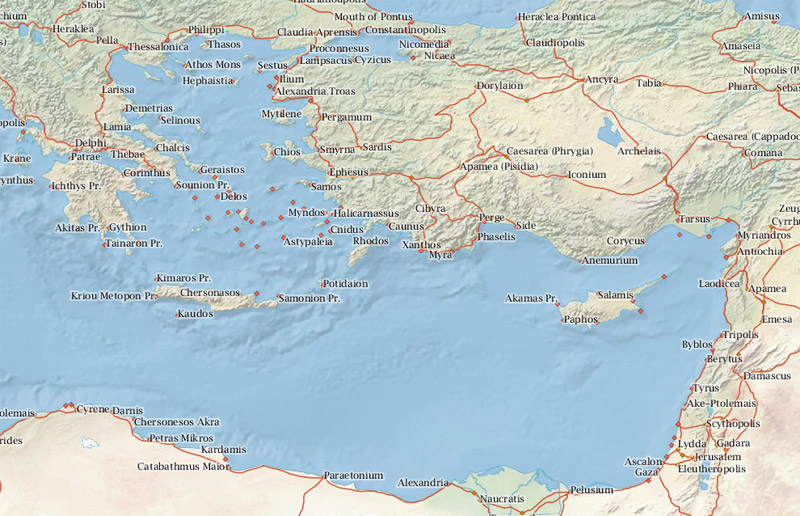
The apostle Paul went on three missionary journeys from A.D. 46 to 57, traveling around much of Asia Minor and Greece. In 60, he was also taken to Rome. ORBIS allows us to calculate how long these journeys would have taken in pure travel time (excluding time spent at each destination) and how much they would have cost.
* Ship travel only. According to Wikipedia, the denarius from 200, used here, is roughly 22% weaker than a denarius from the mid-first-century.
I conclude a few things from this exercise:
- The journeys get progressively costlier as more of each journey happens by ship. Sailing is fast but expensive—of course, Paul and his companions may not have had to pay the full fare.
- I like to imagine that Paul’s overnight escape from Thessalonica to Berea was partially by riverboat (though the costs above assume it was by road).
- Not much of the route of Paul’s journey is in doubt—Luke describes the trips pretty precisely in Acts. About the only question is whether Paul traveled from Berea to Athens by ship or by road. The above costs follow the ESV Study Bible and assume it was by ship.
For more about Paul’s missionary journeys , Dale Bargmann has written a good walkthrough with maps and photos.
Download the raw data (Excel).
This entry was posted on Thursday, July 5th, 2012 at 8:48 pm and is filed under Geo . You can follow any responses to this entry through the RSS 2.0 feed. Both comments and pings are currently closed.
One Response to “Calculating the Time and Cost of Paul’s Missionary Journeys”
[…] blog post by OpenBible.Info called “Calculating the Time and Cost of Paul’s Missionary Journeys” gives further information about the tool. The model is really intense as “it models […]
Unless otherwise indicated, all content is licensed under a Creative Commons Attribution License . All Scripture quotations, unless otherwise indicated, are taken from The Holy Bible, English Standard Version. Copyright ©2001 by Crossway Bibles , a publishing ministry of Good News Publishers. Contact me: openbibleinfo (at) gmail.com.
Paul’s Missionary Journeys: A Map-Based Study of His Travels

The Apostle Paul is one of the most important figures in the New Testament, and his missionary journeys played a key role in spreading Christianity throughout the Mediterranean world. By exploring these journeys through maps and geography, we can gain a deeper understanding of Paul's travels and the impact they had on the early Christian church.
Paul's first missionary journey began in the city of Antioch, in modern-day Turkey. From there, he traveled to Cyprus and then on to cities in modern-day Turkey, including Iconium, Lystra, and Derbe. Paul faced many challenges during this journey, including opposition from local Jews and persecution from Roman authorities. Despite these challenges, Paul's preaching was successful in converting many people to Christianity.
Paul's second missionary journey took him to Greece, where he traveled to cities like Athens and Corinth. He also returned to some of the cities he visited on his first journey, such as Philippi and Thessalonica. During this journey, Paul faced many challenges, including opposition from local authorities and a split with his fellow missionary, Barnabas.
Paul's third missionary journey was focused on strengthening the churches he had previously established. He traveled to cities in modern-day Turkey, Greece, and Macedonia, including Ephesus, Thessalonica, and Corinth. During this journey, Paul continued to face opposition and persecution, but his preaching was successful in converting many people to Christianity.
In addition to these three journeys, Paul also traveled to Rome as a prisoner, where he was eventually executed for his beliefs. By exploring Paul's journeys through maps and geography, we can gain a deeper understanding of the challenges he faced and the impact his preaching had on the early Christian church.
Through mapping and exploring Paul's journeys , we can gain a better understanding of the history and culture of the Mediterranean world during the first century AD. We can also gain a deeper appreciation for the impact that Paul's preaching had on the early Christian church, and the lasting legacy of his work. Whether we are religious or not, studying Paul's journeys through maps is a fascinating way to learn about the early history of Christianity and the world in which it developed.
Related Posts

How to Easily Download Videos from Reddit: A Step-by-Step Guide
Reddit is a treasure trove of content, starting from pleasing videos and insightful discussions to hilarious GIFs and beautiful photos.... Read More

Church Platform Chairs: A Comprehensive Guide
Church platform chairs play a critical role in the design and functionality of worship spaces. These chairs are not just... Read More

Top 10 Essential Tips for a Successful Home Remodeling Project
Embarking on a home remodeling project can be both exciting and daunting. Whether you're updating a single room or undertaking... Read More

Brow Lamination Toronto & Beauty Through the Ages: A Fascinating Journey
The Art of Beauty: From Ancient Egyptians to brow lamination Toronto Have you ever wondered how our ideas approximately beauty have... Read More
How to go to Heaven
How to get right with god.

What happened on Paul’s voyage to Rome?
For further study, related articles, subscribe to the, question of the week.
Get our Question of the Week delivered right to your inbox!


Paul’s Second Missionary Journey: Key Points, Maps, And Lessons
Categories Bible Study Topics
In this article, we will explore Paul’s second missionary journey looking at key points, locations, lessons we can learn, and a map of his journey.
In the book of Acts, we read the story of the beginning of the early church and the role the apostles played. One prominent character in the book of Acts is Paul, who first persecuted the church, but became a significant role player in evangelizing the gospel and undertook several missionary journeys. Let’s consider some key points and lessons from his second journey.
We read all about Paul’s second missionary journey in Acts 15:36-18:22. Although the purpose of the journey was originally to revisit the new believers from his first journey, Paul was led by the Holy Spirit to avoid Asia and rather preach the gospel in new areas, especially Greece.
The primary purpose of any missionary journey is to reach and save the lost, and Paul’s second missionary journey was no exception. Paul preached the gospel to many people and even debated the gospel with Greek philosophers in Athens.
He saw the salvation of many across the European continent. Paul and Silas, his companion on this journey, were also imprisoned during the journey.
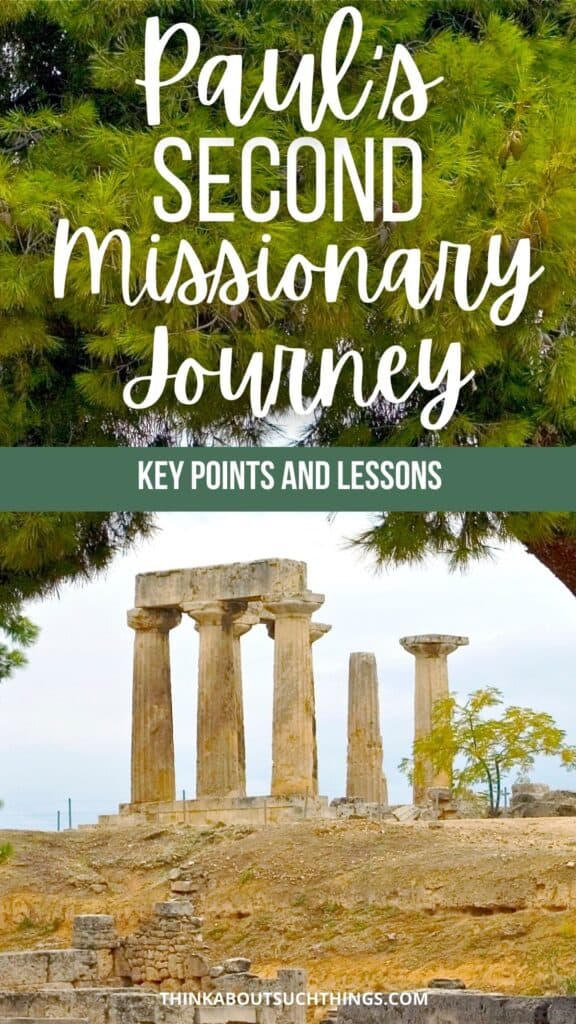
Before we get started, I do want to give a big thank you to Free Bible Images for letting me use their images of Paul’s journey.
What Happened On Paul’s Second Missionary Journey?
Paul’s second missionary journey lasted approximately 3 years, from 49 – 51 AD. After his first journey, he spent over a year in Antioch before setting out again. Paul asked Barnabas to accompany him, but a disagreement on whether Mark should join them led to them parting ways.
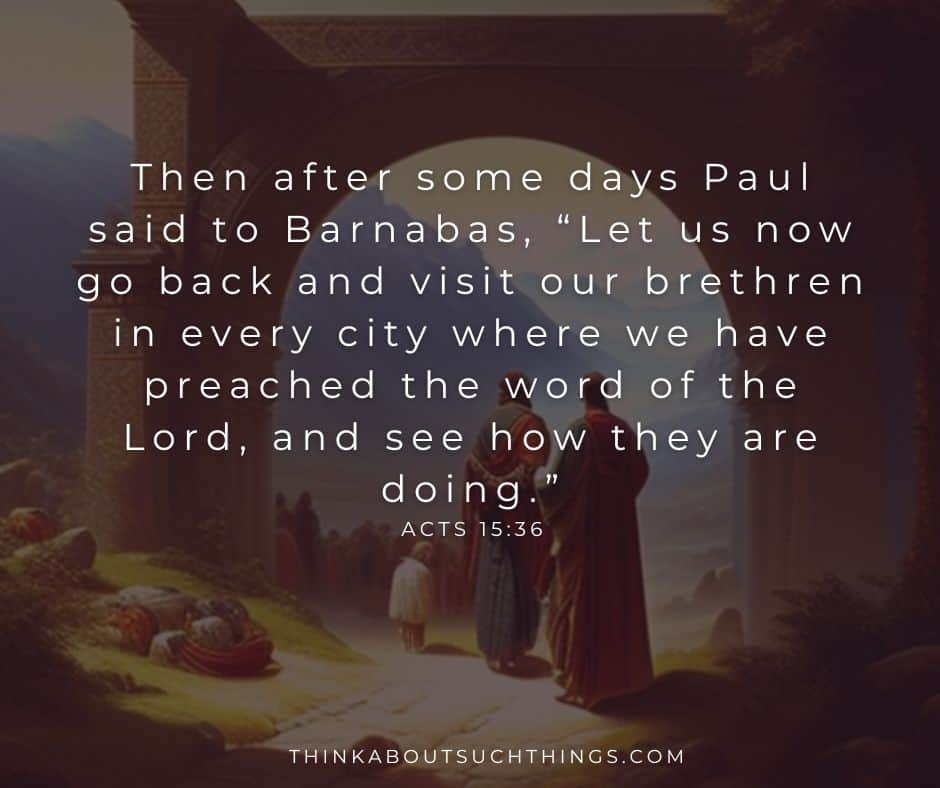
Therefore, Paul took Silas on this journey, along with others who joined him. As for Barnabas, him and Mark sailed to Cyprus to minister to the believers that they brought to Christ in Paul’s 1st missionary journey.
During their second missionary journey, Paul and his team visited many towns that had originally visited on their first journey. In this second round, many Jews and gentiles converted to Christianity.
A key thing to note is that Paul first met Timothy in Lystra. This young believer joined Paul and Silas. As the son of a Greek father and Jewish mother and being uncircumcised, Timothy was regarded as disrespecting his Jewish heritage by the Jews.
For this reason, Paul circumcised him, despite it being agreed that gentiles did not need to be circumcised to be Christians.
They traveled through Tarsus, Derbe, and Lystra, from where they headed to Troas.
In Troas, Paul’s original goal of revisiting the churches planted during his first missionary journey was altered. The Holy Spirit closed a door and prevented Paul from speaking in Asia and, through a vision, led the team to Macedonia, in the north of Greece.
In Philippi, the team went to the riverside on the Sabbath, where the Jews would meet. There they found a wealthy merchant who sold purple cloth named Lydia , who accepted the gospel. Lydia and her family converted to Christianity. The team stayed with her in her home for a while.
While still in Philippi, Paul freed a slave girl of a demon, used by her owners to generate an income through fortune telling.
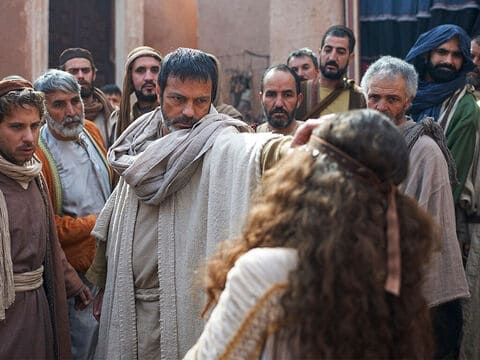
When the owners realized this, they took them to the magistrate, who had them flogged and imprisoned. At midnight in prison, while praying and singing psalms, an earthquake opened the prison doors and released their bonds!
When the prison guard noticed the doors were open, he thought all the prisoners had escaped and wanted to commit suicide. However, Paul spoke to him and told him they were all still there. The guard asked about their God, and Paul witnessed to him. The guard and his family believed and were baptized.
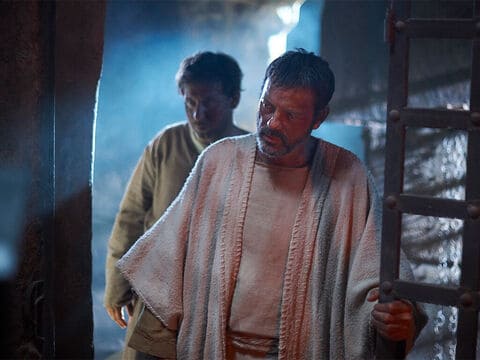
When they were released, Paul and Silas refused to leave until they received an apology from the town leaders. The leaders were shocked and came down to personally escort them out of town after learning they were Roman citizens. As Roman citizens, Paul and Silas were entitled to a trial before flogging and imprisonment.
Thessalonica
And some of them were persuaded to believe and joined Paul and Silas, along with a large number of the God-fearing Greeks and many of the leading women. – Acts 17:4 AMP
After their release from prison, Paul and his team traveled through Amphipolis and Apollonia to Thessalonica.
In Thessalonica, Paul and Silas preached the gospel to the Jews, but several refused to accept it. They also preached to gentiles and women, many of whom believed, infuriating the Jews. These non-believers then started a mob against them, which caused them to flee to Berea.
It is said in Acts 17 that the Bereans were nobler in character than the Thessalonians. Because they took what Paul said and went and examined the Scripture. They found what Paul was saying was true, and because of that man, Jews and Greeks were saved.
But word got out to those who caused problems in Thessalonica and went to Berea to stir up a mob there as well. Because of that, they sent Paul away to the coast, where he headed to Athens.
Silas and Timothy didn’t accompany him but stayed in Berea.
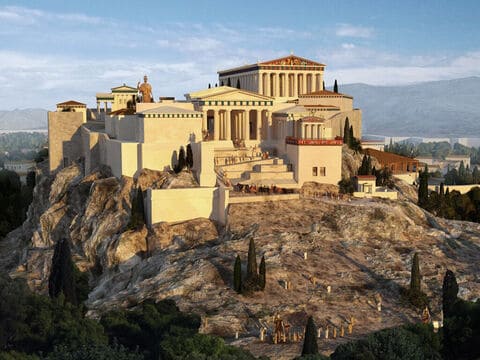
In Athens, Paul gave a famous speech to the Athenians at the Areopagus or the Hill of Ares. He had been preaching in the synagogues and marketplaces of Athens, where he had encountered some Epicurean and Stoic philosophers who were intrigued by his teachings.
They invited him to speak at the Areopagus, which was a place where philosophers and intellectuals would gather to discuss ideas.
In his speech, Paul spoke about the unknown God whom the Athenians had erected an altar to, and explained that this God was the one true God who had created everything. He also spoke about the resurrection of Jesus, which was a new and controversial idea to the Athenians.
While some Athenians were interested in what Paul had to say, others mocked him and dismissed his teachings. After his speech, Paul left Athens and continued on his journey.
Now the Lord spoke to Paul in the night by a vision, “Do not be afraid, but speak, and do not keep silent; 10 for I am with you, and no one will attack you to hurt you; for I have many people in this city.” 11 And he continued there a year and six months, teaching the word of God among them. – Acts 18:9-11 NKJV
Paul spent a significant amount of time in Corinth during his Second Missionary Journey. He arrived in around 50 AD, and stayed there for approximately 18 months, which made it one of the longest periods he spent in any one place during his missionary journeys. Silas and Timothy meet up with him there as well.
In Corinth, Paul worked as a tentmaker during the day and preached in the synagogues on the Sabbath. He was able to gain the support of some of the Jewish community in Corinth but also faced opposition from others who were resistant to his message.
One of the most significant events during Paul’s time in Corinth was his church establishment there. He worked closely with several other individuals, including Aquila and Priscilla, who became important figures in the early Christian church.
Paul faced many challenges during his time in Corinth, including physical threats and opposition from local authorities. Despite these challenges, however, he was able to establish a strong Christian community there and continued to spread the gospel throughout the region.
From there, they sailed to Ephesus, leaving Aquila, Priscilla , and Apollos there. Then returned to Caesarea and Jerusalem before returning back to Antioch in Syria.
Check Out The Other Missionary Journeys Of Paul

Maps of Paul’s 2nd Missionary Journey
As you can tell, Paul’s second journey is longer than his first, with LOTS of stops. We have covered the major events in these cities, but seeing a map is always nice. It helps give you a visual of where he and his team went.
Down below, you will find a map of Pauls’s 2nd journey route.
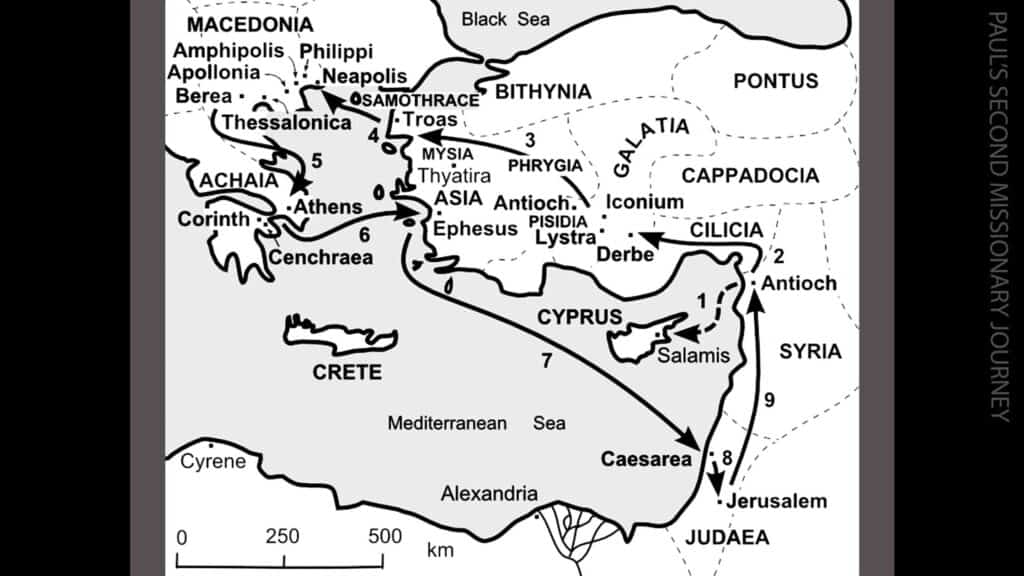
This map below gives you a nice overview of where key locations were in the Aegean sea .
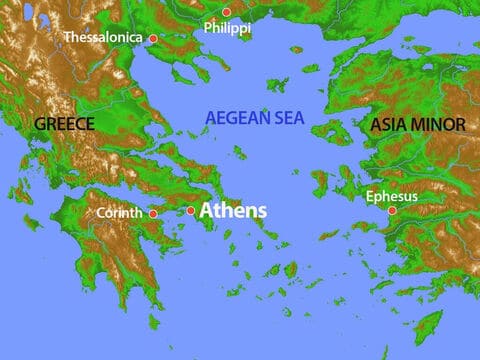
Key People On Paul’s 2nd Journey
Now, let’s take a look at the key players on this trip:
Paul, also known as Saul of Tarsus, was one of the most influential leaders in the New Testament. He was born a Jew and was a Pharisee. He later converted to Christianity after experiencing a vision of Jesus Christ while on his way to Damascus.
Paul played a crucial role in spreading the teachings of Christianity throughout the Roman Empire and authored many of the epistles or letters found in the New Testament. He faced numerous challenges and persecution as he traveled to various cities to share his faith.
Silas was a Jewish leader in Jerusalem and played an important role in the early Christian church. Silas was known for his eloquent speaking and persuasion skills, which made him a valuable asset to the apostle Paul on his missionary journeys.
Timothy is a young and faithful disciple of Paul, who played a significant role in spreading the gospel message throughout the ancient world. As an important figure in the early Christian church, Timothy was mentioned frequently in Paul’s letters to the Corinthians, Philippians, and Thessalonians, where he was described as a trusted co-worker and a dedicated leader.
Priscilla and Aquilla
Priscilla and Aquila were a couple who played a prominent role in the early Christian community. They are mentioned several times in the New Testament, including in Acts and Romans. Priscilla is believed to have been a Jewish woman from Rome, while her husband Aquila was likely of Jewish and Greek heritage.
Together, they were tent makers and worked alongside the Apostle Paul in his ministry. Priscilla and Aquila not only supported Paul financially, but they also taught and mentored other believers. Their partnership in both work and ministry sets an excellent example for couples and demonstrates the significant impact a husband and wife can make together in serving God.
Luke was a physician and companion of the apostle Paul. He was also one of the four Gospel writers, along with Matthew, Mark, and John. He also wrote the book of Acts.
FAQ About Paul’s Second Missionary Journey
You can read about the Apostle Paul’s second journey in Acts 15:36-18:22.
The second journey took place between 49-51AD.
It varies throughout the journey, but Silas, Timothy, Priscilla, and Aquilla accompany the apostle Paul.
Paul and his companions traveled through Syria, Turkey, Greece, and Jerusalem.
Paul traveled around 2,800 miles, making his first journey of 1,400 look like a cakewalk!
Important Lessons From Paul’s Second Missionary Journey
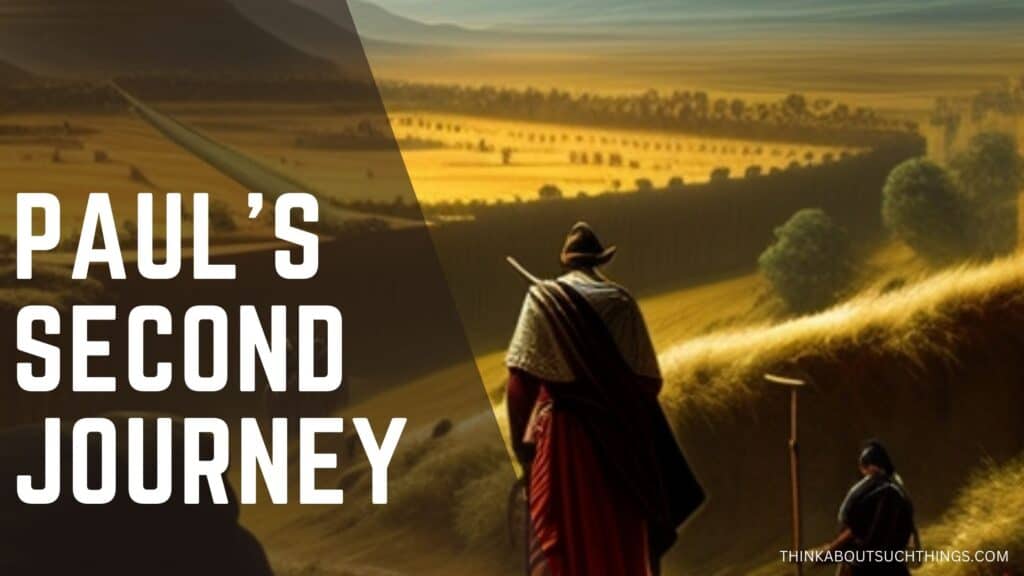
There are many lessons that Christian believers can learn from Paul’s life and letters. But here are few that I have found while studying his second journey.
- Consideration for the beliefs of fellow Christians – Through the circumcision of Timothy, Paul shows that Christians should consider the beliefs of fellow Christians to be able to evangelize to them. Although the circumcision was unnecessary, Timothy would not have been able to preach in the synagogues if he wasn’t circumcised, thus enabling him to reach more people.
- Be open to the prompting of the Holy Spirit – If Paul weren’t open to the prompting of the Holy Spirit and stuck to his original plans, many people who came to faith in Christ would not have been reached. As Christians, our plans should always be subjected to the will and plans of God.
- Praise God in all circumstances – Paul and Silas prayed and worshipped God while imprisoned. Christians are also encouraged to be steadfast in prayer (Colossians 4:2) and to praise God in all circumstances (1 Thessalonians 5:16-18).
- Always look out for persons to evangelize – As Paul traveled, he preached the gospel to whoever was prepared to listen. He preached the gospel to the prison guard in Philippi, saving his whole family, and even debated Christianity with Greek philosophers in Athens.
- Be prepared to do the right thing, even if it would cost you your freedom – Paul must have known that driving the fortune-telling demon out of the slave girl in Philippi would upset her owners, but he was prepared to do the right thing, even if it would land him in prison.
- We can talk to anyone about Jesus – Paul’s time in Athens is significant because it illustrates how he adapted his message to different audiences and engaged with people of different cultures and beliefs. Even though it was hard ground Paul was willing to try to reach the Greeks.
On Paul’s second missionary journey from 49-51 AD, he set out to revisit the churches planted during his first missionary journey. The Holy Spirit led him in a different direction, and he ended up preaching the gospel to multitudes in and around Greece and saw the salvation of many. Paul, with his resilience and connection to the will of God, is an excellent example to Christians today.
If you would like to leave me a comment below I would love to hear from my readers!

Melissa is a passionate minister, speaker and an ongoing learner of the Bible. She has been involved in church and vocational ministry for over 18 years. And is the founder of Think About Such Things. She has the heart to equip the saints by helping them get into the Word of God and fall more in love with Jesus. She also enjoys family, cooking, and reading.
She has spoken in churches in California, Oregon, Texas, and Mexico and has been featured in Guidepost Magazine and All Recipes Magazine. Read More…
I accept the Privacy Policy
- Travel/Study
BIBLE HISTORY DAILY
Paul’s first missionary journey through perga and pisidian antioch.
Explore the route
Paul’s first missionary journey took him from Cyprus into the heart of Anatolia. Why did Paul and Barnabas choose the treacherous path through Perga to Pisidian Antioch? In “ Why Perga? Paul’s Perilous Passage through Pisidia ” in the November/December 2013 issue of BAR , Mark R. Fairchild explores archaeological evidence of the likely presence of Jewish communities on the way.
[rev_slider perga]-->
After sailing from Cyprus to the Turkish coast, Paul and Barnabas visit the city of Perga before traveling to Pisidian Antioch and other cities on the Anatolian interior. When they head back to the coast, the travelers follow the same route. Why did they choose such a treacherous route for Paul’s first missionary journey? Mark R. Fairchild explores unexcavated sites along the Kestros River Valley, exposing evidence of Jewish populations en route .
Become a Member of Biblical Archaeology Society Now and Get More Than Half Off the Regular Price of the All-Access Pass!
Explore the world’s most intriguing biblical scholarship.
Dig into more than 9,000 articles in the Biblical Archaeology Society’s vast library plus much more with an All-Access pass.

Acts indicates that Paul deliberately traveled to cities with Jewish populations. Perga was a major city, and the presence of a Jewish community there made it an ideal base for Paul’s first missionary journey through Anatolia. Fairchild argues that Paul and Barnabas could have taken an easy but roundabout path along established Roman roads, but opted to travel along the rugged Kestros Valley because of the hospitality of local Jewish communities.

Paul and Barnabas would have sailed from Cyprus to one of these ports on the Turkish coast before traveling to Perga.

Mark R. Fairchild suggests that Paul traveled from Perga up the Kestros River Valley to Pisidian Antioch, the route indicated in green.
Subscribers : Read “ Why Perga? Paul’s Perilous Passage through Pisidia ” by Mark R. Fairchild as it appears in the November/December 2013 issue of BAR .

FREE ebook: Paul: Jewish Law and Early Christianity . Paul’s dual roles as a Christian missionary and a Pharisee.
Related reading in Bible History Daily :
Biblical Riot at Ephesus: The Archaeological Context
Galatians 3:28—Neither Jew nor Greek, Slave nor Free, Male and Female
The Quest for the Historical Paul
Barnabas: An Encouraging Early Church Leader
Visiting Turkey: Museums of Archaeology Dazzle
This Bible History Daily feature was originally published in November 2013.
Related Posts

Gospel of John Commentary: Who Wrote the Gospel of John and How Historical Is It?
By: BAS Staff

The Bethesda Pool, Site of One of Jesus’ Miracles

Souvenirs to Riot Over
By: John Drummond

Speaking in Tongues in the Bible
By: Megan Sauter
8 Responses
I love the details. I am somewhat concerned that we continue to say “Paul led the First Missionary Journey” when it was clearly led by Barnabas and Saul/Paul was an intern as was John Mark.
Barnabas went to recruit Saul from Tarsus and then included him in his study group at Antioch. When the Holy Spirit said, “Set aside Barnabas and Saul,” it was obvious that Barnabas was the head man. Later, of course, the pagans called Barnabas Zeus as the “top god” in Acts 14.
Fairchild’s map is rather inaccurate and not linked to the photos, which suggest that St P went via the ‘Royal road’ thru’ the Çandır canyon and the unnamed site at Sütçüler and Adada. If this is the case, he did not go to Sagalassos, which is far off the N-S route. Milyas is misplaced (if he means Milli, it is SW from Pednelissos), Cremna, Adada, Parlais and the important road junction at Gönen are unplaced and Eğirdir lake was in fact 2 lakes – Hoyran and Eğirdir – until recently.
[…] Paul’s First Missionary Journey through Perga and Pisidian Antioch […]
Mark, These are wonderful pictures of an area I haven’t yet visited. Is it possible to get permission to use for a Bible Study?
Madelon Maupin (Friend of Levant’s)
[…] Paul traveled to the heart of Anatolia. Take a look at the route of his missionary journey in a web-exclusive slideshow of photographs by BAR author Mark R. Fairchild. […]
Write a Reply or Comment Cancel reply
Your email address will not be published. Required fields are marked *
Recent Blog Posts

Should We Take Creation Stories in Genesis Literally?

Roman Crucifixion Methods Reveal the History of Crucifixion
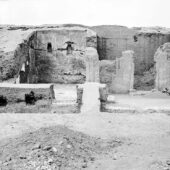
Is the World’s Oldest House Church in Dura-Europos?

The Origin of Sin and Death in the Bible
Must-read free ebooks.
The Dead Sea Scrolls: Past, Present, and Future

Biblical Peoples—The World of Ancient Israel

Who Was Jesus? Exploring the History of Jesus’ Life

Ancient Israel in Egypt and the Exodus
Want more bible history.
Sign up to receive our email newsletter and never miss an update.
By submitting above, you agree to our privacy policy .
All-Access Pass

Dig into the illuminating world of the Bible with a BAS All-Access Membership. Get your print subscription to BAR and your online access to the BAS Library—as well as FREE online talks and Travel/Study discounts. Start your journey into the biblical past today!
Signup for Bible History Daily to get updates!
Paul, Apostle of Christ
The Gospels are certainly the most important of the New Testament writings, but they were not the first to be composed. As early as the year A.D. 50, some young communities of former Gentiles were receiving Letters from an “apostle,” namely, Paul, who had not belonged to the Twelve or to the circle around Jesus. Of the great figures of newborn Christianity, this “first Christian author” is the most remarkable one known to us, and he remains such through the testimony he has left us in his writings.
Chronological Order of the Letters
Modern criticism has come to the following conclusions in this area.
A first series of Letters was written at intervals during the fifties and sixties; there is practically no one who doubts that Paul was their author.
— 1 and 2 Thessalonians: The first two Christian writings that have come down to us. They were surely written in Corinth between A.D. 50 and 52, in order to encourage a recently founded community and to clarify some points of doctrine (although some scholars have questioned the authorship of 2 Thessalonians).
— 1 and 2 Corinthians: Two Letters written in A.D. 56, during Paul’s time in Ephesus. They contain rather spirited interventions occasioned by disorders and divisions in the community.
— Philippians: A Letter that is especially cordial in tone. It is the first Letter that Paul wrote from prison and can be dated to A.D. 56, although others place it with the Letters of Paul’s Roman captivity between A.D. 61 and 63. We know that Paul was imprisoned more than once.
— Galatians: A fiery Letter to a Church in full crisis; probably written in A.D. 56 or 57.
— Romans: A lengthy theological writing, covering at greater length, and in a more serene tone, the same themes the writer had dealt with in the Letter to the Galatians. It may date from A.D. 57 or 58.
A second and later series of texts is known as the Captivity Letters (which may include the Letter to the Philippians, as noted a moment ago). They can be attributed to Paul, although a bit tentatively, and dated from A.D. 61 to 63, the period of his imprisonment in Rome.
— Colossians: A Letter that encourages authentic faith and authentic Christian life in face of the commingling of religions and new ideas.
— Philemon: A short note of recommendation for a fugitive slave.
— Ephesians: A circular Letter inspired by a profound theology and mysticism.
A third series of Letters is addressed no longer to communities but to individuals, pastors of souls, and is lavish with recommendations and guidelines for the exercise of their responsibilities. These are known as the Pastoral Letters and must be dated to A.D. 66 or 67 at the latest, if they are to be attributed to Paul. Some exegetes think the Letters may be the work of disciples and written around the eighties.
— 1 and 2 Timothy: Two Letters.
— Titus: One Letter.
Toward the end of the 1st century a final writing supposedly by Paul was in circulation, but the attribution is most uncertain. It was written by someone else who remains anonymous.
— Hebrews: A lengthy piece of theology and exhortation, written either just before the destruction of Jerusalem in A.D. 70 or much later, between A.D. 80 and 90.
Who Was Paul?
Until his conversion.
Saul was born around the beginning of the century, in Tarsus, the capital of Cilicia in Asia Minor, a little city but open to cultural influences and commercial exchanges between East and West. He was from a family of Diaspora Jews who belonged to the tribe of Benjamin and were intent on a strict observance of the religion of their forebears. They did not, however, reject all contact with the life and culture of the Empire; in fact, they had acquired Roman citizenship and thereby become the Paulus family.
In about A.D 36/37 a mysterious event changed the course of Saul’s life in an instant. The persecutor of Christians became the most ardent missionary of the Gospel.
On the road to Damascus, he had a vision that changed his life. He saw Christ, who revealed that he was totally one with all who believed in him: “Why are you persecuting me?” ( Acts 9:4 ).
After His Conversion
Paul underwent a radical turnaround. From then on, he did nothing but put into practice the unshakable certitude that he received on that day. His Letters set forth this conviction: Christ is living and reconciles human beings in his Spirit; salvation is given by him to the Gentile world and indeed to all peoples. His entire existence was henceforth seized by this mission. His life and thought were animated by an unconquerable love for Jesus.
Allowing Gentiles to become part of the Christian communities posed theoretical problems. Paul was present at the Council of Jerusalem in A.D. 48/49, which rendered liberating decisions on this point ( Acts 15 ; Gal 2:1-10 ).
Thereupon Paul traveled to the great urban centers of the Mediterranean world, proclaiming the Gospel of Jesus Christ and establishing churches, i.e., small groups of men and women, free people and slaves, Jews and Greeks, who believed in Christ. His plan was to go to the ends of the known world, possibly as far as the Spanish coast, by way of Rome. All the while, he nurtured the young Churches by his Letters and delegates, recalling the main lines of the Gospel—Jesus Christ is the only Savior.
We have no sure information on the subsequent course and end of Paul’s life. He would be executed at Rome on the Ostia Road (Via Ostiensis), probably in A.D. 66/67. Many, especially those who defend the attribution of the Captivity Letters to Paul, think that he had once again regained his freedom, had visited the Churches of Greece and Asia Minor, and perhaps had even gone to Spain. Arrested once again, he endured a harsh imprisonment.
The traditional order of the Letters, as seen in any Bible, is not based on chronology. Their order is primarily one of length, longest to shortest. In reading them, however, it is advantageous to follow the chronological order.
The Letter to the Romans
Human beings are justified through faith.
Paul wanted to visit Rome—the center of the universe in his day—on more than one occasion, but he was prevented from doing so (see Rom 1:13 ). Now, in the winter of A.D. 56–57, his third missionary journey has been completed and he has established the Church in the principal Mediterranean urban centers, from Jerusalem to Illyricum ( Rom 15:19 ). In addition, the great crises in Corinth and Galatia seem to have subsided.
Hence, Paul seeks new fields. The West calls to him, and he projects a missionary journey that will take him to the cities along the Spanish coastline. To get there he must pass through Rome (see Rom 15:22-23 ), and he looks for the welcome and assistance of the Christian community established in the capital. He will not be a stranger there. The Jewish community at Rome has more than 40,000 members and some fifteen synagogues. Moreover, the seed of the Gospel has already taken root in its midst. We will probably never know who were the first missionaries of Christ there. It may be that pilgrims from Rome were among the witnesses and converts on the day of Pentecost in the year A.D. 30.
In any case, merchants and travelers could surely have encountered the Gospel and the Church on their travels and in their business dealings and could then have become the promoters of a new community at Rome. St. Peter himself was there for a time and eventually suffered martyrdom under the infamous Emperor Nero, but doubtless his coming took place later than the date of this Letter.
The Church of Rome seems to have developed rapidly. In the year A.D. 49 an edict of Emperor Claudius expelled the Jews. Jewish Christians like Priscilla and Aquila were also affected; they found refuge and work in Greece and Asia (see Acts 18:2 , 18 , 26 ; 1 Cor 16:19 ). As a result, converts from paganism became the majority of Christians in Rome. This brought new problems and some difficulties, especially when the exiles returned after two or three years.
In order to announce his coming, Paul dictated a Letter to his secretary, Tertius ( Rom 16:22 ), and entrusted it, apparently, to Phoebe, “a deaconess of the Church at Cenchreae” ( Rom 16:1 ), who was about to travel to Rome. But if he wanted simply to announce his arrival, why did he send so lengthy a Letter? It is probable that his person and ideas were sufficiently well known in Rome and that there was debate over the positions he had taken. Writing thus to a community, Paul gave free expression to the main concerns that preoccupied him concerning the life of the Church and, above all, concerning faith. To facilitate the reading we can group its themes around three main centers: the necessity of faith, the riches of the faith, the demands of the faith.
We shall discover, contained in these central ideas, the most profound intuitions regarding the realism of the incarnation ( Rom 1:3-4 ), justification and redemption ( Rom 3:21-26 ; 8:2-4 ), the universality of sin and salvation ( Rom 5:12-19 ), the Paschal Mystery present in Baptism ( Rom 6:2-5 ), the hope of Christians and the future of the universe ( Rom 8:19-23 ), the divine sonship ( Rom 8:14-17 ), the certainty of salvation ( Rom 8:28-39 ), the mystery of Israel and the theology of history ( Rom 9–11 ), spiritual worship ( Rom 12:12 ), and the new priesthood ( Rom 15:15-16 ).
Paul sets forth on a theological level what Jesus himself signified and practiced when he mingled with tax collectors and sinners; he did not condone what they did, but he affirmed that justice is a grace of the Father and that it is not acquired by a person’s moral, legal, or cultural effort—no matter how scrupulous that might be. God’s love is offered to everyone by God; it is he who sets free, and it is up to each person to embrace this liberation as a source of life. The redemption and salvation of human beings is of another order than that of social, personal, and historical situations. It pertains to a human transformation inaugurated in Jesus.
Hence, if such liberation is given in the mystery of Christ, in Baptism that enables one to participate in it, and in faith in his Gospel, what is the value of the Law and the whole Old Testament and what is the destiny of Israel? This is a question that needs an answer to show the fundamental unity of revelation, of the promise of fulfillment in Christ. Such an answer is even more necessary since non-Jewish Christians ran the risk of ignoring the plan of God inaugurated in Creation and the time of preparation that constitutes the Old Testament and even looking down on Jewish Christians. It is an answer that Paul carefully provides in this Letter ( Rom 9:1—11:36 ).
The Letter presents the essence of Paul’s message and his mission. It is regarded as the first formulation of Christian theology. Yet its tranquil tone is far different from the stormy character of the Letter to the Galatians whose themes it amplifies. Nonetheless, we sense herein the stirrings of an impassioned soul, for example beneath some uncalled-for blow ( Rom 2:17ff ), in the trust of being in God’s grace (ch. 8 ), in the convert’s compassion for those of his race ( Rom 9:1-15 ; 10:1 ; 11:14-16 ), and in the enthusiasm of the Apostle of Christ ( Rom 11:33-36 ). The Letter to the Romans also distinguishes itself by its literary variety. In its construction, Paul makes use of liturgical pieces and hymns; he follows the expository style of the rabbis or employs the methods of orators of his day. All of this adds up to an exceptional example of Paul’s work.
Did Paul really reach Rome? Yes, but later than he had hoped. In the spring of A.D. 58, he arrived at Jerusalem with the funds collected for the poor Christians of the Mother Church ( 2 Cor 8–9 ). He was arrested in the temple and spent two years in custody at Caesarea before appealing to Caesar as a Roman citizen. In the spring of the year A.D. 60, Paul, apostle and prisoner of Jesus Christ, entered Rome ( Acts 28:16 ) and was welcomed by the Christian community there.
The Letter to the Romans may be divided as follows:
Prologue ( 1:1-17 )
I: Justification through Faith in Jesus ( 1:18—4:25 )
II: Faith, the Riches of Life ( 5:1—11:36 )
III: The Need for Faith in Daily Life ( 12:1—15:13 )
Epilogue: ( 15:14—16:27 )
What Happened on Paul's Missionary Journeys?

I didn’t go to church much as a child. I only have a few memories of the few times I did go. One was trying to endure the music portion of the service and then secondly trying to keep myself occupied while some guy was up front talking to us about Jesus and some dude named Paul. Being the nerd that I am, I remember being intrigued by colored maps in the back of my Bible. One in particular that I remember was one with three different colored arrows with the heading at top: Paul’s Missionary Journeys.
I don’t know if I really understood who Paul was or even what a missionary journey was, but I thought the map was cool and it held my attention for a few moments. Perhaps you’re wondering who exactly Paul is and what his missionary journeys were.
To put simply, Paul was a guy whose life was radically changed by Jesus Christ. In the early part of his life, he was on a different kind of journey. He went throughout much of his land trying to tell people to ignore Jesus — and he was even instrumental in trying to hurt people who followed Jesus. But on one of these trips his life was changed, and now he went all across the known world to tell people about the goodness of Jesus. He went on three (or maybe four) big missionary journeys that we have record of in the New Testament.
Photo credit: Unsplash
How Many Missionary Journeys Did Paul Make?

First, it would be helpful for us to establish a definition of a missionary journey. In order for something to be called a missionary journey, there needs to be some sort of explicit mission or purpose, and a type of commissioning. Paul was always doing ministry. In one sense you could say that from the point of his conversion his life was one big missionary journey. But to be specific we would need to have some sort of specific mission and setting apart for this particular task. So how many times did this happen?
It’s possible that Paul went on more missionary journeys than what is recorded in the New Testament. But most believe he had either three or four main journeys. The Bible that I was using as kid was an NIV Study Bible. In that particular map there are three missionary journeys marked, but also a fourth arrow that outlines his trip to Rome. Some would also consider a fourth missionary journey to Spain.
We know that there are three missionary journeys in the book of Acts. We also know that Paul did travel to Rome as a prisoner (should this be considered a missionary journey, though?) We also know that there is mention of a fourth missionary journey to Spain. There are some hints throughout the New Testament that this journey was completed, and early Christian history does seem to give some evidence to this happening. But we cannot know for certain.
It is probably best to confess that we do not know for certain how many missionary journeys he took. But for our purpose we will consider his three major missionary trips.
Photo credit: ©Getty Images/mirsad sarajlic
What Happened on These Journeys?

You can read about Paul’s 1 st missionary journey in Acts 13-14 . On this trip he, and Barnabas, were commissioned from Antioch. The goal of this mission seems to have been to preach in Jewish synagogues and attempt to convert Jews. They began in Cyrus and went through Pamphylia, Pisidia, and Lycaonia. They then went through Iconium, Lystra, and Derbe and circled back around to Antioch.
In Cyprus the proconsul was converted after Paul pronounced a curse upon a Jewish sorcerer named Bar-Jesus and made him blind. They were also successful in Pisidian Antioch where many Jews and Gentiles were converted before some Jews incited a riot against Paul and Barnabas and drove them out of the city. Nevertheless “the word of the Lord spread through the whole region” (13:49).
They were met with the same mixture of success and opposition in the other cities as well. Perhaps one of the most significant things which came from this journey was the massive number of Gentiles who came to the faith . As they shared their story back in Antioch, this was an emphasis (see Acts 14:27-28 ).
Paul’s 2 nd missionary journey is recorded in Acts 15:36-18 :22. After a short stay in Antioch, Paul wanted to go with Barnabas on another journey. But a sharp dispute arose (with John Mark being the center of the debate) and the two split. Barnabas ended up back in Cyprus with John Mark and Paul took a different route throughout Asia Minor with Silas. It was on this journey that Paul would be joined by Timothy.
He would also have ministry in Athens, Philippi, Thessalonica, and Corinth. As you might have recognized by some of these names, it was through this missionary journey that Paul began his relationship with many of the churches to whom he would eventually write letters. The purpose of these journeys was to establish churches and to encourage those who were already followers of Jesus, but they also saw many converts as well.
Paul’s 3 rd missionary journey begins in Acts 18:23 and goes through Acts 20:38 . Paul’s third journey was essentially the same as his second journey but in reverse order. The narrative in Acts focuses on the church in Ephesus (another church that would receive a letter now in the New Testament). It was here also that connections were made to Galatia as well.
Though these journeys were filled with opposition and difficulty, they also experienced much success. The gospel spread all throughout the Roman Empire and churches were firmly established through these missionary efforts. Not to mention that the Lord used Paul’s correspondence during these journeys (and because of these) to inspire many books of the New Testament.
Photo credit: ©Getty Images/Freedom007
How Far Did Paul Travel on His Journeys?

Have you ever heard that song “500 Miles” by The Proclaimers? Well, Paul journeyed far more than 500 miles to take the gospel to the nations. Even though he was able to use the Roman Road for easier access to the cities, it is still estimated that Paul traveled well over 10,000 miles.
One person has taken it upon themselves to estimate the cost and travel time of Paul’s three journeys and his trip to Rome. He concluded that it would have taken him 281 days of travel time, journeying 10,282 miles at a cost of 1,731 denarii (day’s wages) for each person to sail on the trip.
When you factor in the toll these journeys took upon Paul’s person, his missionary endeavors were far-reaching, consequential, and costly. But you likely have heard the gospel today because of these efforts.
Did Paul Travel with Anyone?
Paul did not travel alone on any of these journeys. On his first missionary journey, he went with Barnabas. On his second journey he took Silas, and eventually Timothy joined them. While in Corinth on this journey he met Aquila and Priscilla and he took them with him on his third journey to Ephesus. Timothy and Erastus had gone ahead of him on this journey as well — so there would be those who greeted him while there. It is also quite likely that Luke accompanied Paul on some of these journeys. In Acts there are several sections where Luke says “we,” indicating that he was physically present.
Gospel mission is never a solo enterprise. Throughout the New Testament we see disciples traveling in teams. Even in the gospel account when Jesus sent out the earliest disciples, he sent them two by two. It’s likely that part of the reasoning for this is the Old Testament standard of having two witnesses. Paul never traveled alone on a missionary journey.
Photo credit: ©Getty Images/Klaus Vedfelt
What Happened to Paul at the End of His Life?

When we begin discussing the end of Paul’s life, things get a bit cloudier. We know that Paul is alive at the end of Acts. Everything leading up to that point (the three journeys and travel to Rome) we can be fairly certain about. But after the book of Acts ends, we have to piece together scant evidence and rely upon church tradition to establish his end of days. It is almost universally accepted that he died a martyr’s death, but when and where is up for debate.
As the book of Acts ends, Paul is in prison awaiting a verdict. Many believe that he was released on this occasion. There are details in the pastoral epistles (1 and 2 Timothy, Titus) that do not fit with his having died in Rome during the time period of Acts 28 . From here, debate ensues about whether or not Paul traveled to Spain and completed the task he mentioned in Romans 15:23-29 . Early church tradition has him going to Spain and completing a missionary journey there.
Eusebius claims that Paul was beheaded at the order of Nero shortly after Rome was burned in a fire. (This is where tradition has Peter meeting his end as well). But we cannot know for certain what happened at the end of Paul’s life. We know he continued writing, we know he spent more time in prison, and we know that he kept the faith . 2 Timothy 4:6-8 is the capstone on Paul’s life:
“ For I am already being poured out like a drink offering, and the time for my departure is near. I have fought the good fight, I have finished the race, I have kept the faith. Now there is in store for me the crown of righteousness, which the Lord, the righteous Judge, will award to me on that day — and not only to me, but also to all who have longed for his appearing.”
Photo credit: ©Getty Images/Rattankun Thongbun
Mike Leake is husband to Nikki and father to Isaiah and Hannah. He is also the lead pastor at Calvary of Neosho, MO. Mike is the author of Torn to Heal and Jesus Is All You Need . His writing home is http://mikeleake.net and you can connect with him on Twitter @mikeleake. Mike has a new writing project at Proverbs4Today .
Apostle Paul's Final Missionary Journey Map
In the Spring of the year, in Rome, the apostle Paul is acquitted of the charges against him and is set free. He sails from Rome to the island of Crete in order to meet with Titus (Titus 1:5). He then leaves Titus in Crete and sails to Nicopolis (Titus 1:5, 3:12). From Nicopolis he writes the New Testament books of 1Timothy and Titus.
63 A.D. to 67 A.D.
Paul continues his mission of spreading the gospel by traveling to Spain. In the winter of 57 A.D. He writes to the church at Rome regarding his planned travel to this western part of the empire.
For this reason also, I have been hindered many times from coming to you (the believers in Rome Paul had never visited). But now, there being no place in these regions that has not heard the gospel, and having a great desire to come to you for many years whenever I may go to Spain, I will come to you because I hope to see you while passing through Rome . . . Therefore, when I have finished this task (delivering aid to poor saints in Jerusalem), and have safely delivered into their hands the fruit that was collected, I will set off toward Spain and will come to you (Romans 15:22 - 24, 28, HBFV).

There is also evidence, though not conclusive, that Paul also preached the gospel in Britain (Britannia).
68 A.D. (January or February)
Paul is likely arrested and imprisoned in Rome in the early part of 68 A.D. In the spring he writes his last book, 2Timothy, addressed to his greatest friend ( Life and Epistles of St. Paul , appendix III).
Paul is beheaded, under Roman Emperor Nero, around May or June. His death occurs just before Nero's suicide on June 9, 68 A.D. in Greece. He is about 66 years old.
Nero is the first emperor of the Roman Empire to actively persecute and kill Christians. Rome will carry out at least ten major efforts to exterminate Christians and expunge Christianity from the empire. The persecutions first start under Nero in 67 A.D. and continue until 313.
Paul's impact on Christianity will be enormous. During his ministry he wrote fourteen books of the Bible and carried out no less than five missionary journeys. He paid a price, however, for his strong devotion to God and the truth by spending a total of five of his ministry years in prison. He remained faithful to the very end of his life.
Series References The Life and Epistles of St. Paul by Conybeare and Howson Holy Bible in its Original Order, Second Edition, Chronology V
Quotes in this series taken from Holy Bible in Its Original Order (HBFV) unless noted.

Acts 27:5 meaning
As Paul continues his tumultuous journey to Rome, his experiences highlight both the challenges of travel in ancient times and the providence of God that guides His servants. This particular verse marks an important stage in this voyage, where Paul and his companions shifted from a ship that had faced adversity to one that would carry them further toward their destination. The mention of their embarkation on an Alexandrian ship underscores not just the logistical aspects of their travel but also sets the stage for the dramatic events that follow.
In Acts 27:5, we see a significant transition that prepares us for understanding the complexities of maritime travel during this period, including the geopolitical practices of grain transport essential to Rome and the risks that accompanied such endeavors. Paul’s journey illustrates God’s overarching plan, where even seeming misfortunes can align with divine purpose. Through Paul's steadfast faith amidst danger, believers are reminded of God's sovereignty and care, reinforcing that the outcomes of our journeys—both literal and metaphorical—are shaped by His divine hand.
Reflecting on this passage, we are encouraged to trust God's guidance, especially in times of adversity.
This quick synopsis was autogenerated by AI. If there is an issue with this summary please let us know by emailing: [email protected]
Other Relevant Commentaries:
- Acts 5:27-32 meaning . The high priest interrogates the apostles. He asks them why they are teaching in Jesus's name throughout Jerusalem. He reminds them that he had already threatened Peter and John to stop this. He also asks why the apostles keep accusing them of being responsible for Jesus's death. The apostles reply that they obey God, not men. They speak their message to the Council, that God resurrected Jesus, and exalted Him as Prince and Savior to sit at the right hand of God's throne. The apostles testify that they have witnessed these acts of God, and that the Holy Spirit is with them.
- Matthew 27:3-5 meaning . Judas's Remorse: After Jesus was condemned, Judas regrets his betrayal, and he tries to return the thirty pieces of silver. The chief priests refuse to accept it. Judas throws it at their feet and runs away before killing himself.
- Matthew 5:27-28 meaning . Jesus teaches that the external sin of adultery and the internal sin of lust are both violations of God’s Covenant.
- Lebron James
- Transfer News
- Premier League
- Champions League
- Lionel Messi
- Cristiano Ronaldo
- Saudi Pro League
- Anthony Joshua
- Oleksandr Usyk
- Conor McGregor
- Khabib Nurmagomedov
- Daniel Cormier
- Paddy Pimblett
- Horse Racing
- Rugby League
- Rugby Union
To make sure you never miss out on your favourite NEW stories , we're happy to send you some reminders
Click ' OK ' then ' Allow ' to enable notifications

Jake Paul proposes major rule change for Mike Tyson fight during heated press conference
Paul will go head-to-head with tyson on november 15..
Jack Kenmare
Jake Paul suggested a major rule change for his much-anticipated fight with Mike Tyson during Sunday afternoon's press conference in New York.
Tyson, a former undisputed heavyweight champion, will go head-to-head with the YouTube personality at the AT&T Stadium in Arlington, Texas on Friday, November 15.
The event will be streamed exclusively on Netflix from the 80,000-seat capacity area – home of the NFL’s Dallas Cowboys.
In terms of previous bouts, Paul extended his professional record to 9-1 with a first-round victory over Ryan Bourland in March, while Tyson's last bout was a six-round exhibition against Roy Jones Jr in 2020 .
Since the initial announcement was made, it has been confirmed that the fight will be contested over eight, two-minute rounds with each fighter using 14-ounce gloves.
Tyson is believed to have requested two-minute rounds to the board as he believes shorter rounds will command more in-ring action. "If we have shorter rounds, we’ll fight more," he said.
But during the press conference in New York City, Tyson was asked by Paul if he wanted to change the rules so the fight would be contested over 10, three-minute rounds.
"Don't talk to me about shape," Paul said. "You want 10 three's? See that's the thing. Everyone is all talk. I'll do whatever."
Tyson refused to agree to the proposed rule change, but he did say "be careful" before repeating: "He should be very careful."
The details surrounding Tyson vs Paul continue to be of interest and back in May, former four-time world super-middleweight champion Carl Froch made a bold claim.
The 45-year-old says Mike Tyson will be paid less if he KO's his opponent.
"From what I’m hearing with the contracts, allegedly, he gets paid less if he wins in round one, Tyson, or if he gets a knockout he gets paid even less," he told Safebettingsites . "There’s restrictions in his contract based on how he wins."
Froch added: "I don’t know if it’s been confirmed, but I’ve read somewhere that there’s a clause in his contract that means he’s going to earn less money if he goes out there and destroys Jake Paul."
As you can see from the footage above, Paul appeared to confirm he would take home $40 million from the bout.
"I'm here to make $40 million and knock out a legend," he said. "I don't give a f*** about anything else. He's the one who wanted to make a professional fight. He's going to get his ass knocked out on a real record.
"You're going to see on BoxRec. Jake Paul vs Mike Tyson: KO."
Topics: Jake Paul , Mike Tyson , Boxing , Boxing News
Senior Journalist at SPORTbible with a passion for long-form journalism. Almost 10 years’ experience across online and print.
@ jackkenmare_
Mike Tyson's staggering purse for Jake Paul fight 'leaked' by UFC legend
Mike tyson's last opponent before jake paul now lives a very different life despite beating 'iron mike'.
- Jake Paul names the five fights he wants after facing legendary boxer Mike Tyson
- Jake Paul's manager calls out 'haters' as he denies major rule change to Mike Tyson fight
Choose your content:

Anthony Joshua’s former opponent has ear RIPPED OFF during brutal bare-knuckle fight
Dorian darch suffered a gruesome during a bare-knuckle fight..

Mike Tyson and Jake Paul are set to enter the ring in November.

Mike Tyson suffered a devastating defeat in the final bout of his career.

Tommy Fury's spokesperson breaks silence on Molly-Mae Hague split and addresses allegations against him
Tommy fury's camp has responded to the allegations.
- TV & Film
- Say Maaate to a Mate
- First Impressions - The Game
- Daily Ladness
- Citizen Reef
To make sure you never miss out on your favourite NEW stories , we're happy to send you some reminders
Click ' OK ' then ' Allow ' to enable notifications

Jake Paul claims he's 'entering Olympics' to win gold medal for US boxing team
The boxer said he had contemplated entering this year, but missed the deadline to qualify.
Lucy Devine
Jake Paul has announced his plans to enter the 2028 Olympics.
Paul , who is a YouTuber-turned-boxer, said he had decided to add a few more years onto his boxing career after seeing how few gold medals Team USA had brought home from the Paris Olympics this year.
The 27-year-old explained that while he had contemplated competing in this year's Olympics, he ended up missing the deadline.

Since the former YouTuber turned pro a few years ago, he has won 10 fights and had one loss, to Love Island boxer Tommy Fury .
Paul recently triumphed over Mike Perry, after his fight against boxing legend Mike Tyson , 58, was postponed until later this year .
The pair went six rounds before Paul eventually ended the fight by TKO.
The triumph is another win for Paul, who has now announced his plans to compete in the 2028 Olympics.
He said on his podcast, BS W/ Jake Paul : "I am going to enter the 2028 Olympics for boxing in Los Angeles.
"I'm sick and tired of waiting around and waiting for another gold for Team USA. I'm not retiring. I definitely just added a couple more years onto my boxing career because of that.
"Los Angeles, United States, sick as f**k. You heard it here first — gold medal, you're mine brother."

Before that, however, he'll have to take on boxing legend, Mike Tyson.
The fight between Paul and Tyson has now been rescheduled for later this year at the AT&T Stadium in Arlington, Texas on 15 November.
Following the announcement of the fight being postponed, Paul shared his own statement on social media , in which said he wanted Tyson to be healthy as he had 'so much respect for him'.
He wrote: "Obviously devastating news, I'm heartbroken, speechless, like gutted.
"We've been working so hard over here, everyone in this camp, and I just feel bad for everyone involved in this event, the whole undercard, this opportunity has been ripped from all of us.

"But I do value Mike's health first and foremost. Love that guy, I have so much respect for him and I want Mike to be healthy.
"He says he still is gonna knock me out and I bought myself some time, so Mike is still talking s**t over there, but Mike if you want to do this behind closed doors, behind the scenes you say you want to do this in Q4 you just need a little bit of time.
"I'm ready whenever you are, this is too big of an opportunity, I think this fight's gonna change the world and I turn all my L's into W's.
"That's the motto I live by, the universe makes no mistakes so let's see what's in store, but sorry this didn't work out to everyone, the fans, love you guys."
Topics: Jake Paul , Olympics , Boxing , Sport
Choose your content:

Experts reveal the eight reasons you might be tired all the time including not having enough sex
Experts have said these things could be making you feel less energised, and some of them are quite unexpected.

Chris Watts described killing wife and kids in sick letters from prison
Convicted killer chris watts brutally murdered his pregnant wife and two daughters.

NASA discovered asteroid worth $10,000,000,000,000,000,000 that could make everyone on earth a billionaire
If you see me in space next week, mind your own business.

One of the oldest women in Britain shares her key to long and healthy life as she turns 106
Mary spiers turns 106 today, and says there are three key habits which are the secrets to her longevity.
- Imane Khelif wins Olympic boxing gold medal following gender row
- Imane Khelif will take home huge jackpot if she wins gold medal in Olympics boxing final tonight
- Imane Khelif files official complaint after winning gold at the Paris 2024 Olympics
- How Team GB athlete became first ever Olympian to win medal in both male and female events

IMAGES
COMMENTS
Paul's missionary journeys helped spread the gospel throughout much of the ancient world. Over the course of his ministry, the Apostle Paul traveled more than 10,000 miles and established at least 14 churches.. The Book of Acts records three separate missionary journeys that took Paul through Greece, Turkey, Syria, and numerous regions you won't find on modern-day maps.
Paul's habit was to go back and encourage the churches that he had previously established. That's what he'd done on previous journeys. Then, in 2 Timothy, written much later in life, during Paul's second imprisonment, Paul mentions and alludes to people and moments that are connected to his post-Roman arrest ministry travels through Asia.
Map of Paul's journey to Rome. Around 59 A.D. and 60 A.D., Paul the evangelist was taken as a prisoner from Caeserea to Rome, making several stops along the way. Even as a prisoner, he continued to evangelize. This journey is described in the Bible's book of Acts, chapters 26, 27 and 28.
The journeys of Paul the Apostle, as the New Testament relates in the Book of Acts, started with his conversion experience on the way to Damascus, after which instead of seeking to thwart the growing Christian movement, he helped spread it.His four journeys by land and sea across great lengths of the Mediterranean and over vast expanses of land in Asia and Europe totaled over an estimated ...
Map locations #4, #5, #6Spring to Summer 36 A.D. Paul travels to Jerusalem and stays fifteen days. Although he tries to get to know other converted people in Jerusalem, the brethren are suspicious of him and stay away (Acts 9:26). Barnabas, a disciple known for encouraging others, takes Paul to the apostles and personally vouches for his ...
The New Testament records Paul taking three missionary journeys that spread the message of Christ to Asia Minor and Europe. The apostle Paul was a well-educated, leading Jew named Saul. Living in Jerusalem just after Christ's death and resurrection, he did his best to destroy the Christian church. He even participated in the execution of the ...
Your Content. Acts 13:4-14:28. New Living Translation. Paul's First Missionary Journey. 4 So Barnabas and Saul were sent out by the Holy Spirit. They went down to the seaport of Seleucia and then sailed for the island of Cyprus. 5 There, in the town of Salamis, they went to the Jewish synagogues and preached the word of God.
Saint Paul spent about 30 years sailing around the Mediterranean basin and visiting what were considered to be the major cities of his time.
The Third Missionary Journey centers on Ephesus. Paul baptizes disciples of John the Baptist, teaches for two years, and sees extraordinary miracles. Yet he experiences intense persecution and pressure, and perhaps imprisonment. We learn how Paul deals with such struggles (Acts 18:23-19:41; 2 Corinthians 1:8-10; 4:8-12).
51-53 A.D. Paul's Second Missionary Journey is recorded in Acts 16, 17 and 18. Paul and Barnabas separate over a disagreement on whether or not to take John Mark on this second evangelistic voyage, because he had left them during the first journey. Eventually, Barnabas decided to take John Mark to Cyprus with him, while Paul took Silas to ...
This enables you to more easily relate our studies with other studies, references, and maps, which most likely adhere to the same scheme. The four journeys of Paul are... 1st missionary journey (Acts 13:4 to 15:35). 2nd missionary journey (Acts 15:36 to 18:22). 3rd missionary journey (Acts 18:23 to 21:17). Journey to Rome (Acts 27:1 to 28:16).
The apostle Paul went on three missionary journeys from A.D. 46 to 57, traveling around much of Asia Minor and Greece. In 60, he was also taken to Rome. ORBIS allows us to calculate how long these journeys would have taken in pure travel time (excluding time spent at each destination) and how much they would have cost. Journey. Distance (miles)
Paul's Travel Plans - But now I have finished my work in these regions, and after all these long years of waiting, I am eager to visit you. I am planning to go to Spain, and when I do, I will stop off in Rome. And after I have enjoyed your fellowship for a little while, you can provide for my journey. But before I come, I must go to Jerusalem to take a gift to the believers there. For you ...
Paul's third missionary journey was focused on strengthening the churches he had previously established. He traveled to cities in modern-day Turkey, Greece, and Macedonia, including Ephesus, Thessalonica, and Corinth. During this journey, Paul continued to face opposition and persecution, but his preaching was successful in converting many ...
Paul's Arrival in Rome. After three months in Malta, the travelers set sail once again. The grateful people of Malta "furnished us with the supplies we needed" ( Acts 28:10 ). The rest of the voyage was comparatively uneventful. The ship made a three-day stop in Syracuse (in southeast Sicily), stopped in Rhegium (on the "toe" of Italy ...
In many ways, Paul was one of the first people who purposefully traveled long distances to unreached people to spread the gospel as Jesus commanded. Though he rarely traveled alone, he was the apostle (" sent one ") and, in many ways, the leader of the group. There's much we can learn from his journeys and apply to our spiritual lives ...
The Apostle's Early Adventures ," published in the Winter 2021 issue of Biblical Archaeology Review, and his historical novella Paul of Arabia: The Hidden Years of the Apostle to the Gentiles (2020). In the latter, Witherington reimagines Paul's time in the Nabatean kingdom, and Jason A. Myers (Associate Professor of Religion at ...
Lystra. During their second missionary journey, Paul and his team visited many towns that had originally visited on their first journey. In this second round, many Jews and gentiles converted to Christianity. A key thing to note is that Paul first met Timothy in Lystra. This young believer joined Paul and Silas.
Paul Evangelizes the City. As part of his second missionary journey the Apostle Paul visits Thessalonica with Timothy and Silas. He visits one of the chief Jewish synagogues in the area and for three consecutive Sabbaths explains why Jesus is the Old Testament prophesied Savior (Acts 17:2 - 4). Although many believe what he says certain Jews ...
Paul's Perilous Passage through Pisidia " in the November/December 2013 issue of BAR, Mark R. Fairchild explores archaeological evidence of the likely presence of Jewish communities on the way. After sailing from Cyprus to the Turkish coast, Paul and Barnabas visit the city of Perga before traveling to Pisidian Antioch and other cities on ...
Paul wanted to visit Rome—the center of the universe in his day—on more than one occasion, but he was prevented from doing so (see Rom 1:13). Now, in the winter of A.D. 56-57, his third missionary journey has been completed and he has established the Church in the principal Mediterranean urban centers, from Jerusalem to Illyricum ( Rom 15 ...
Well, Paul journeyed far more than 500 miles to take the gospel to the nations. Even though he was able to use the Roman Road for easier access to the cities, it is still estimated that Paul traveled well over 10,000 miles. One person has taken it upon themselves to estimate the cost and travel time of Paul's three journeys and his trip to ...
63 A.D. to 67 A.D. Paul continues his mission of spreading the gospel by traveling to Spain. In the winter of 57 A.D. He writes to the church at Rome regarding his planned travel to this western part of the empire. For this reason also, I have been hindered many times from coming to you (the believers in Rome Paul had never visited).
Paul's Travel Plans 23 But now that there are no further opportunities for me in these regions, and since I have longed for many years to visit you, 24 I hope to see you on my way to Spain. And after I have enjoyed your company for a while, you can equip me for my journey. 25 Now, however, I am on my way to Jerusalem to serve the saints there.…
As Paul continues his tumultuous journey to Rome, his experiences highlight both the challenges of travel in ancient times and the providence of God that guides His servants. This particular verse marks an important stage in this voyage, where Paul and his companions shifted from a ship that had faced adversity to one that would carry them ...
There's new hope for a street cleaner who received £3,000 in donations from his local community, only to be told by his employer that he couldn't accept the cash. Paul Spiers, 63, has been ...
Paul vs. Tyson is the most cross generational sporting event in history, and we are committed to providing fans worldwide with this unforgettable night of boxing, live globally on Netflix. We look ...
New details have emerged after a Brazilian passenger plane 'fell from the sky' in São Paulo, Brazil. On Friday 9 August, a Voe Pass airline flight from Cascavel in Parana was travelling with ...
Jake Paul suggested a major rule change for his much-anticipated fight with Mike Tyson during Sunday afternoon's press conference in New York. Tyson, a former undisputed heavyweight champion, will ...
The triumph is another win for Paul, who has now announced his plans to compete in the 2028 Olympics. He said on his podcast, BS W/ Jake Paul : "I am going to enter the 2028 Olympics for boxing in ...